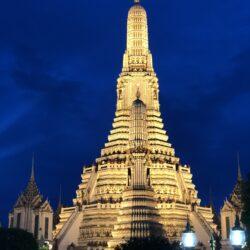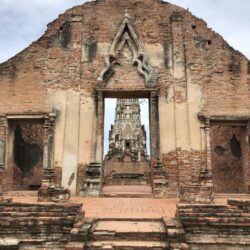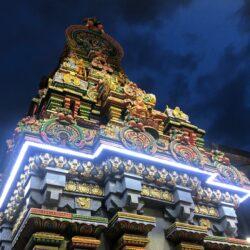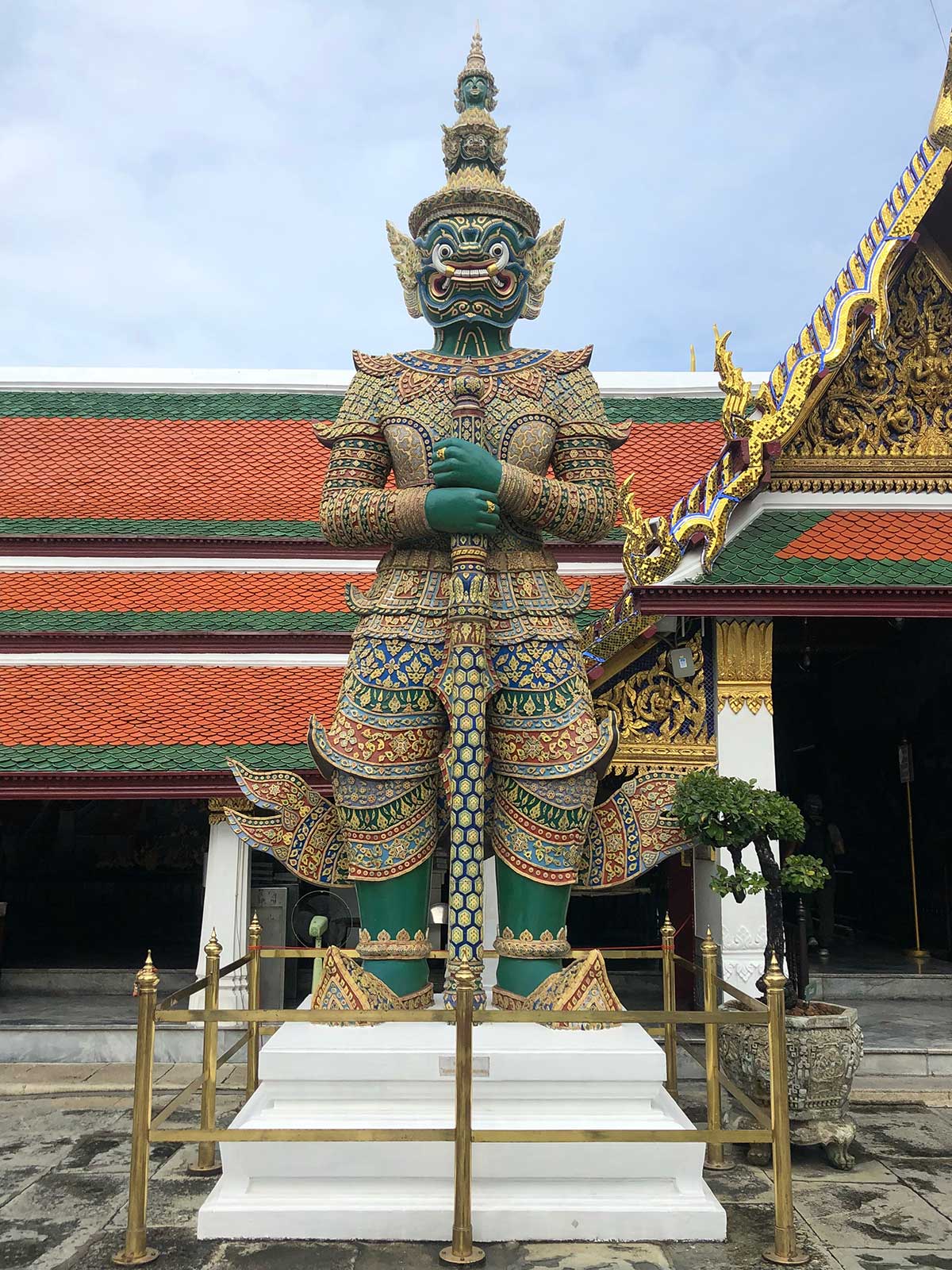
Bangkok is a thrilling destination and often acts as a visitor’s gateway to the region. The city is jam-packed with things to see, street food to eat and people to meet. The biggest complaint you hear about Bangkok is that its sheer size and hectic pace can overwhelm the senses and make tackling the city’s various offerings a daunting task. Don’t fall into this trap of worry; Bangkok is very traveler-friendly with a well-worn tourist infrastructure. The key is to divide the sights you want to see by neighborhood, and then simply concentrate on one of two neighborhoods everyday.
Ratanakosin
Three of Bangkok’s most-visited sites can be found on Ratanakosin, a small island surrounded by the Chao Phraya River on the west and a series of conjoined, manmade canals on the east. Before Bangkok, Thailand’s capital was located in Ayutthaya, about 80km (50 miles) north of the city. In 1767, the Burmese and the Thai battled in Ayutthaya and the ancient city was left in ruins. The capital was moved down river to Bangkok and the royal palace was built on the Chao Phraya’s west bank, in the Thonburi neighborhood. Realizing the palace grounds had no room to grow, Rama I transplanted the royal court across the river to Ratanakosin, where he built a fortified city within a city on the floating island.
Today, walking the streets of Ratakosin may have you thinking you time jumped back to 19th-Century European. Several of the governmental ministries are housed in pastel-painted Western-style edifices. Bangkok is both a modern and ancient city, but one thing I didn’t quite expect was…Vienna?
Saranrom Palace
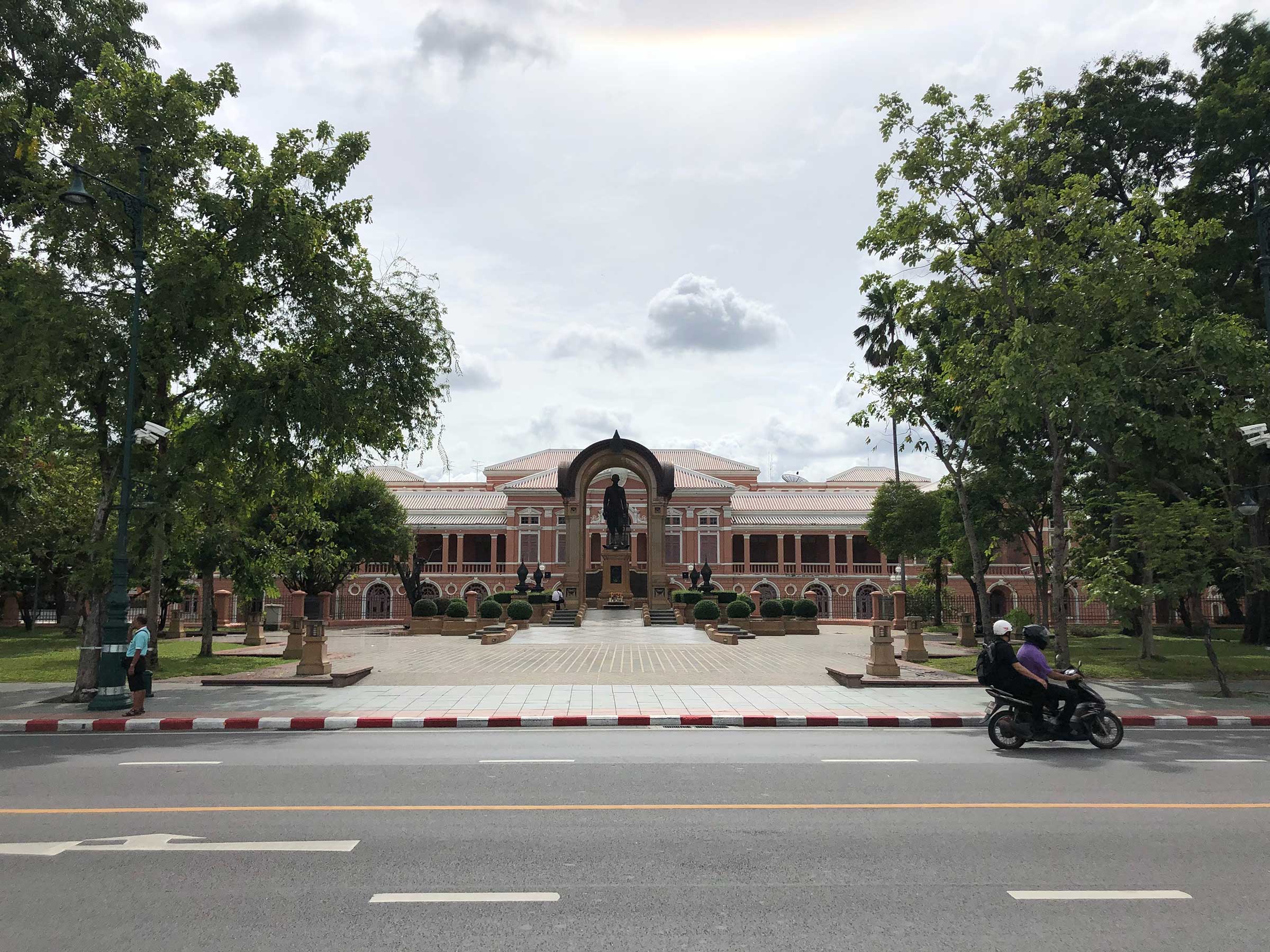
This pink palace was built for Rama IV, whose statue graces the front courtyard, in 1866 by British architect Henry Alabaster. It now contains the Ministry of Foreign Affairs.
Ministry of Defense
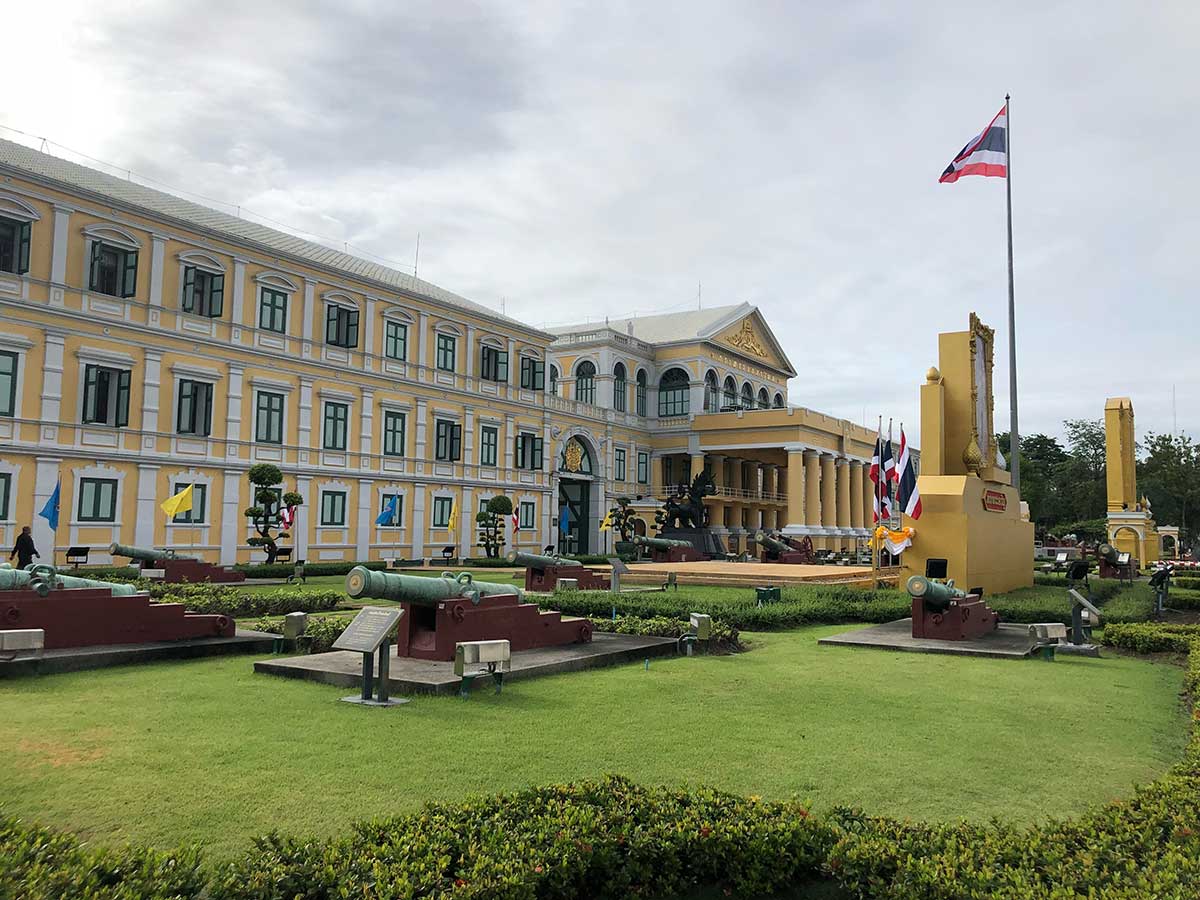
This yellow wedding cake of a building was built by an Italian, Joachim Grassi, in the Neo-Palladian style around 1882. On the front lawn is the so-called Cannon Museum, which is about as exciting as it looks. Still, I had come to Thailand pumped up to see, well, Thai architecture. Ratanakosin threw me for a bit of a loop at first.
Luckily I was about to get my fill of traditional architecture at the Grand Palace; incidentally, the royal family no longer lives in the Grand Palace, but several government agencies still operate their offices there. Nowadays the palace grounds are open to the public, including Wat Phra Kaew (The Temple of the Emerald Buddha), which houses Thailand’s most sacred Buddha icon. Right behind the Grand Palace is Wat Pho, Bangkok’s oldest temple, and not far from that is the National Museum. Rather than reinvent the traveler’s wheel, devote your first day in the city to exploring the island and these three sights.
The Grand Palace
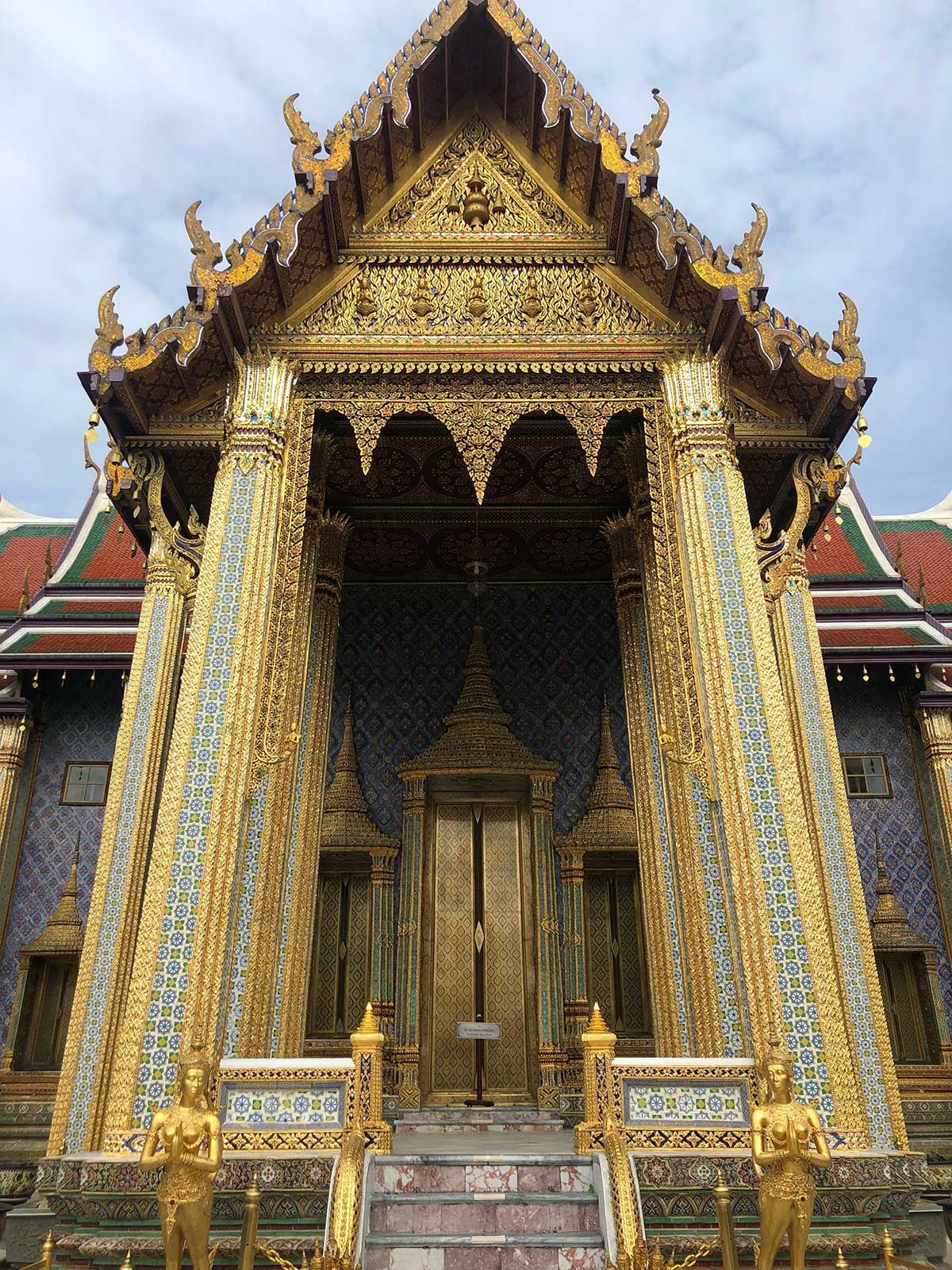
The Grand Palace receives eight million visitors each year, or roughly 20,000 visitors per day. (Of course numbers will be higher in the dry season and lower in the rainy season, but no matter the time of the year, this is a popular destination.) The four outer walls of the palace are 1900m (6233ft) long; contained inside are 35 points of interest that you can visit on a self-guided tour. Because of its size, plan on spending two to three hours walking around.
The grounds open to visitors at 8:30, which is fairly early as far as global attractions of this scale go. Whether most people are unaware of the opening hours or simply don’t want to drag themselves out of bed at this time on vacation, your best bet to beat the crowds is to arrive around 8:00 and join the queue. There’s a large park to the east of the palace where you will need to undergo a security check, show some ID (passport) and buy your ticket. After completing these tasks, you will be permitted to cross the street and enter the palace complex. By getting there early, I had my ticket in hand by 8:30 and I was one of only about forty people who were waiting to enter when they opened the gates. Most people end up fighting thousands of other visitors for photos and space; I felt like I had rented out the Grand Palace for a private party. Incredible!
Wat Phra Kaew (The Temple of the Emerald Buddha)
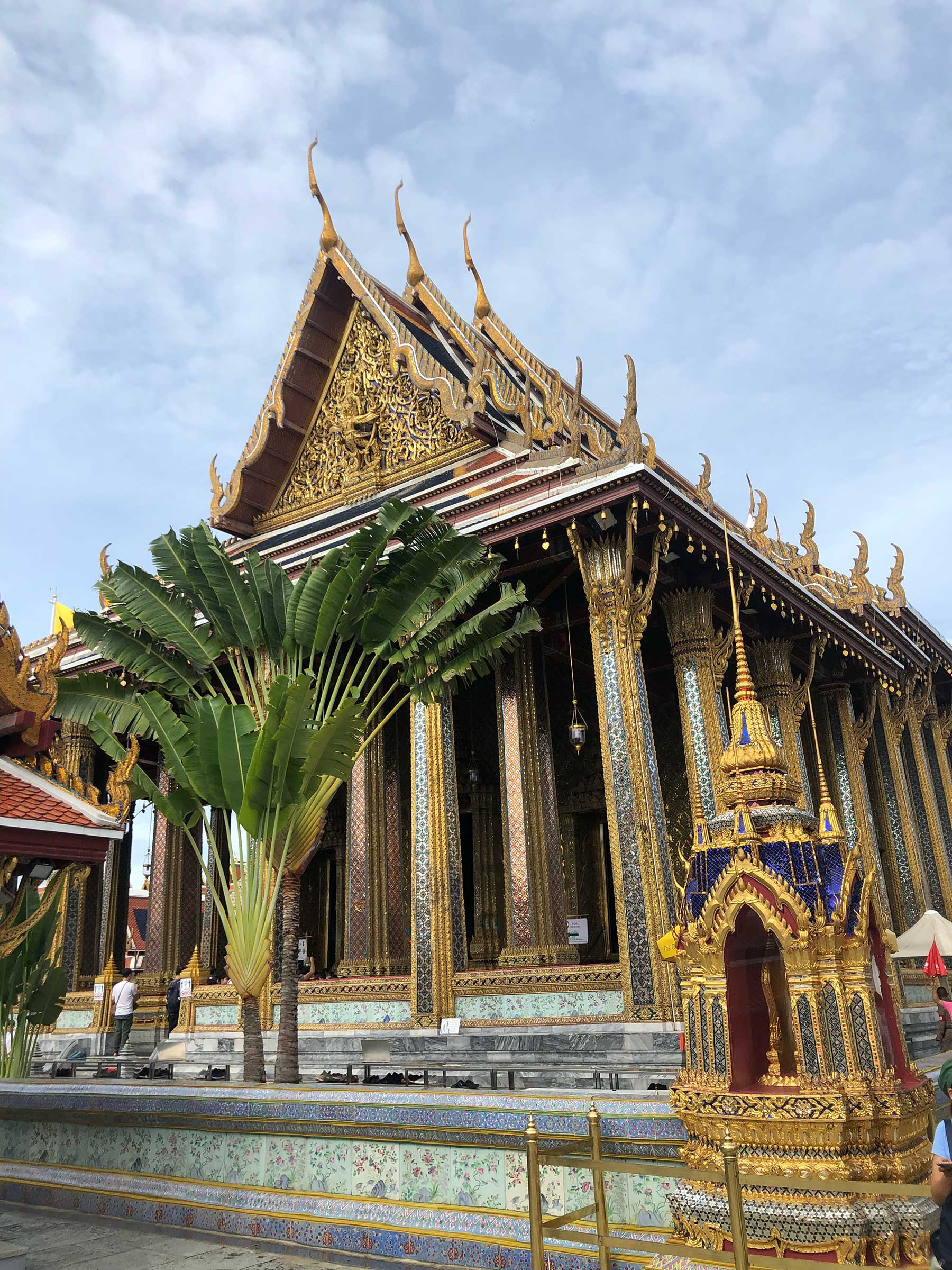
The Grand Palace is divided into several sections, the most famous of which is Wat Phra Kaew (The Temple of the Emerald Buddha), with its centerpiece being Phra Ubosoth (The Chapel of the Emerald Buddha). You can feel free to snap photos anywhere along the paths of the Grand Palace, except for inside Phra Ubosoth.
The Emerald Buddha is Thailand’s holiest Buddha. It’s exact origins are unknown, but it was most likely crafted in the 14th Century and was housed in a northern region of the country for many years. During a war with Laos, the statue was stolen and kept in Vientiane for almost two hundred years before Rama I recaptured the sacred Buddha and brought it to Bangkok. Each Thai king, all of whom conveniently take the name of “Rama” upon coronation, has added his own buildings and personally touches to the Grand Palace; creating a secure resting place for the Emerald Buddha topped Rama I’s to-do list.
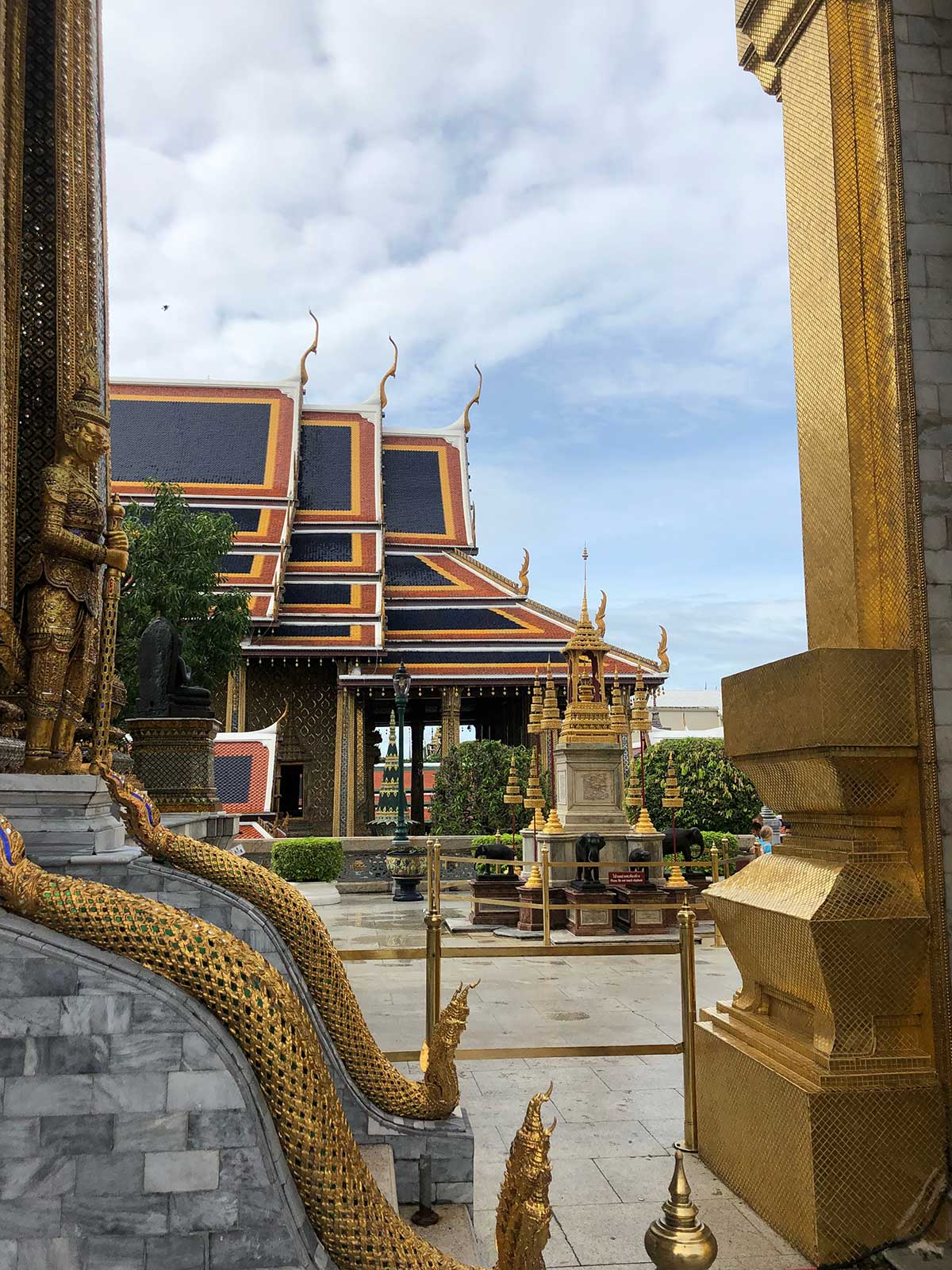
Despite it’s name, the Emerald Buddha is carved from a slab of jade, and not emerald. The Buddha is also very small, standing at only 66cm (26in). Compared to all the grandeur of the Grand Palace, the Emerald Buddha feels swallowed by its surroundings. The statue has three different golden outfits, one for each season, which the king (currently Rama X) personally changes.
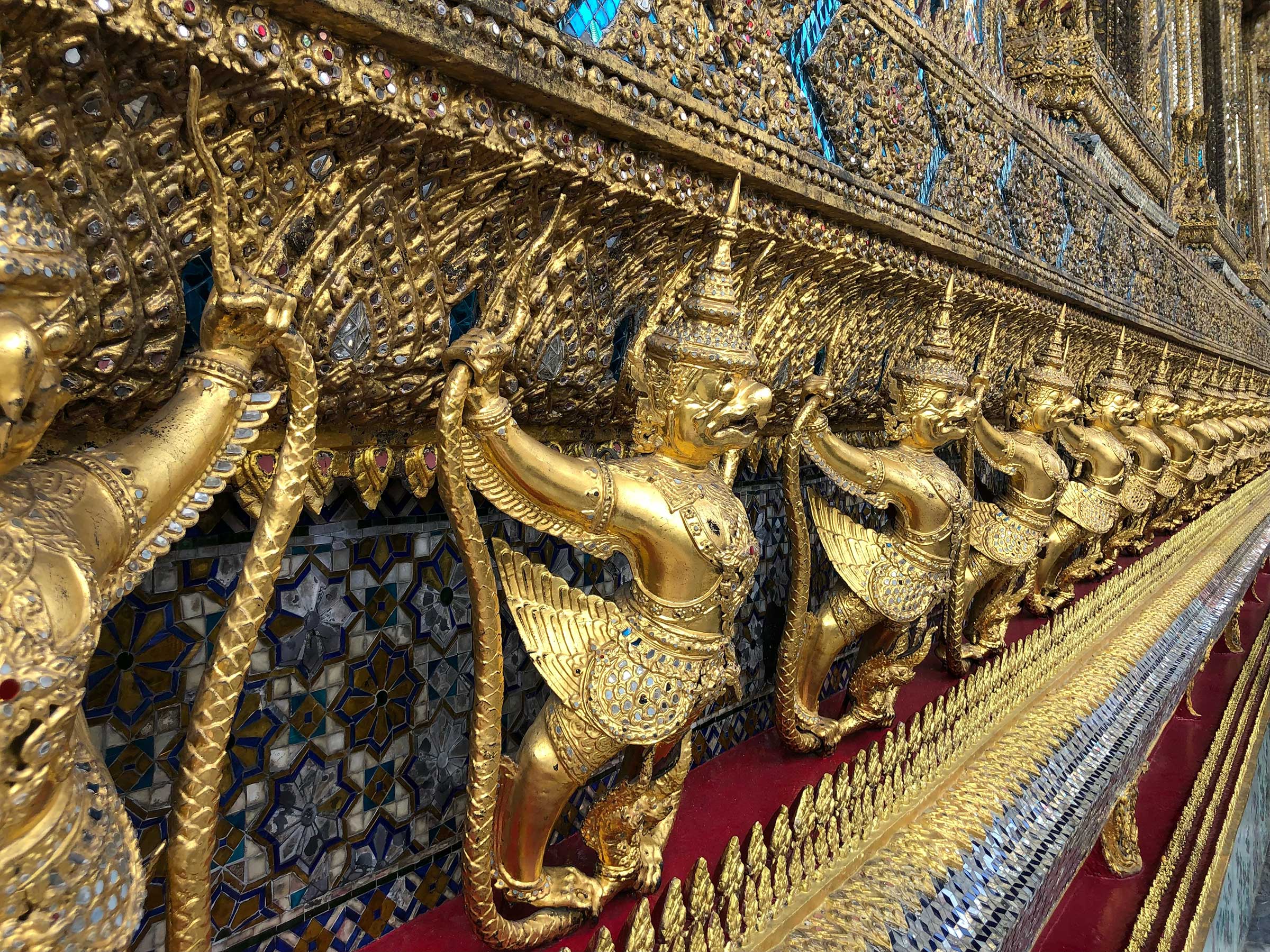
Around the base of the chapel you will find 112 Garuda, or bird kings, holding Naga, mythical snakes, in each hand. The artistic renderings of the images and characters found throughout the Grand Palace have their roots in Hindu and Buddhist texts that were popular during the reign of Rama I.
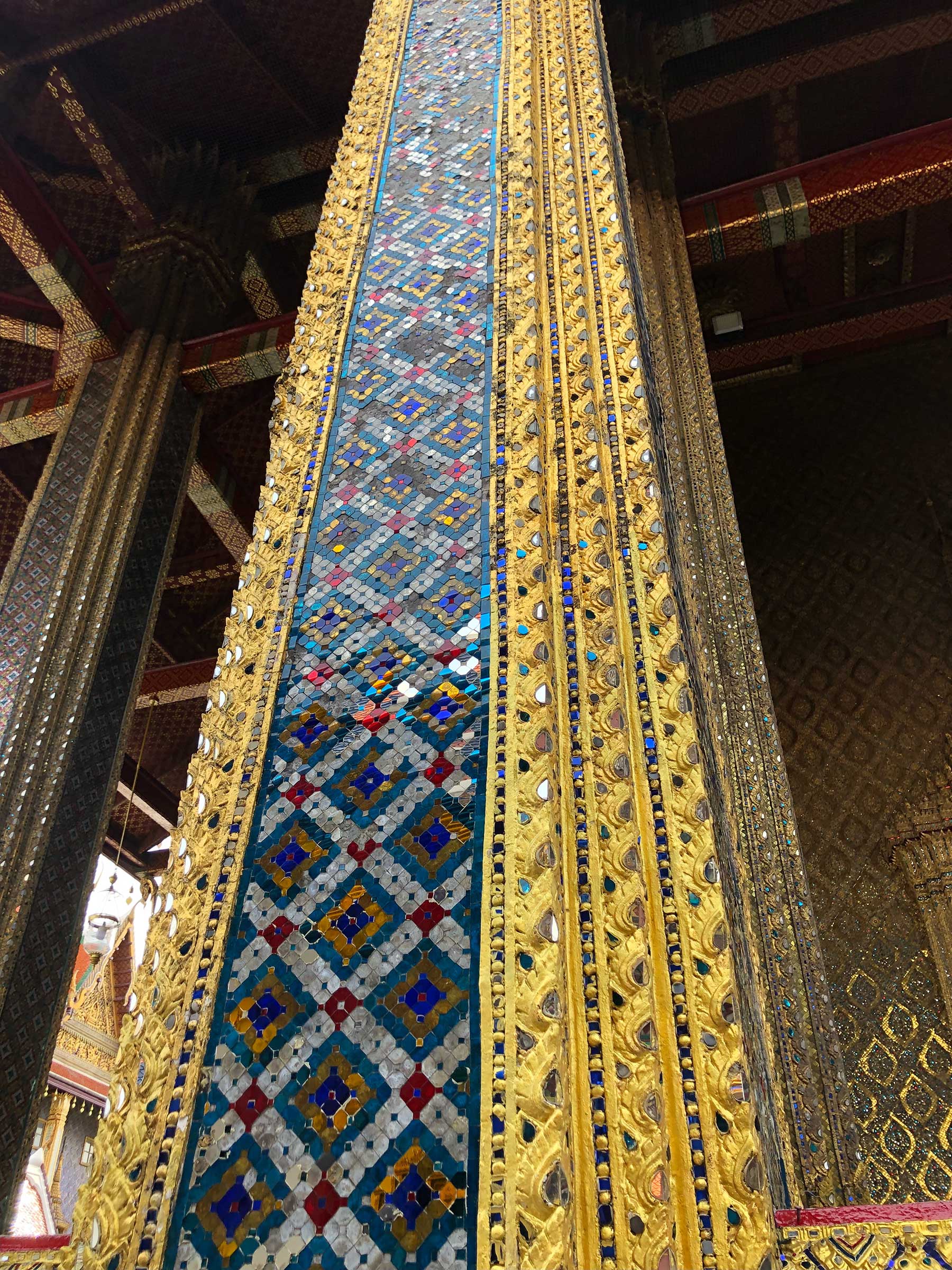
The facade of Phra Ubosoth is made up of Mother-of-Pearl and blue, yellow and orange-glazed tiles. The chapel- and it is a chapel, and not a temple, as there are no living quarters for monks on the premises- was built in the newly-minted Ratanakosin architectural style. This combined the classic temple designs employed in Ayutthaya, the former capital, with influences from China and the West.
Yaksha (Demon Guardians)
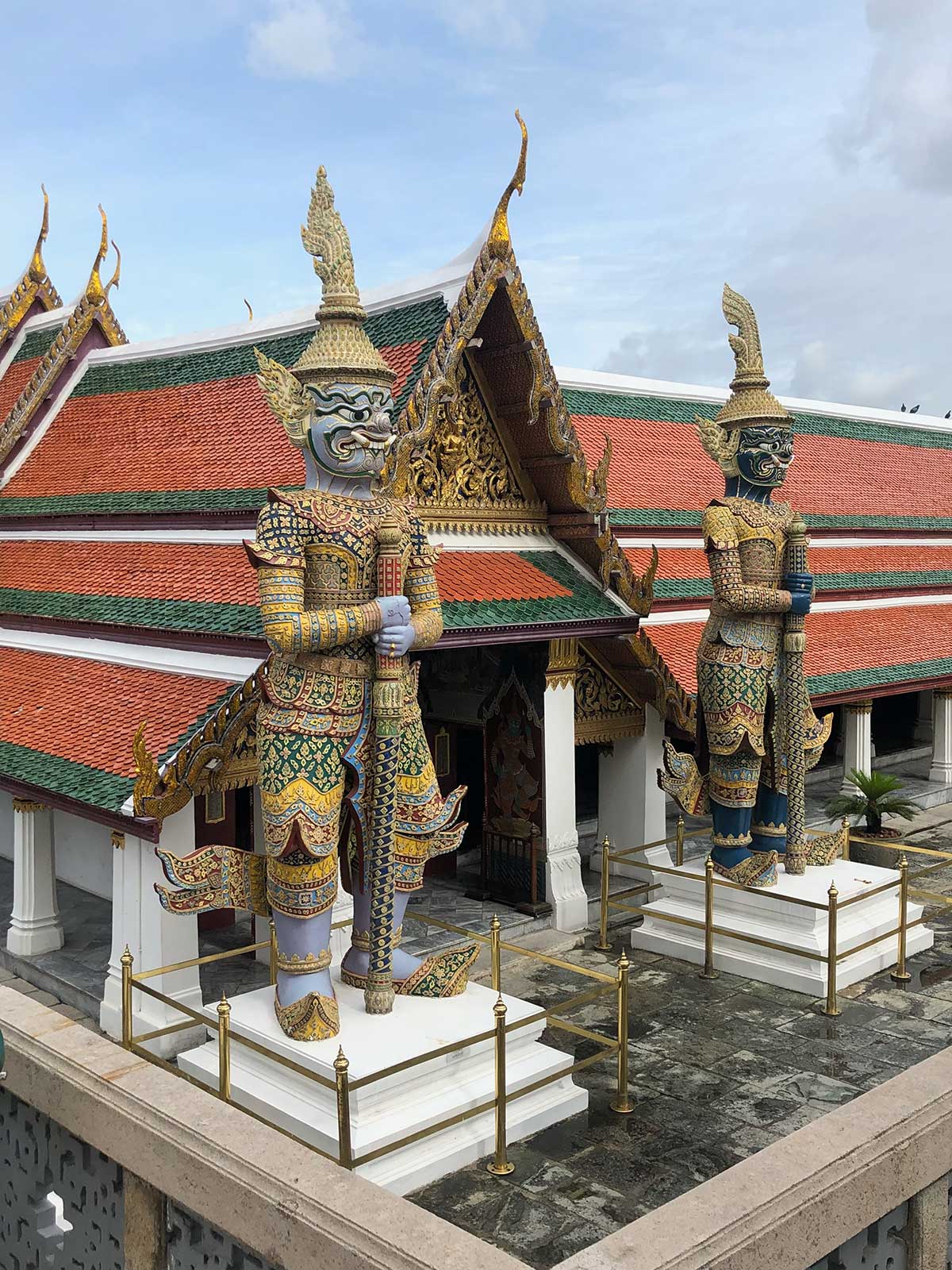
There are six sets of Yaksha in the Grand Palace, guarding all six of the entrances to Wat Phra Kaew. These figures from the Ramakien epic were installed to ward off evil spirits and to protect the Emerald Buddha. They were constructed during the reign of Rama III and stand 5m (16ft) tall.
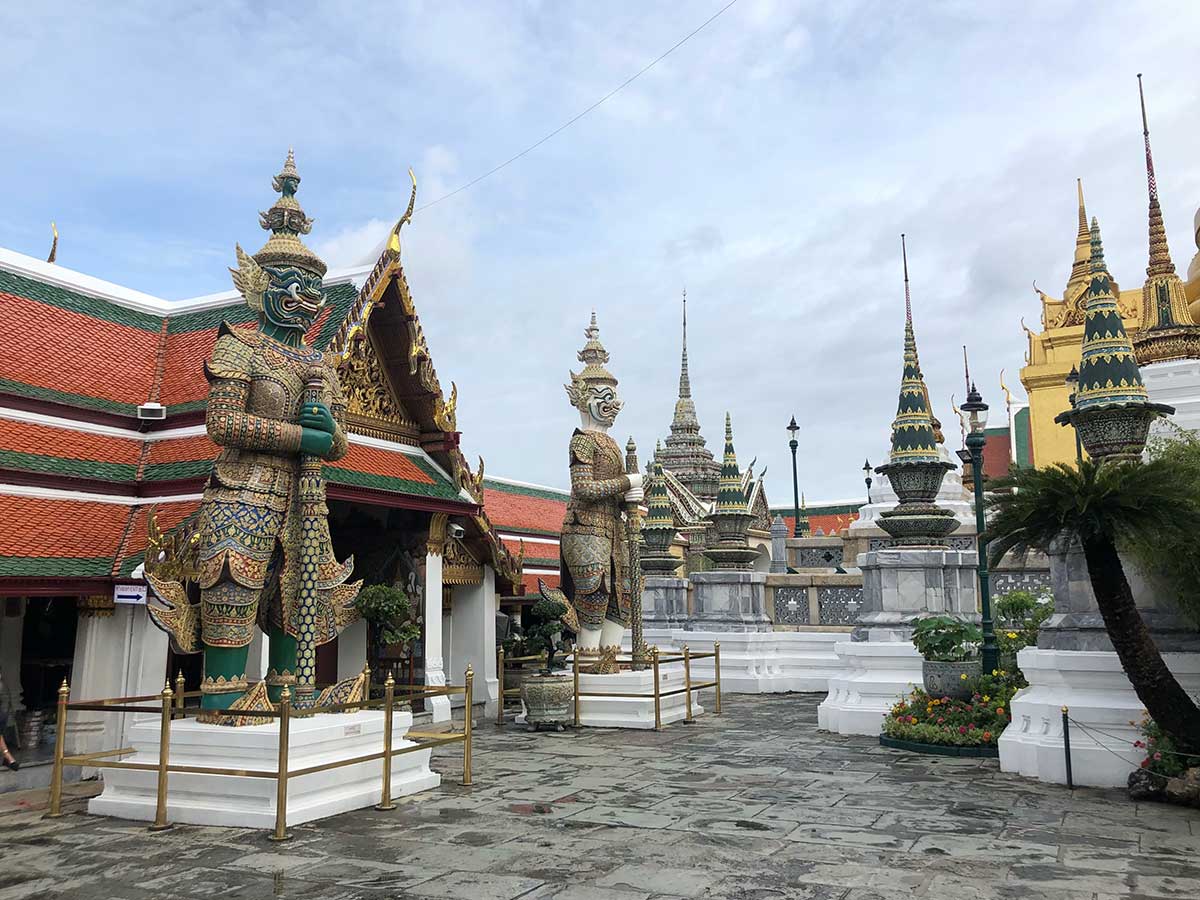
Phra Siratanana Chedi
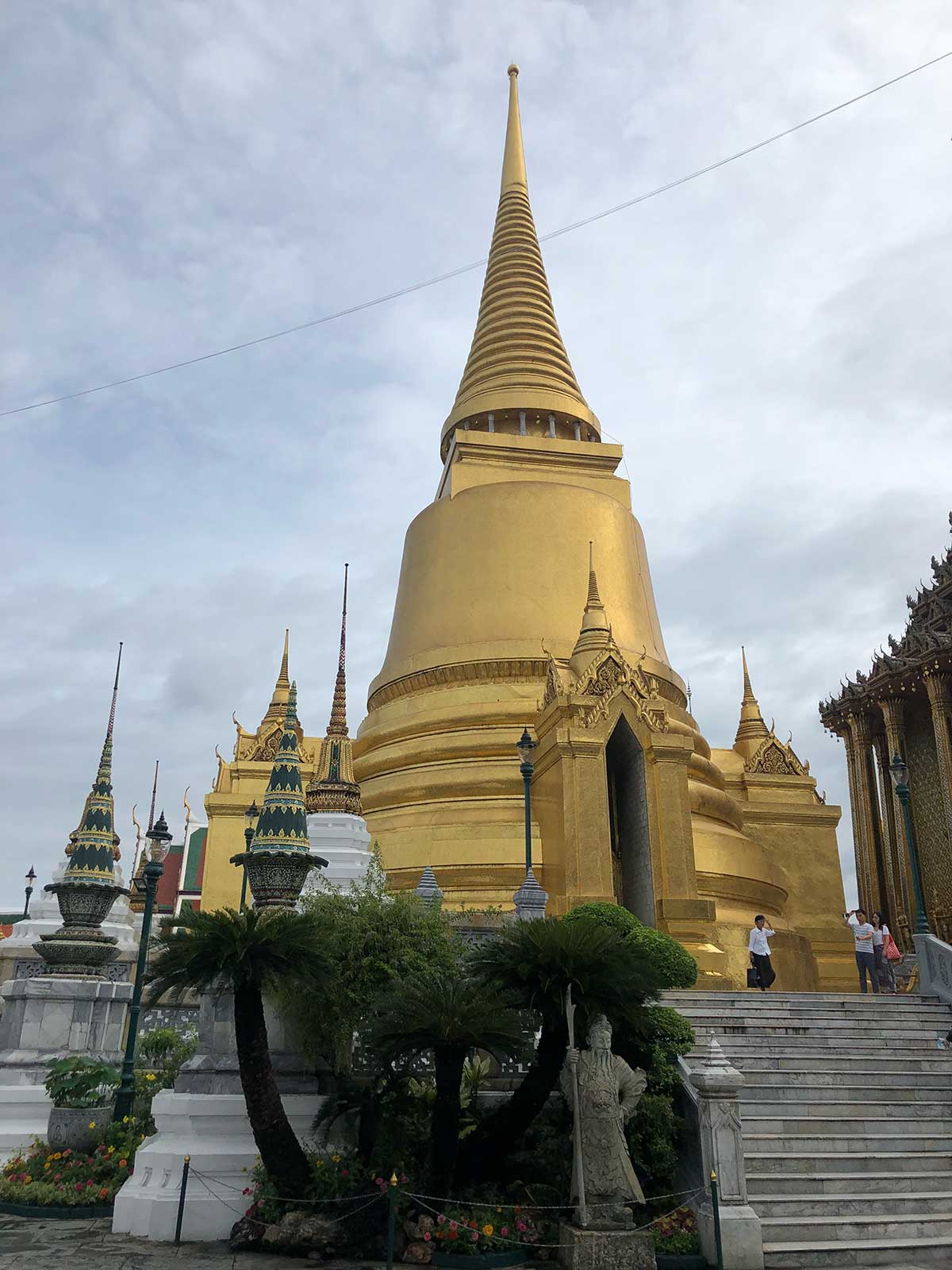
This golden chedi, the tallest structure on the grounds, was added to the Grand Palace by Rama IV in 1855. From far away, the structure appears to be painted in gold, but in reality the effect is created by tiny golden mosaic tiles that were imported from Italy. You won’t see many buildings like this in Thailand; the bell-shaped stupa is modeled after the Ceylonese styles from the time. You can extrapolate a lot of history just by walking through the Grand Palace and observing what buildings were added by each king. Rama IV obviously had a relationship with the British (Sri Lanka, then Ceylon, was a Crown Colony at the time) and indeed, his Thai nickname translates to “The Father of Science and Technology” due to of his efforts to bring European tech to his people. Phra Siratana Chedi today houses relics of the Buddha; the interior is closed to the public.
Phra Mondop (Buddhist Library)
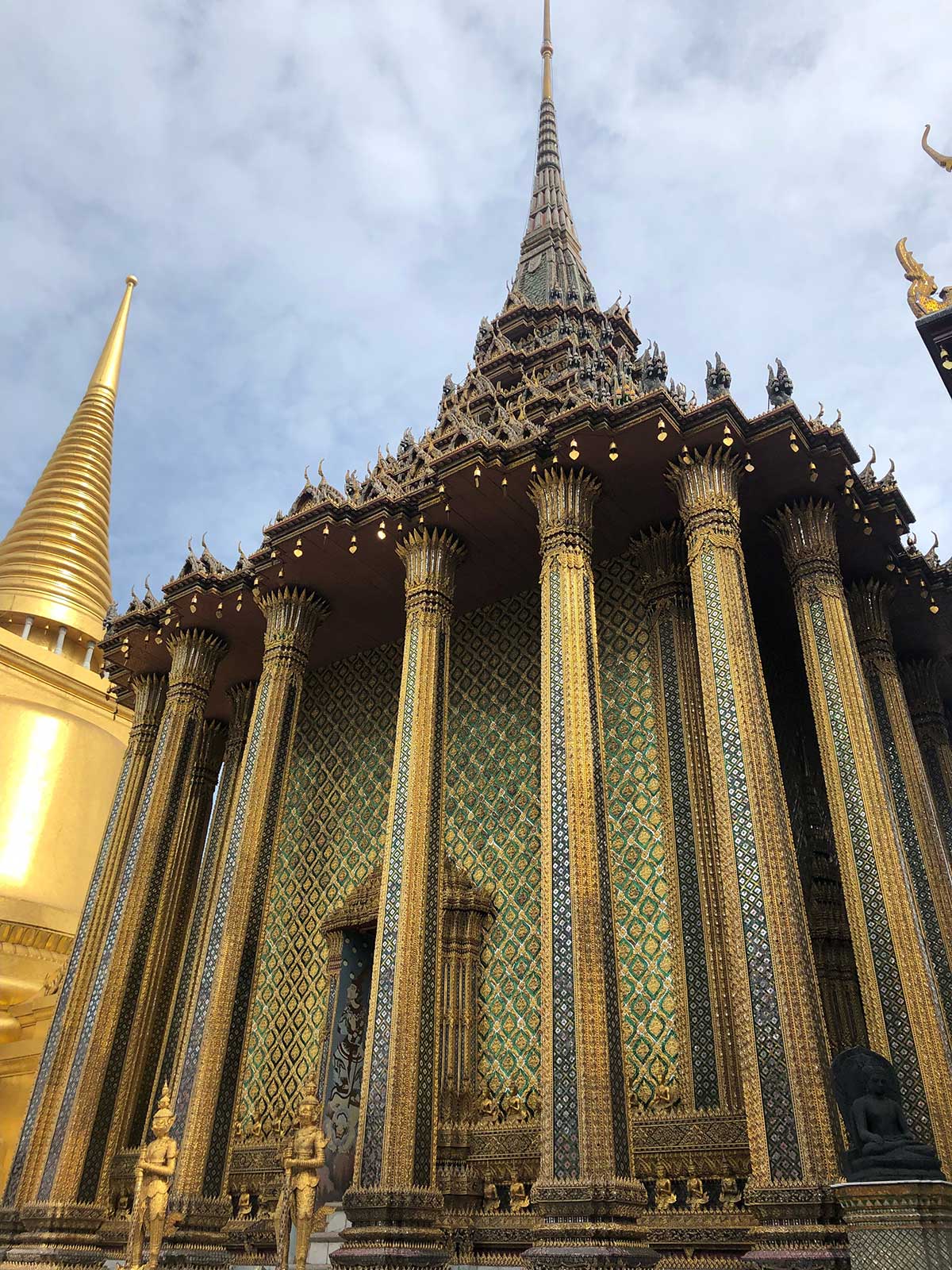
Phra Mondop was built by Rama I in 1789 to house the Tripitaka, a collection of sacred Buddhist texts. (This Thai Tripitaka, translated by monks at the time, contains 84,000 chapters of Buddhist teachings.) The first attempt at building a library on this spot was a wooden building, suspended over a pool of water by columns and planks. The fear was that termites could invade the building and destroy the Tripitaka in the process. The wooden structure caught on fire and burned to the ground (luckily the Tripitaka had not already been placed inside) and this new mondop-style building sprung up in its place.
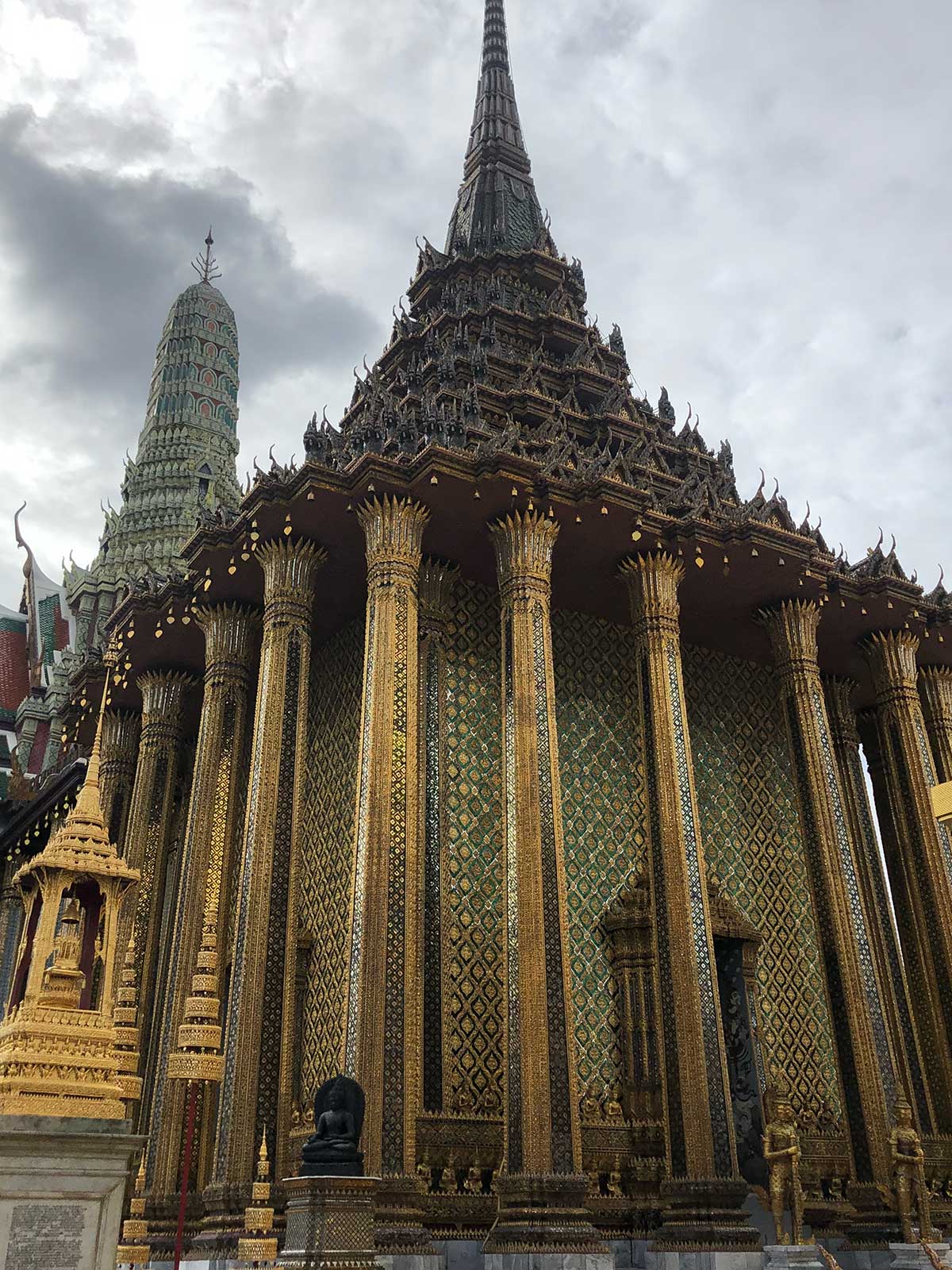
Mondop is a Thai architectural style mostly found in religious buildings. The dimensions of the walls form a perfect square, creating only one room inside. The most distinctive feature of the mondop style is the roof, which is designed like a tiered pyramid, with a slender spire placed on top. Along the eave of the roof you can see bodhi leaf-shaped wind chimes.
Throughout the years, different kings would make tweaks and alterations to the buildings of the Grand Palace as they saw fit. Rama IV lowered the spire of Phra Mondop so it would not be taller than his own contribution, Phra Siratana Chedi, and Rama V added the four black Buddha statues you can see on each corner of the library. This Buddhas were carved from volcanic stone in the Javanese style (likely in the 14th Century) and were given to Rama V by the Governor of Java on a state visit.
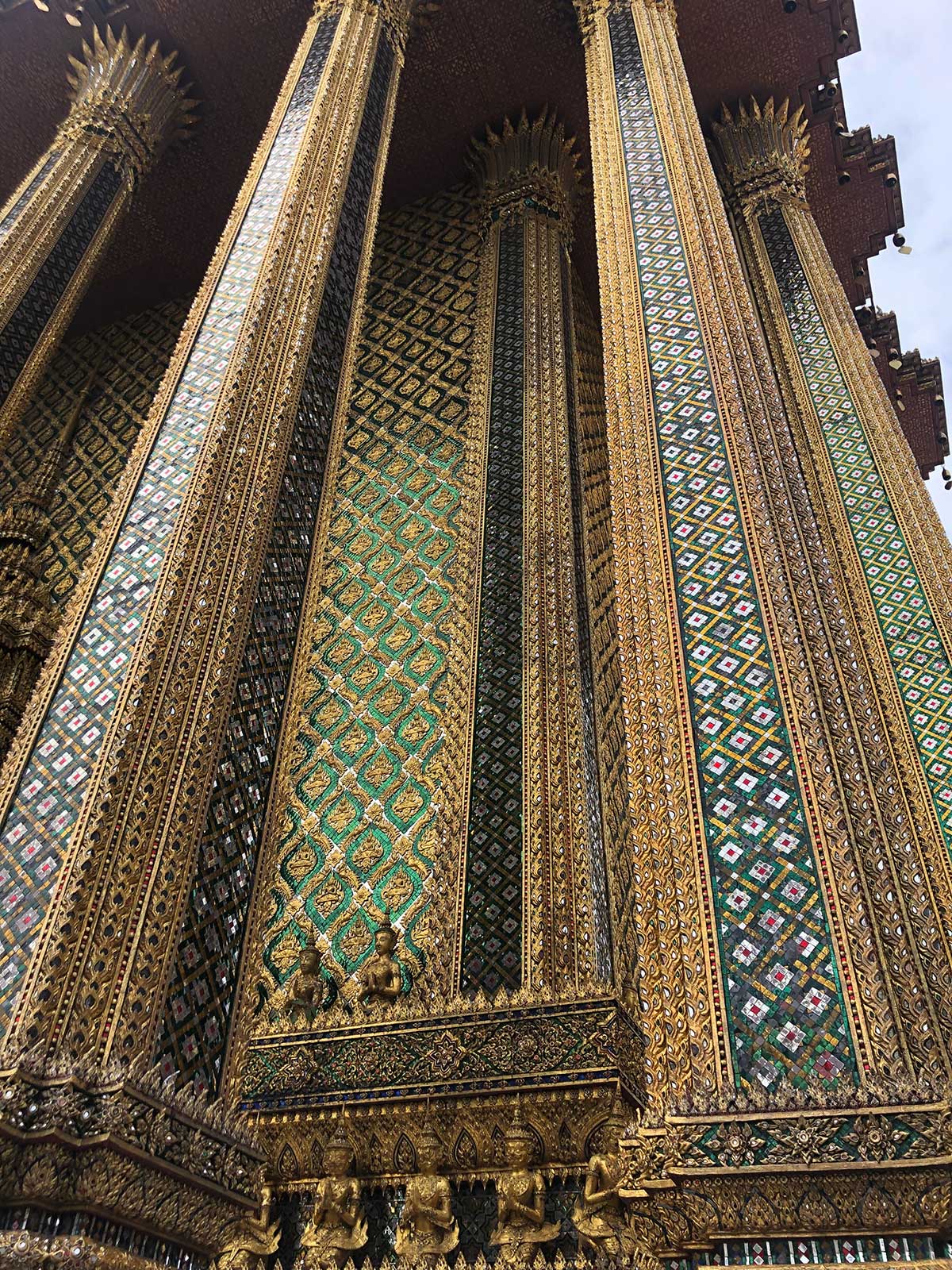
The craftsmanship of these buildings is as amazing in closeup as it is from afar. The twenty columns that encase the library are layered with bits of white, green and red glass. Against the green background you can see the Thephanom, a brother and sister pair of angels who came down to earth when the Buddha reached enlightenment. They guarded the Buddha and his religious scrolls; here they guard the Tripitaka inside.
Prasat Phra Thep Bidon (The Royal Pantheon)
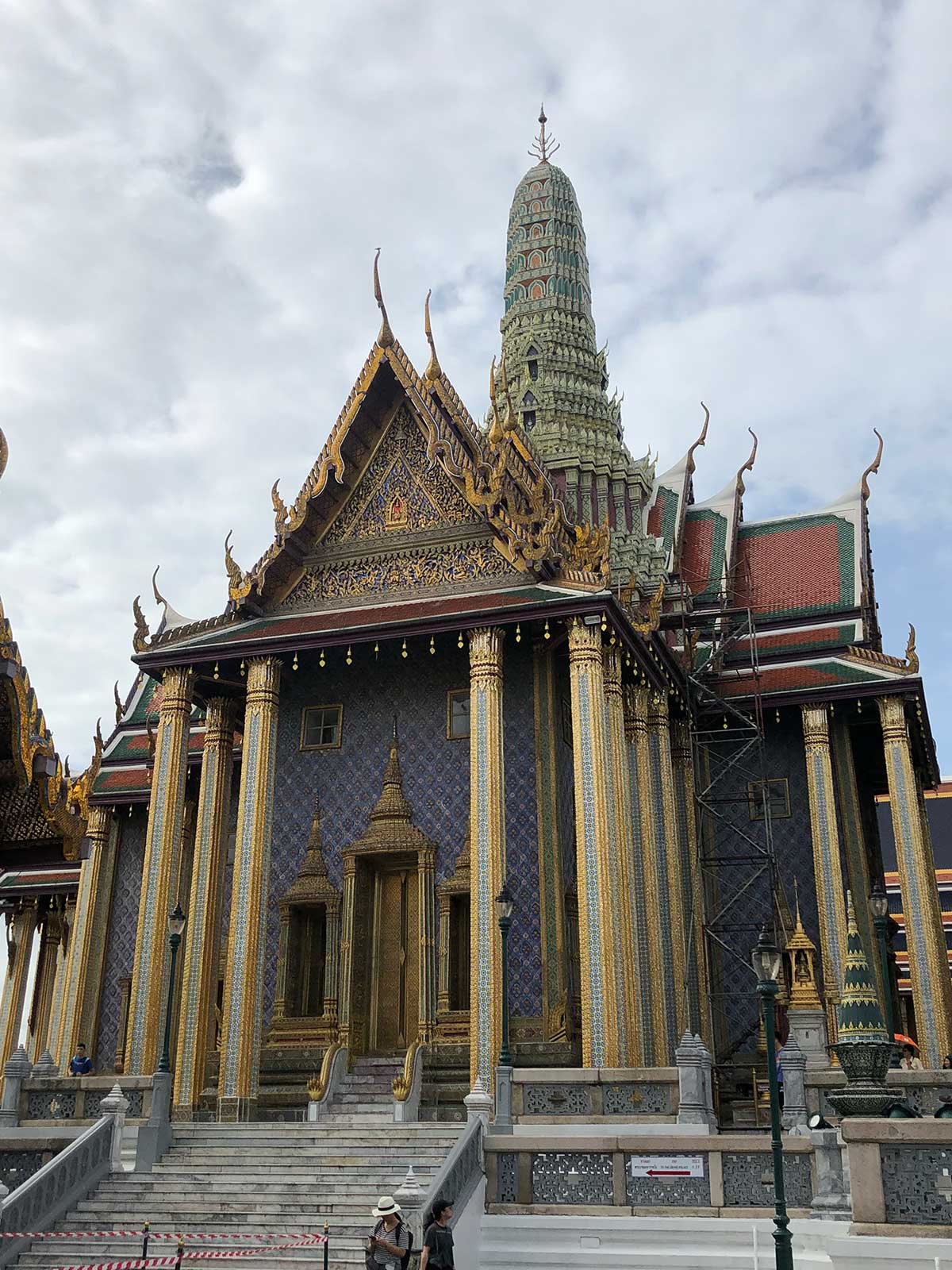
Before we delve into The Royal Pantheon, I want to give a disclaimer about transcriptions of the Thai language into Roman letters. Remember that this building above is really called ปราสาทพระเทพบิดร and that Prasat Phra Thep Bidon is simply a phonetic representation of words to help Westerners pronounce them. As such, you will find that the transcriptions of words will not always match from source to source. (One guidebook refers to The Royal Pantheon as Prasat Phra Dhepbidorn, for example.) Unless you suddenly master the Thai alphabet, you’ll have to make do with sorting through Thep Bidon vs Dhepbidorn and realizing they’re the same thing.
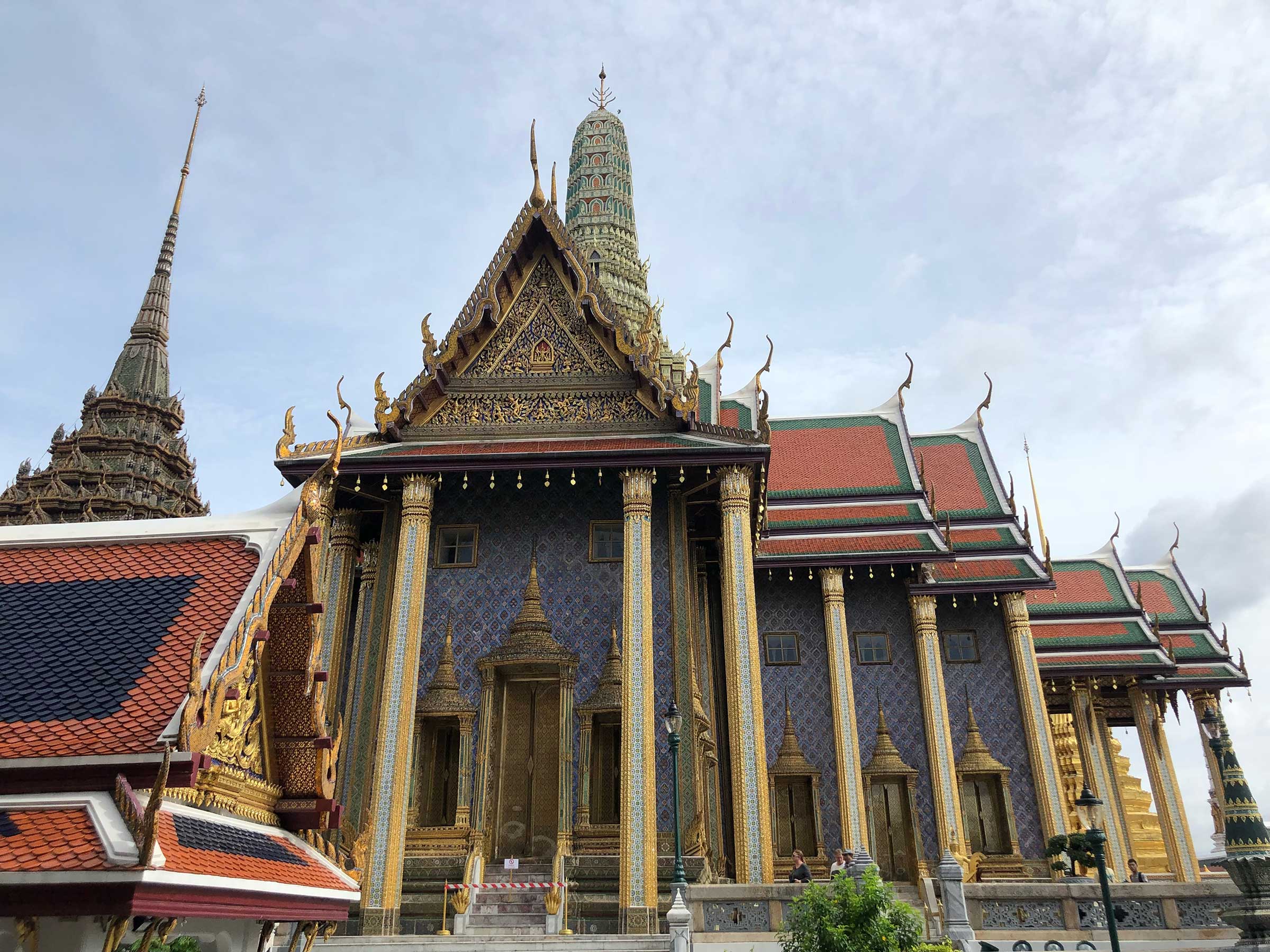
Prasat Phra Thep Bidon was built by Rama IV in 1856 as a new home for the Emerald Buddha. The building is a curious fusion of Thai and Khmer styles; the bulk of the structure is decidedly Ratanakosin, but the blue and orange-tiled Prang on top is straight out of the Cambodian architectural playbook. The word “Prasat” means center of the universe in Thai and is a subset of architecture reserved only for the highest of royalty or the Buddha.
Upon completion, the building was deemed too small to hold the ceremonies surrounding the Emerald Buddha and it sat empty until Rama VI transformed it into a pantheon that would honor all the kings from the Bangkok era. After each king dies, a full-size, lifelike statue is rendered and placed in the pantheon. Rama IX’s likeness was added to the shrine in 2020.
Phra Suvarnachedi
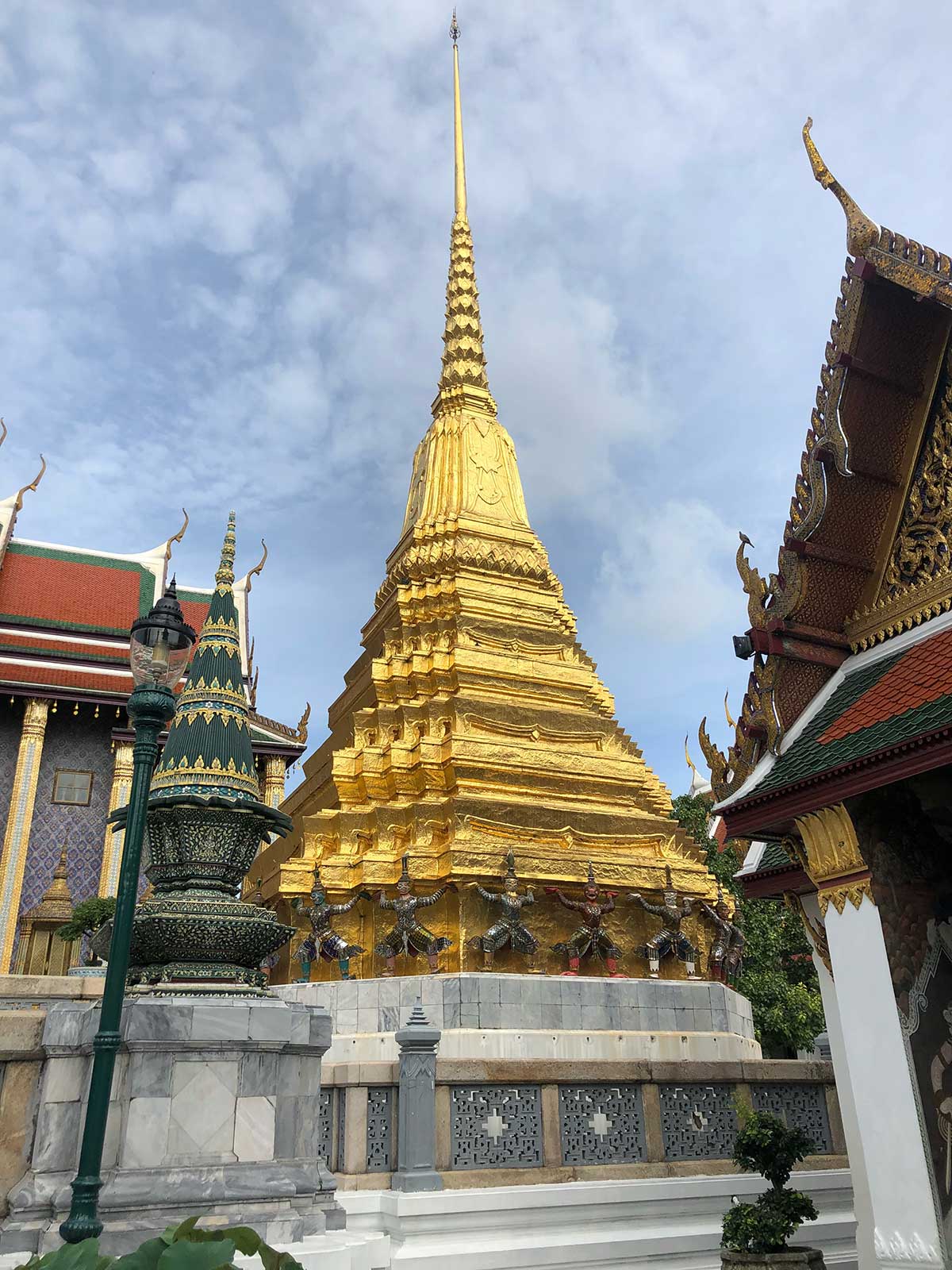
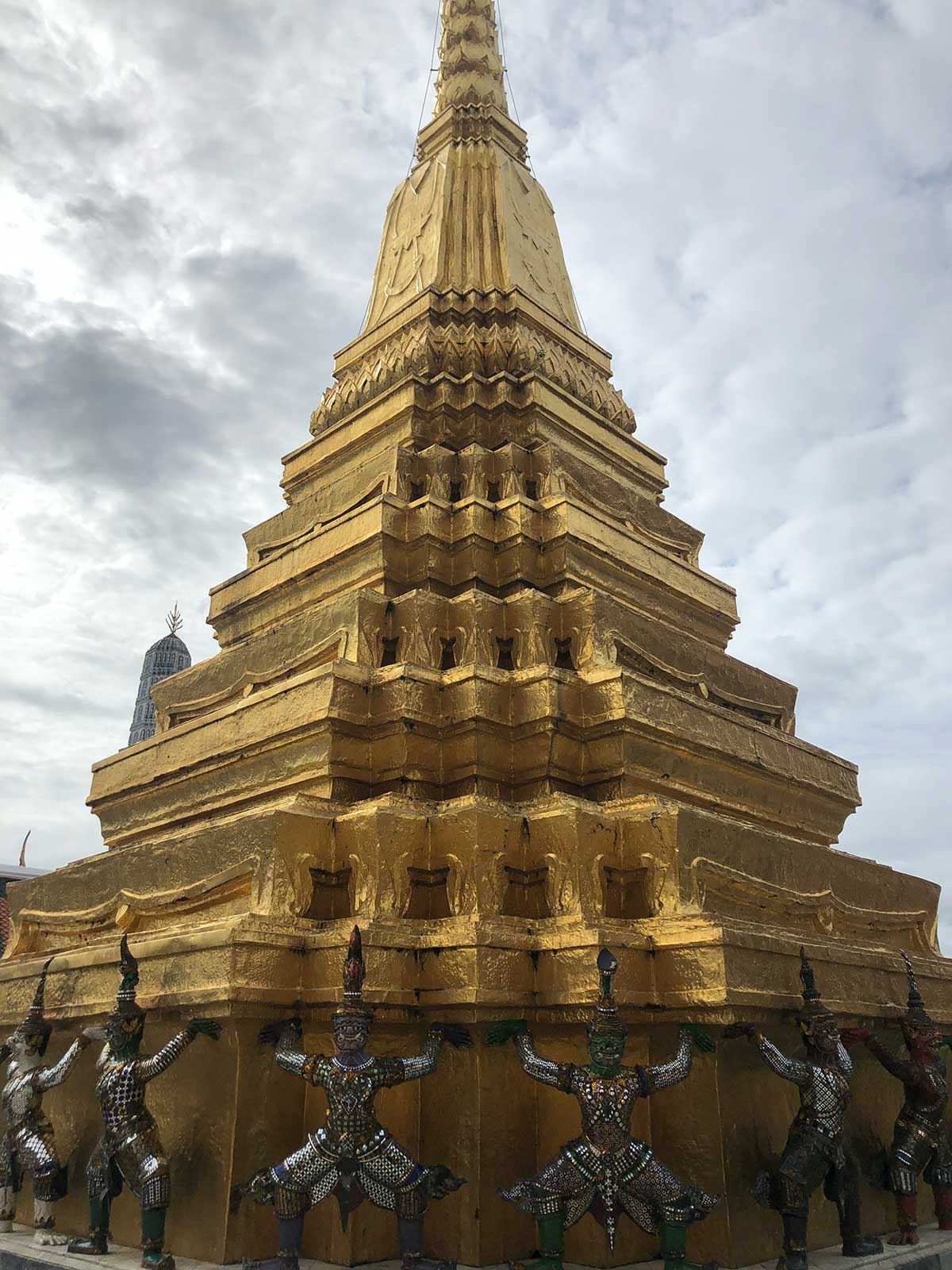
Flanking Prasat Phra Thep Bidon are two golden chedi, known as Phra Suvarnachedi. These were built by Rama I to honor his mother and father. They are octagonal in shape, the base measuring 8.5m (28ft) and the spire stretching 16m (52ft) into the air. (The motto of the Grand Palace seems to be “Bigger is Better!”) The chedi are covered in gold leaf, causing them to “glow” in the sunlight.
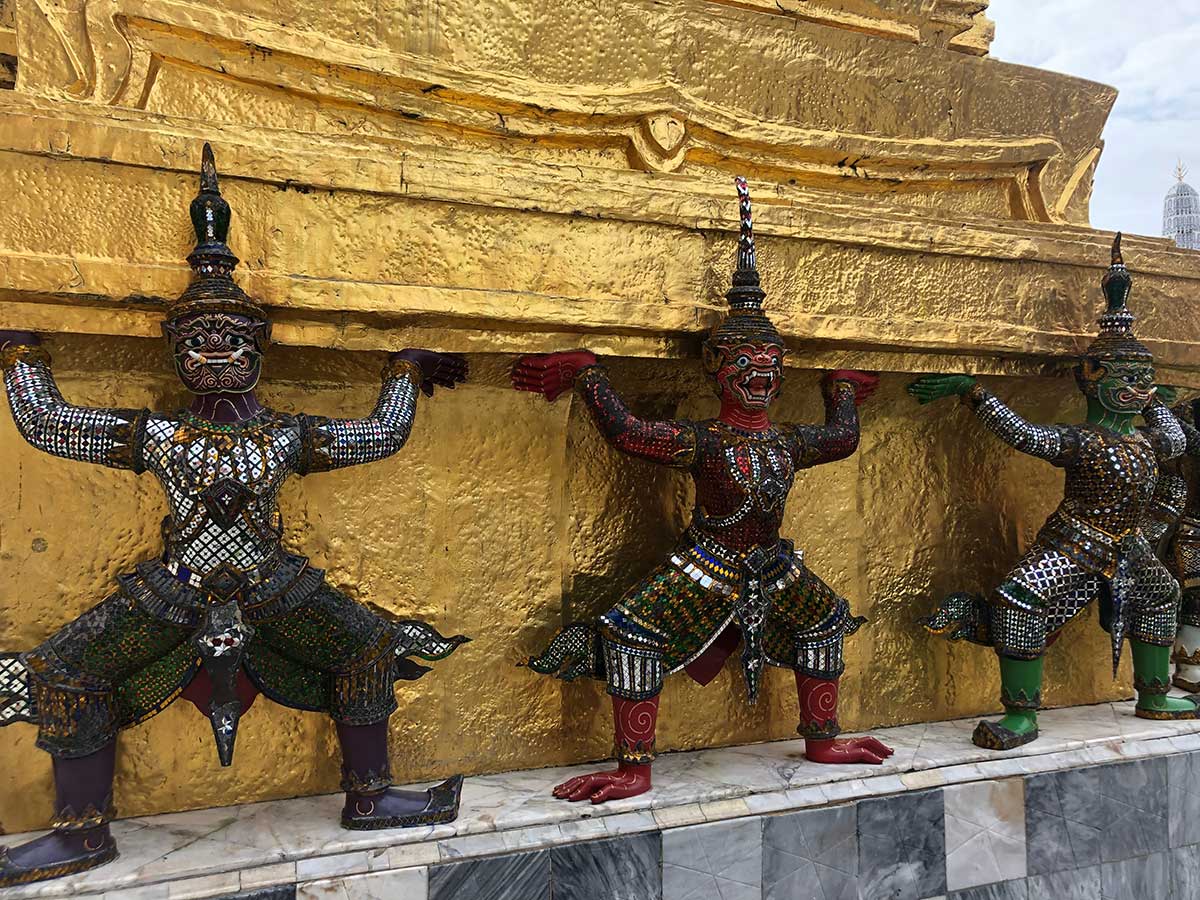
Rama I loved the Hindu epic, Ramakien, and the twenty figures around the base of each chedi are uniquely dressed as a different character from this tale. We may require an audio guide to explain who these various characters are, but at the time the stories from the Ramakien were well-known and visitors to the Grand Palace would have been easily been able to identify their favorite heroes and villains.
Model of Angkor Wat
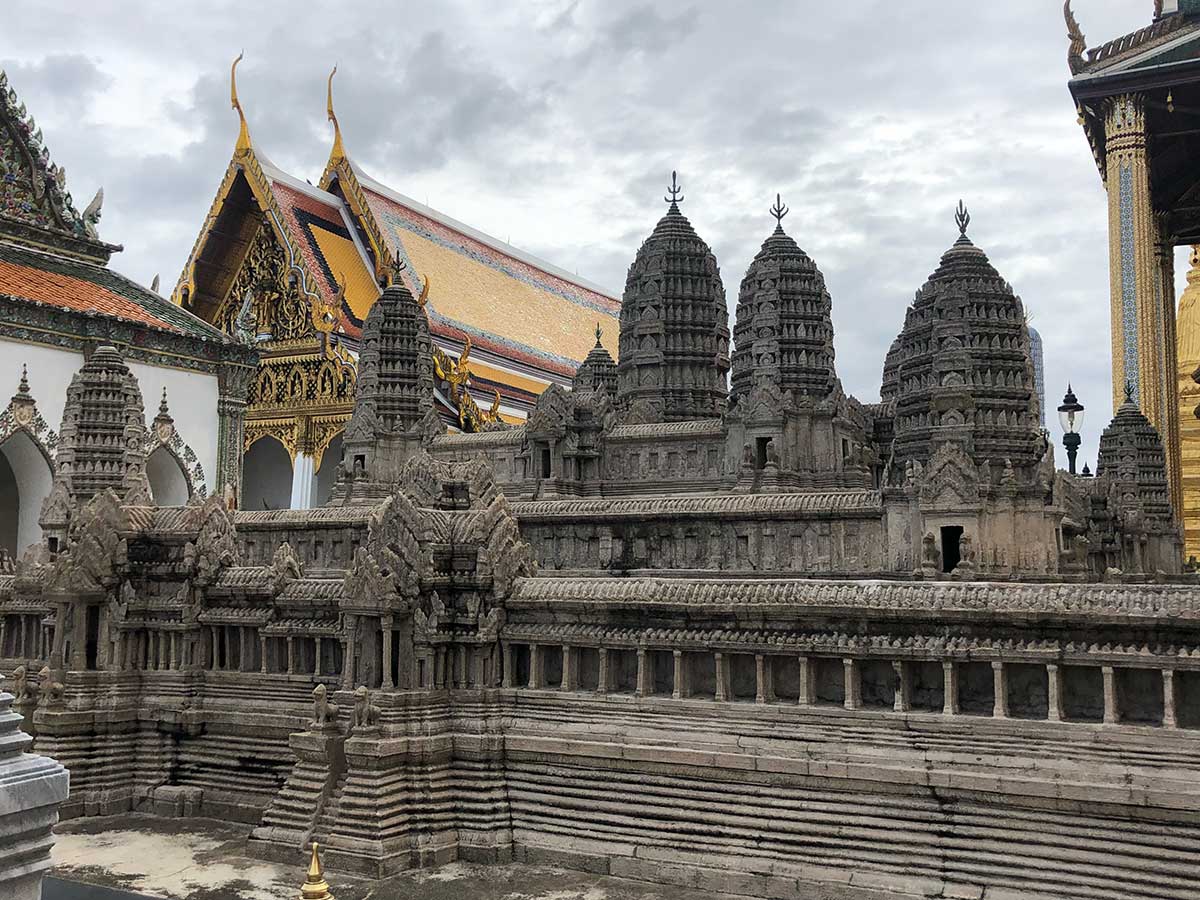
Angkor Wat, located near Siem Reap, Cambodia, holds the Guinness World Record for the being the largest religious structure in the world. For many years it had been considered lost, but it was “rediscovered” during Rama IV’s reign, at a time when that part of Cambodia was occupied by Thailand. Rama IV actually wanted to remove a piece of the temple(!) and install it at the Grand Palace, but this proved too difficult. He eventually relented and had this model of the holy site constructed instead.
Creatures from the Himavanta Forest
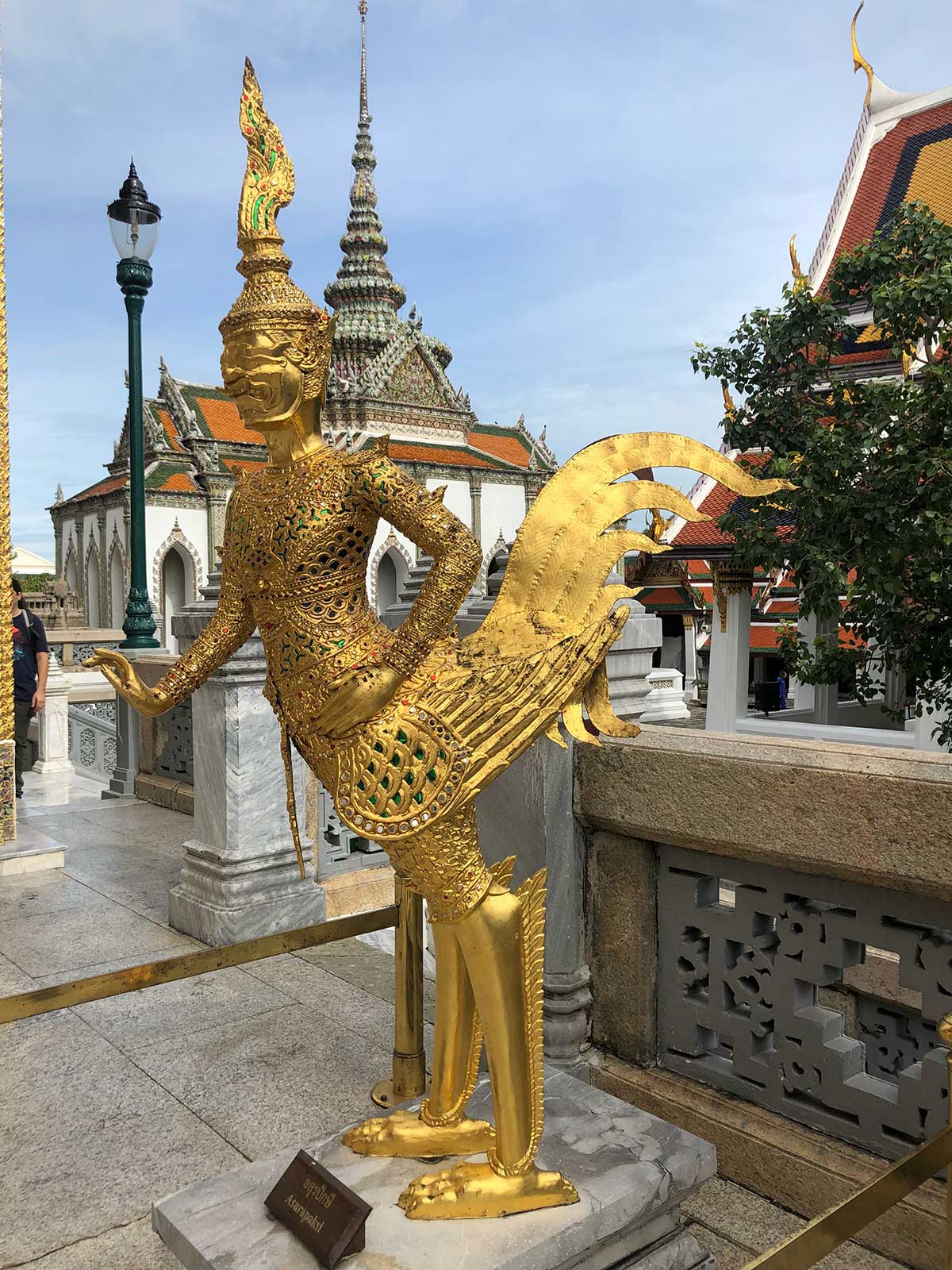
There are eight statues of mythological creatures from the equally mythological Himavanta Forest dotted around Wat Phra Kaew. The forest is said to be located at the base of the Himalayas and contains sacred trees and magical half-human, half-animal creatures. Asuarapaksi above is half-Yaksha and half-bird, while others have share their bodies with lions and monkeys. Below Asurawayuphak is holding a mace, ready to defend the area from evil.
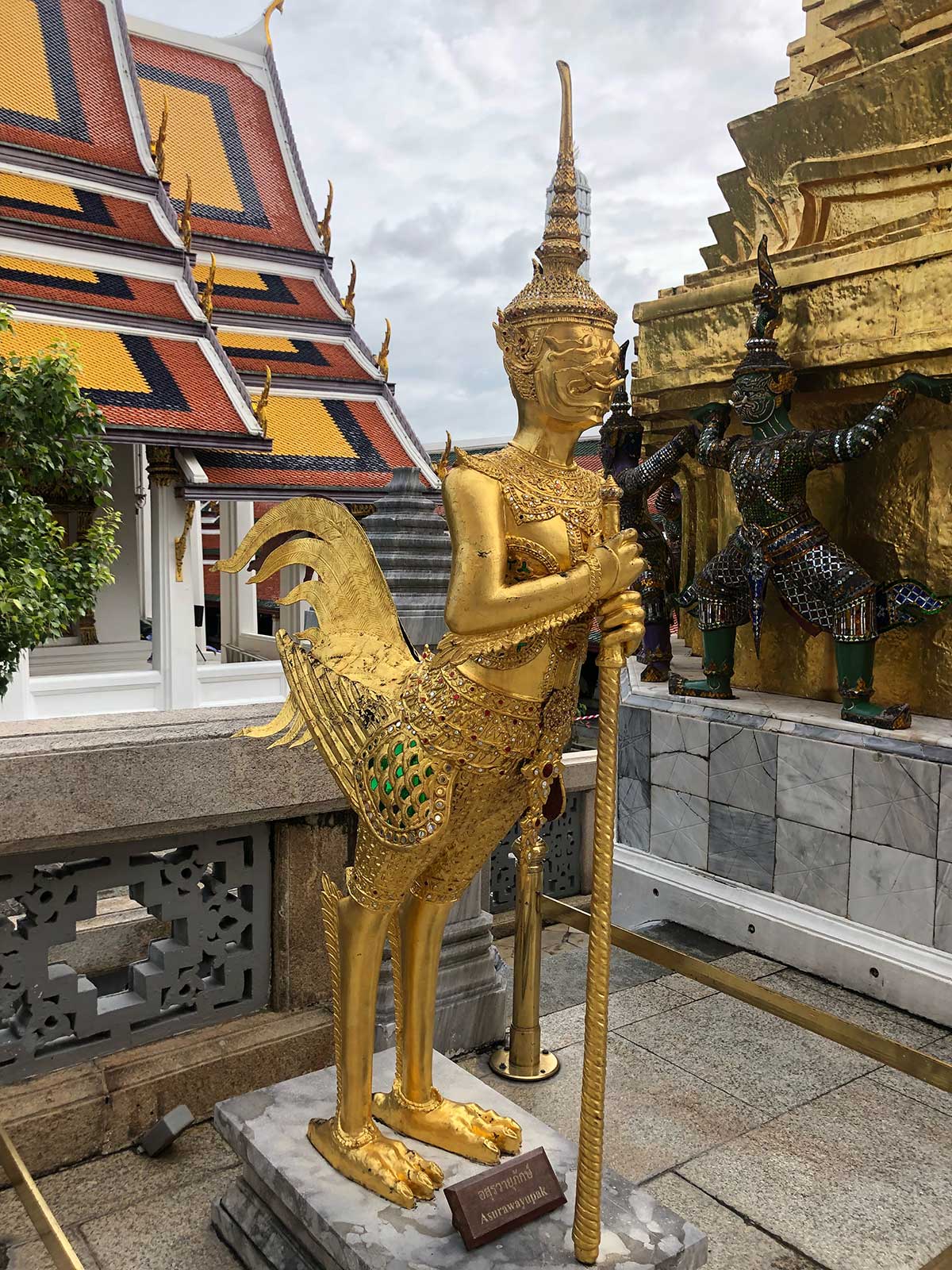
Phra Wihan Yot
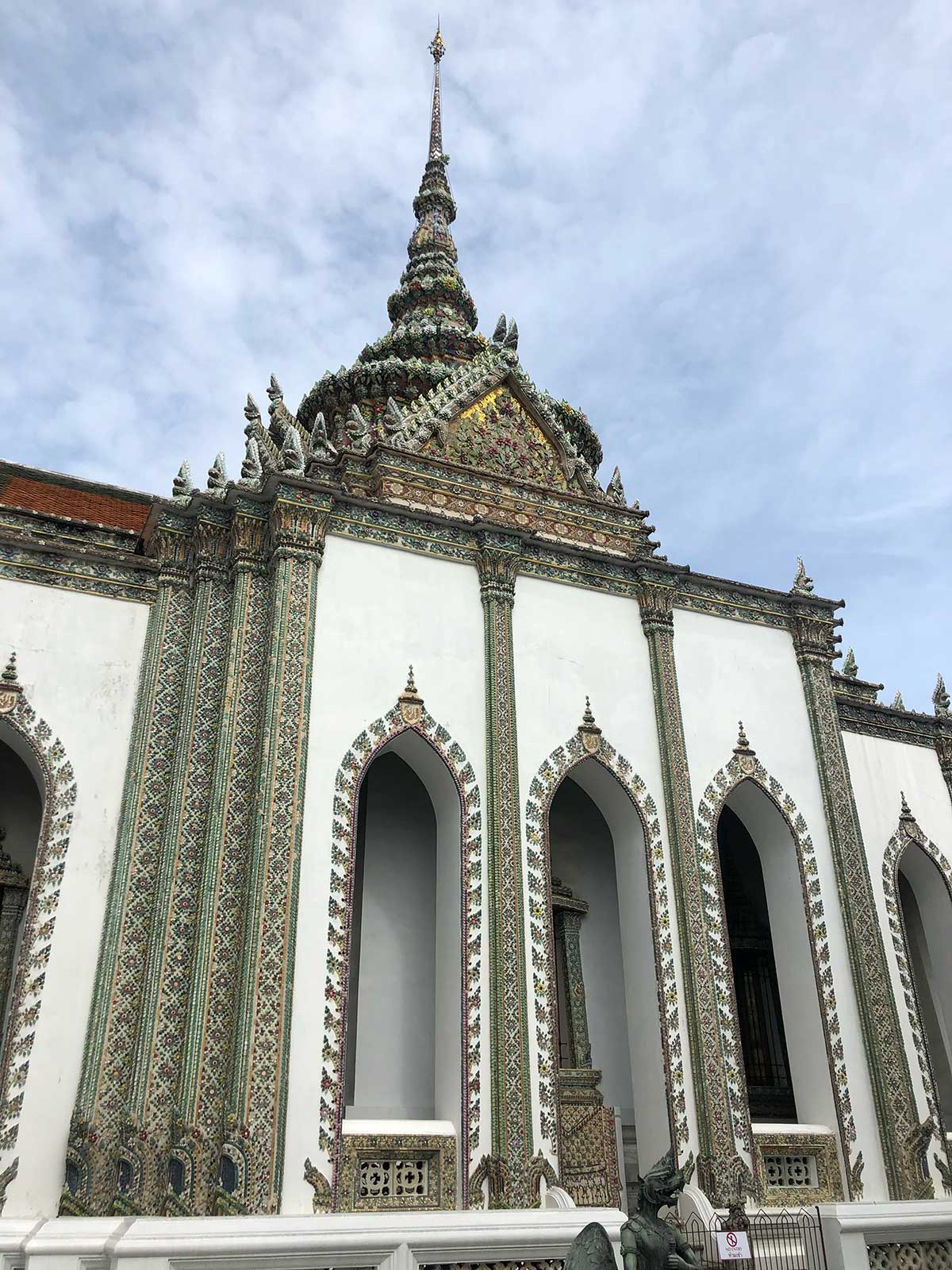
This chapel contains images of the Buddha and cannot be entered by visitors. The interesting feature of Phra Wihan Yot is the roof, which an enlarged replica of the crown worn by each Thai king. Here the crown is encrusted with bright porcelain tiles made in China.
Ho Rakhang (Bell Tower)
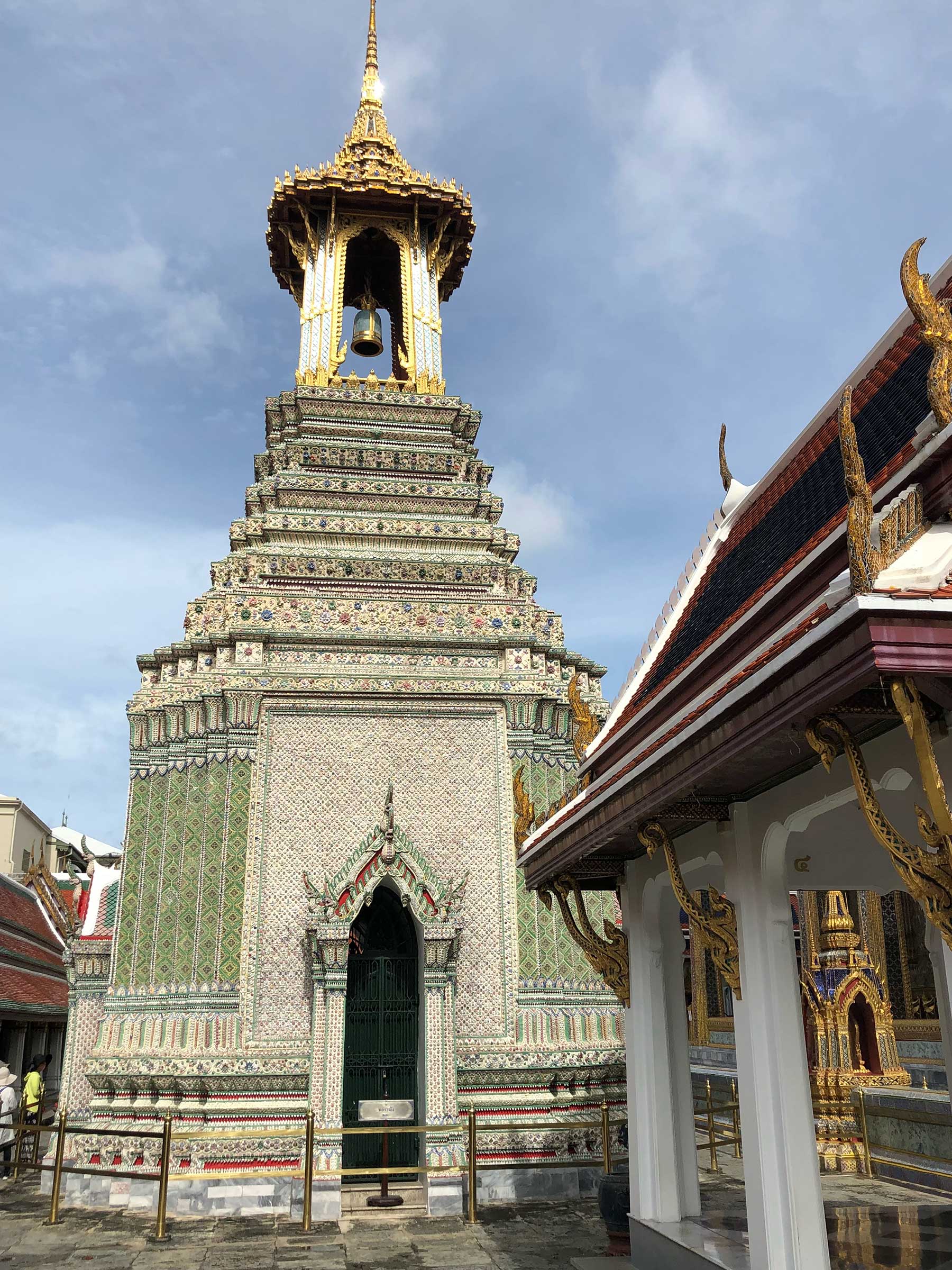
Ho Rakhang was commissioned by Rama IV in 1882 to mark the 100th anniversary of the capital city. The roof is designed in the mondop style and the bell is only rung when a new king has been appointed. The painstaking level of detail is overwhelming when you gaze at these structures up close. It’s one thing to say, “this bell tower is covered in tiny porcelain tiles,” and another to witness it with your own eyes.
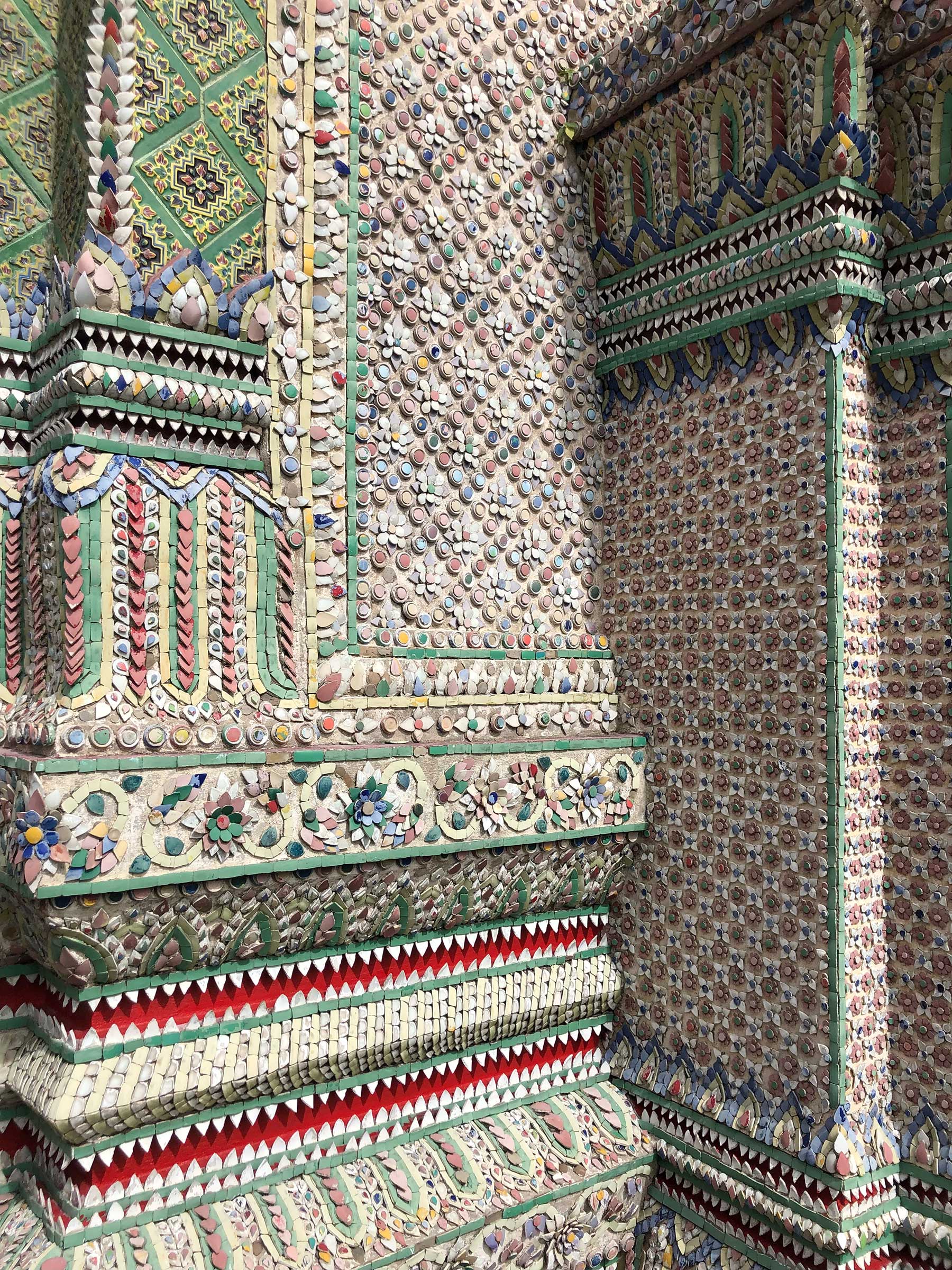
Ho Phra Monthiantham (Auxiliary Library)
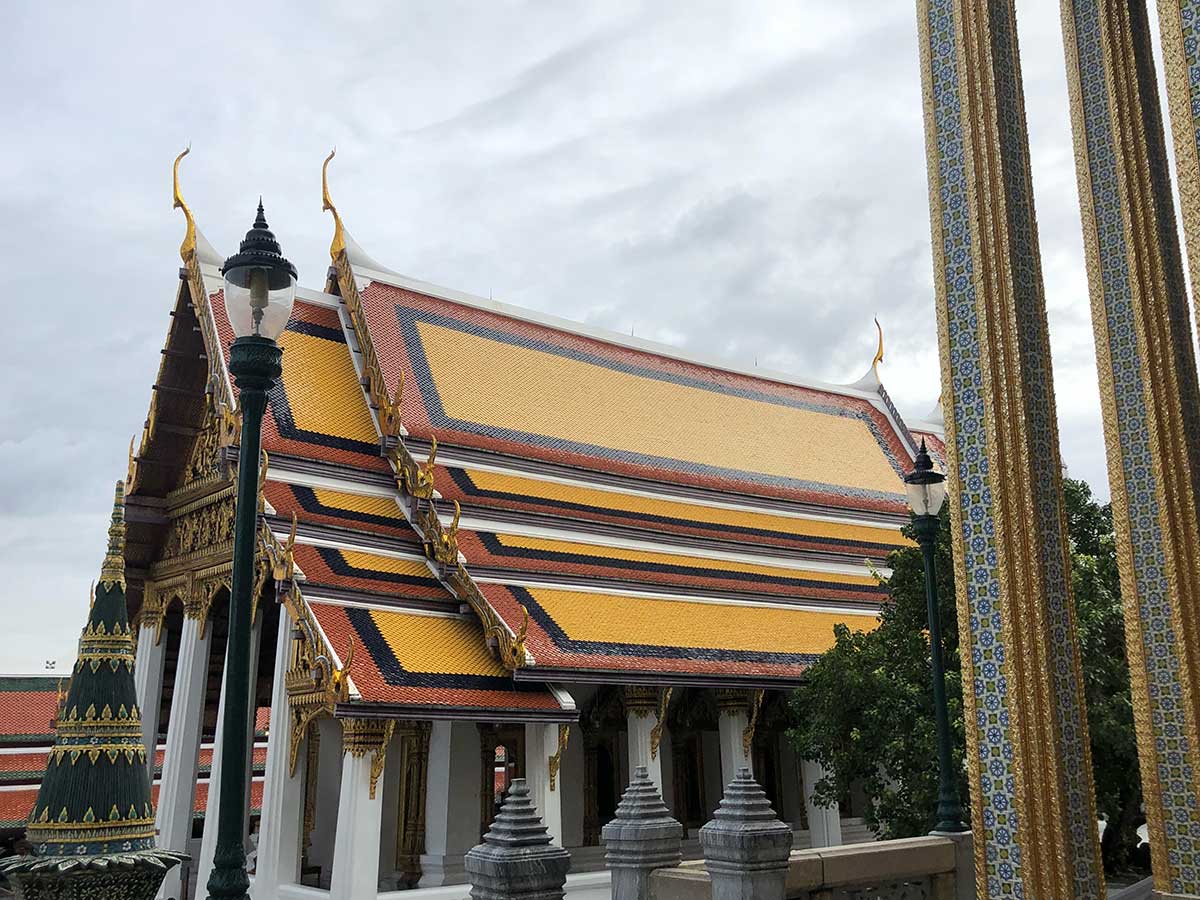
Although the former capital of Ayutthaya was razed to the ground in 1767, not all was lost. As the battle raged, Buddhist monks attempted to save as many holy texts as possible. Once the capital was reestablished in Bangkok, Rama I’s brother financed the construction of Ho Phra Monthiantham to house these scrolls. Because of this, the library was also used as an early school for Buddhist monks; lectures are still occasionally given here today.
Phra Atsda Maha Chedi (Eight Prang)
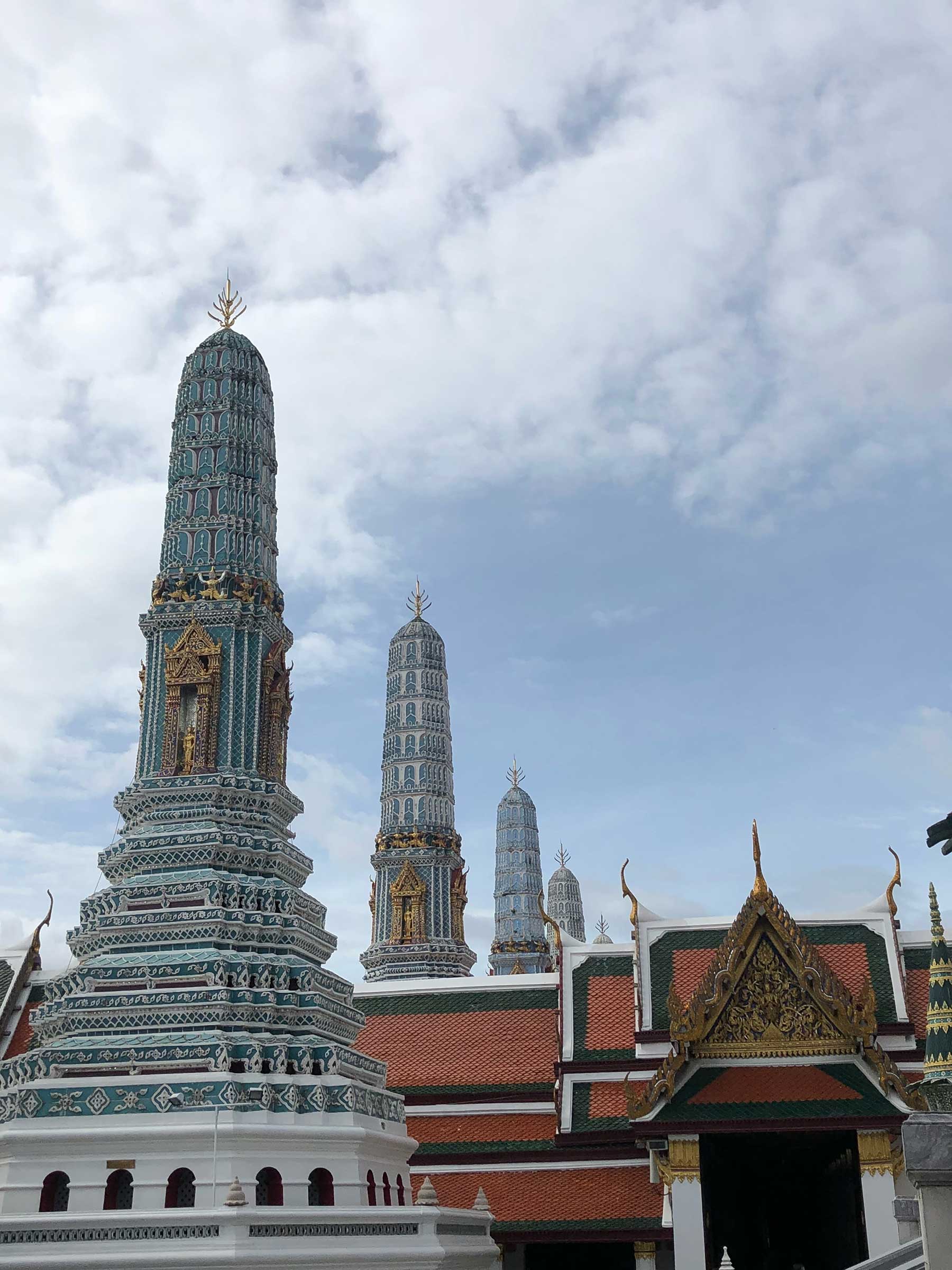
Built during the reign of Rama I, these eight octagonal prang represent different aspects of Buddhism worthy of veneration. These include the Buddha, the Dharma (Buddhist scripture), male monks, female monks, those who have reached enlightenment and the past and future lives of the Buddha. Each chedi has four golden doorways with a deva, or celestial being, standing inside. It’s easy for Westerners to confuse devas with the Christian concept of an angel, but there are several key differences. Most importantly, the life of a deva is finite, even though it many last for thousands or millions of years. They were reincarnated into this life and will eventually die and be reincarnated again. Devas are not all-powerful, nor are they always morally upstanding citizens.
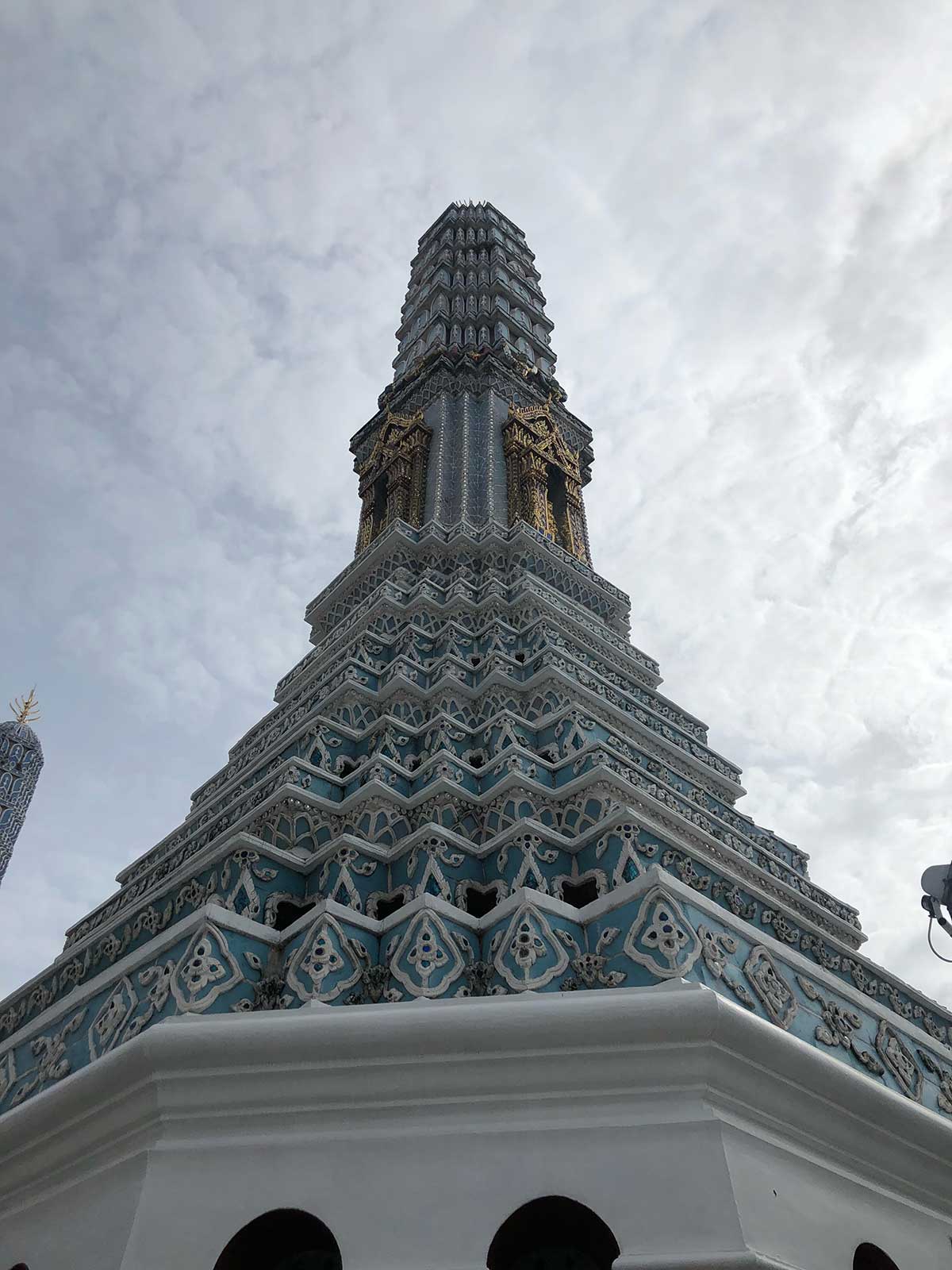
Phra Rabiang (Gallery of the Ramakien)
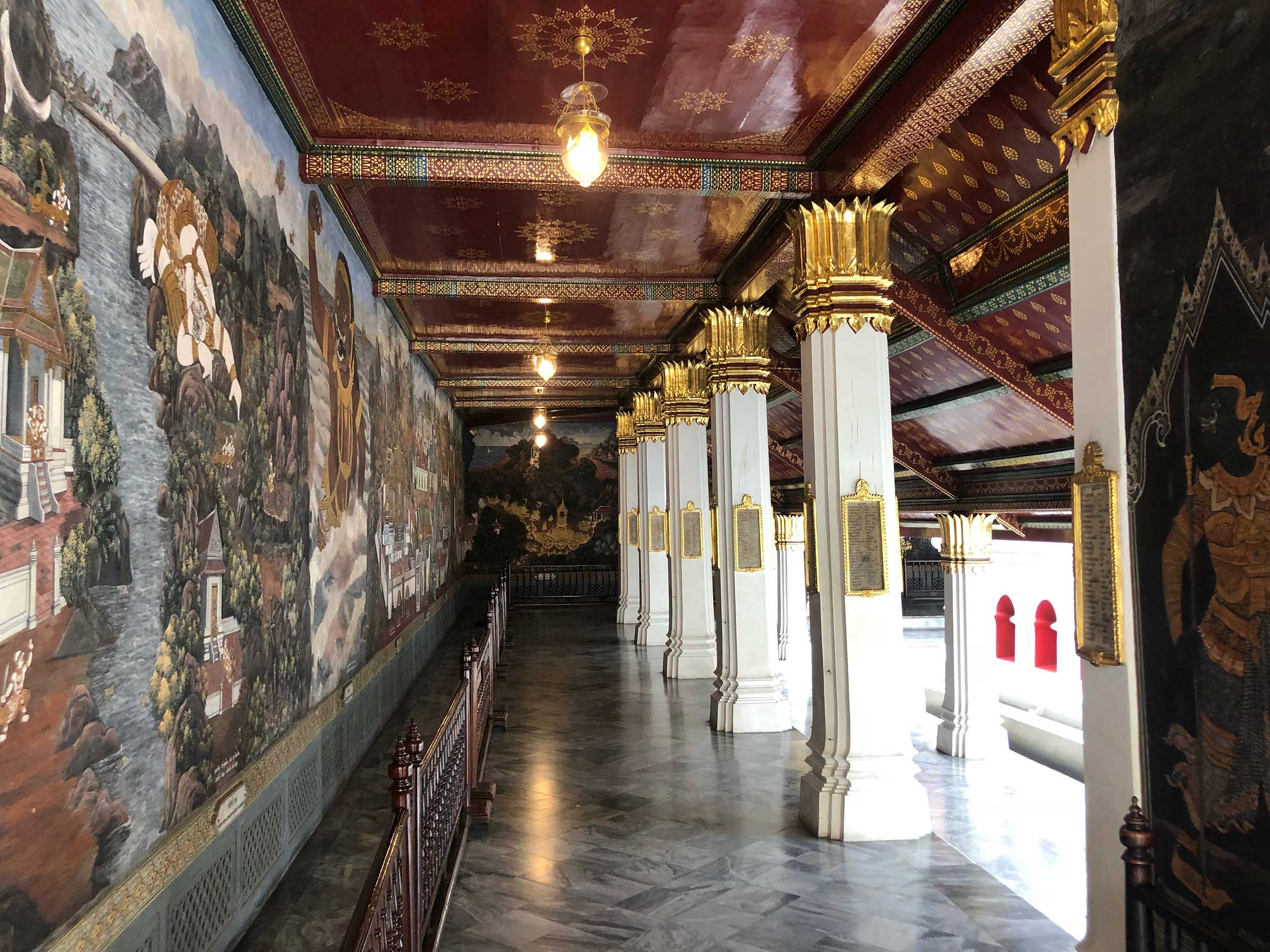
One of the most impressive pieces of art in all of Bangkok is the Ramakien mural that wraps around the entire Wat Phra Kaew. As I mentioned earlier, the Ramakien epic was Rama I’s favorite piece of literature and he wanted each and every moment of the saga to be depicted in the temple. The mural consists of 178 panels that stretch for more than a kilometer. Unfortunately none of the original murals from Rama I’s time have survived. What you see now was repainted under Rama III and is continually being restored to maintain its luster. If you care to follow the story in order, the first panel is at Gate 7.
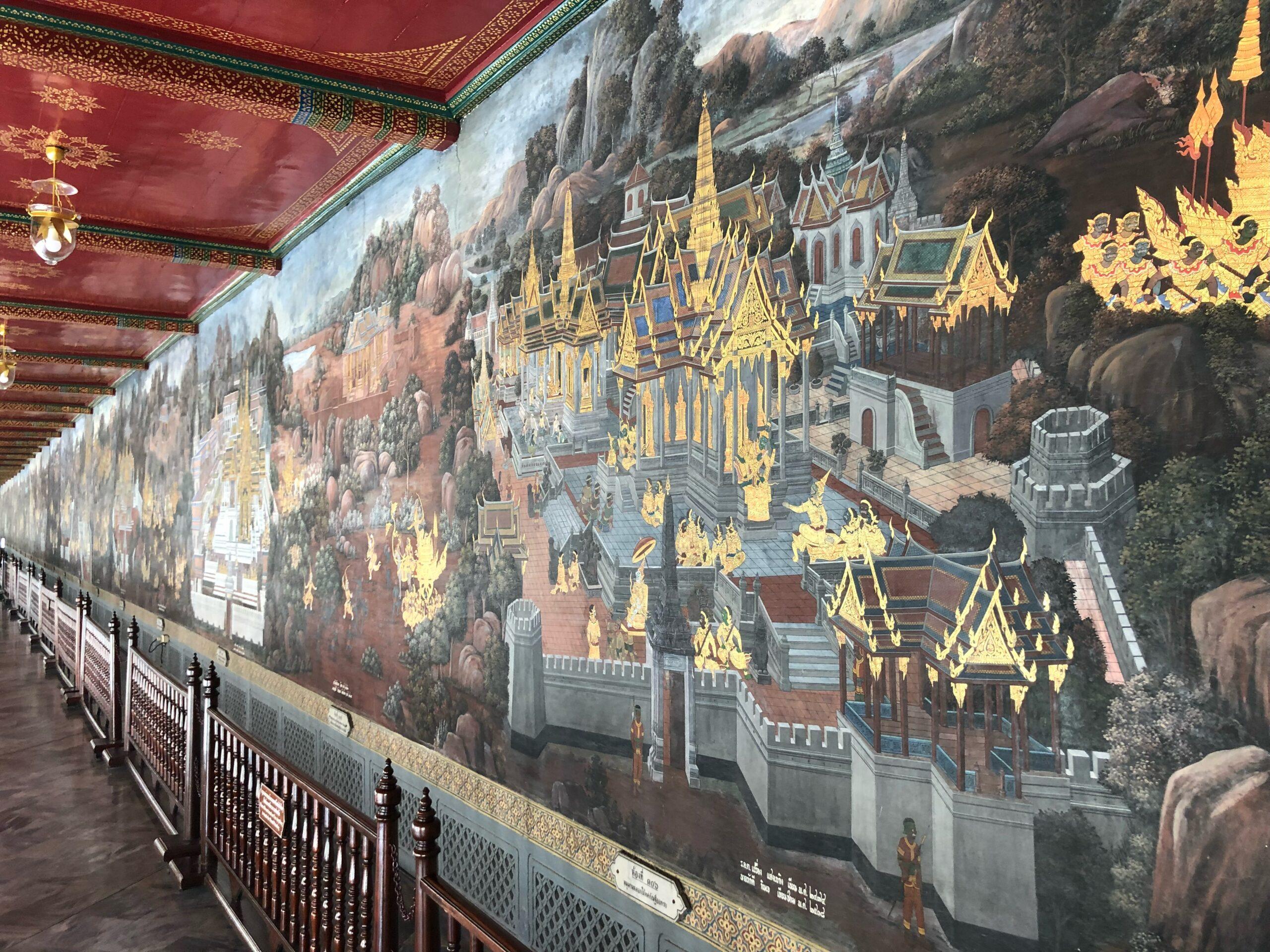
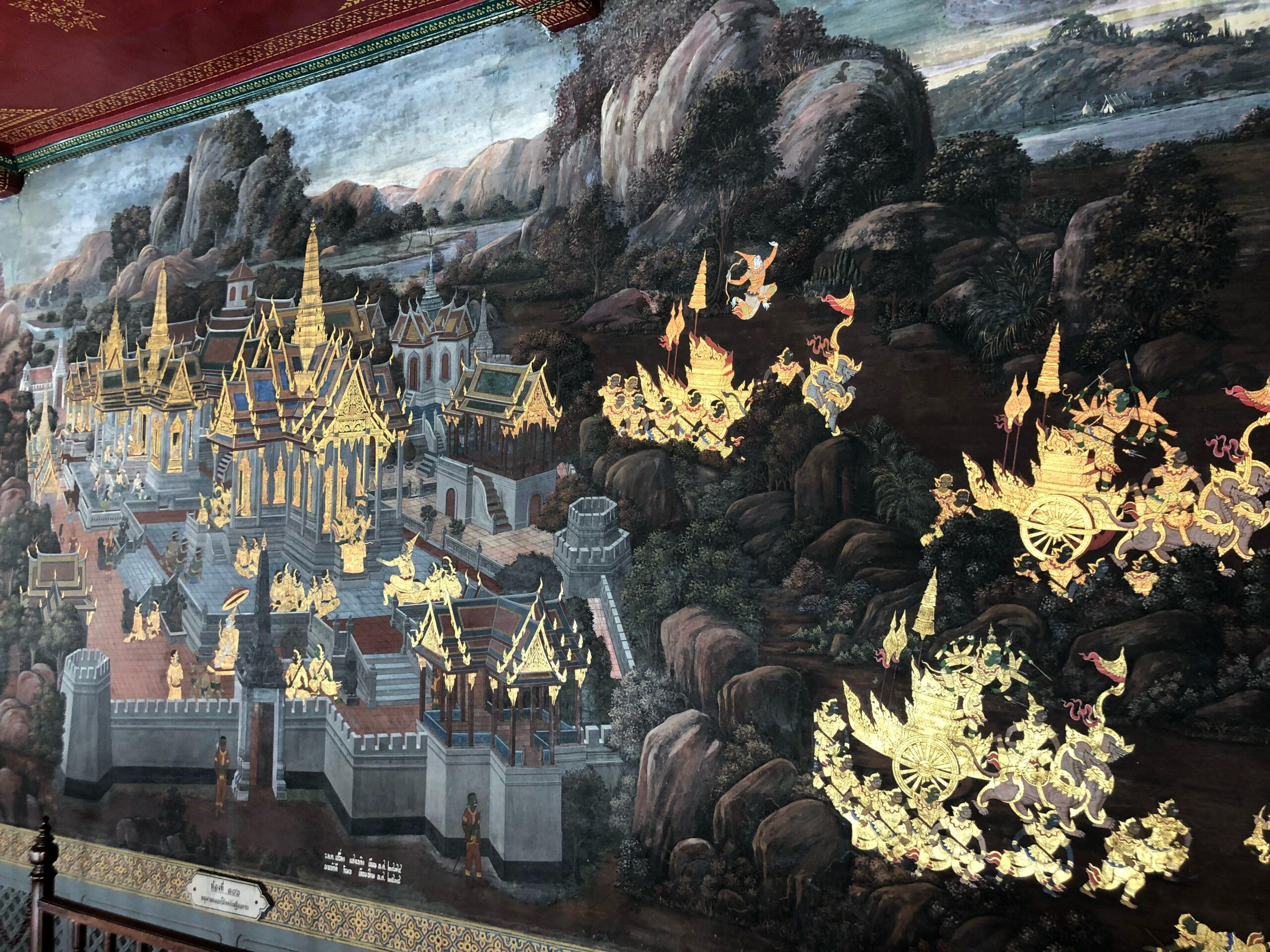
Middle Court
Once you make your way through Wat Phra Kaew, you will find yourself in the Middle Court, home to the former royal residences, throne rooms and governmental departments. This portion of the Grand Palace is less tourist attraction and more in-use work space. You’ll see lots of government workers wearing lanyards and taking coffee breaks, just like you would in any office setting…except they get to work at the Grand Palace!
Phra Maha Montian Group
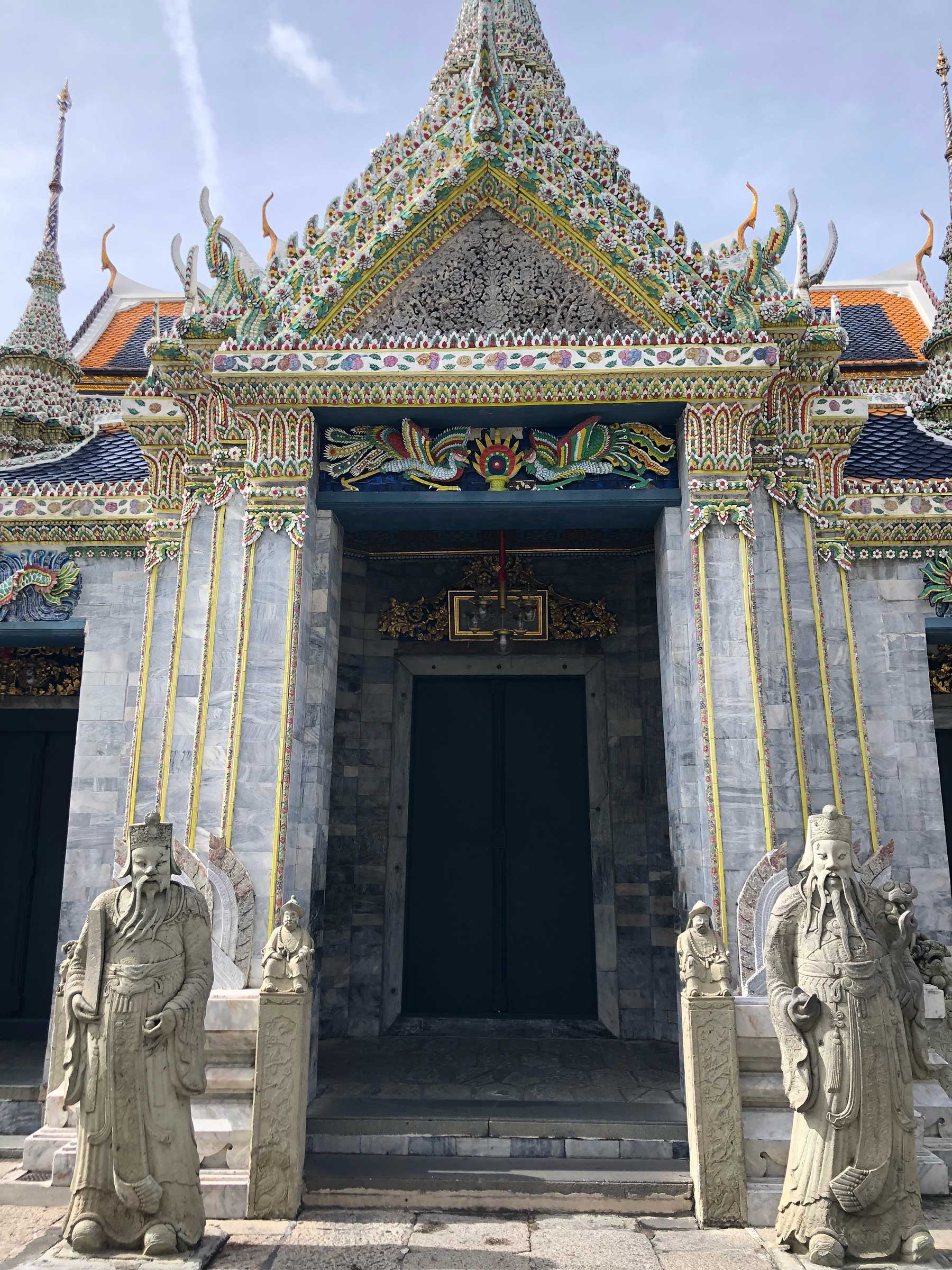
The Middle Court is divided into three main sections, the first of which is the Phra Maha Montian Group. Comprised of seven buildings, this group held the former residence and sleeping quarters of the king. Every royal coronation has been held here since Rama II; ambassadors and heads of state are greeted in the vast reception halls. Above is the Thevaphibal Gate, which only the king is allowed to pass through.
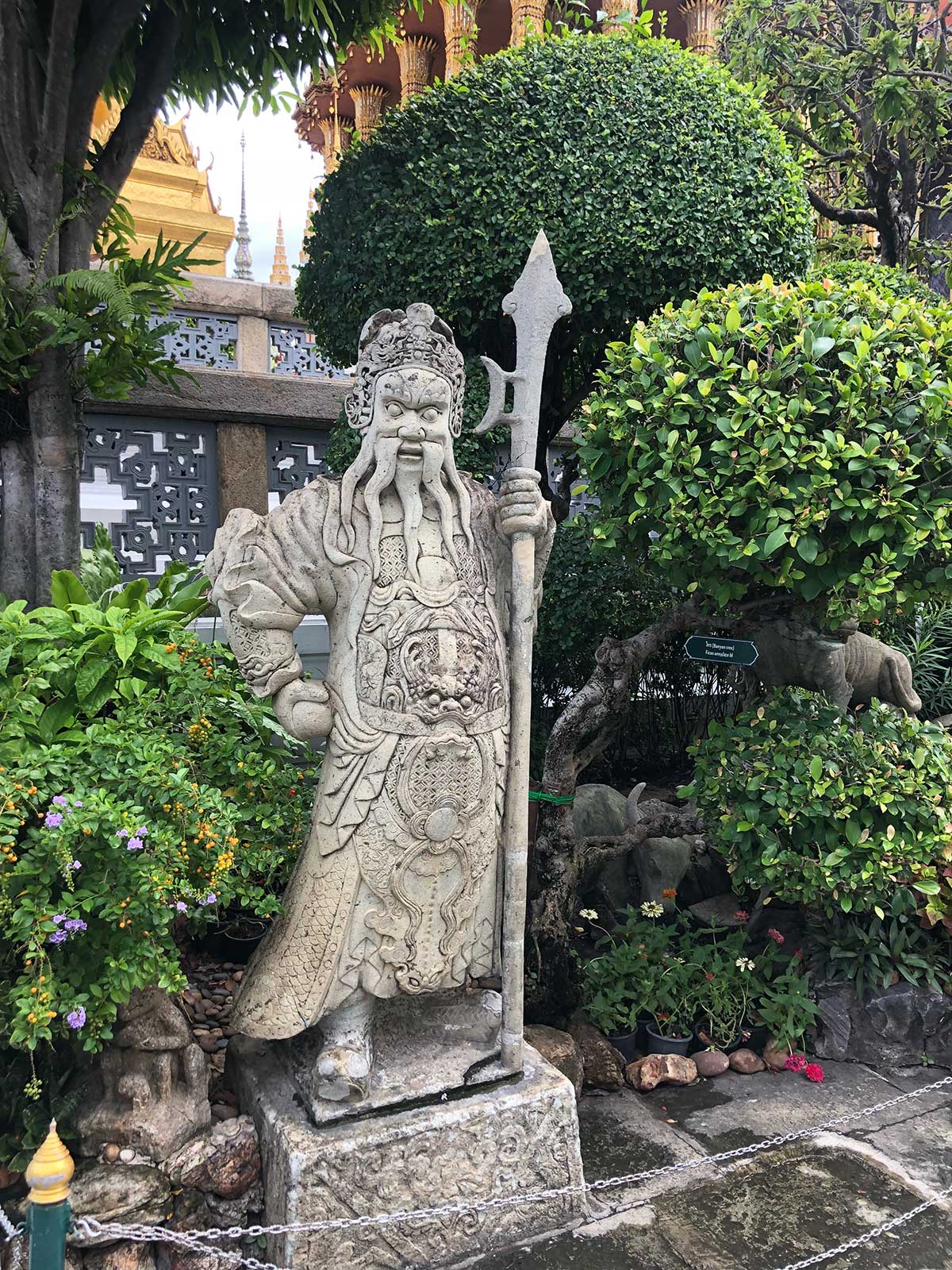
During Rama I’s rule, economic ties were very strong between Thailand and China. Rice and Teakwood would be loaded onto ships and exported to the Chinese mainland in exchange for fine silks and porcelain. These Chinese statues were used as a ballast, a weight that would steady a ship in rough water.
Chakri Maha Prasat
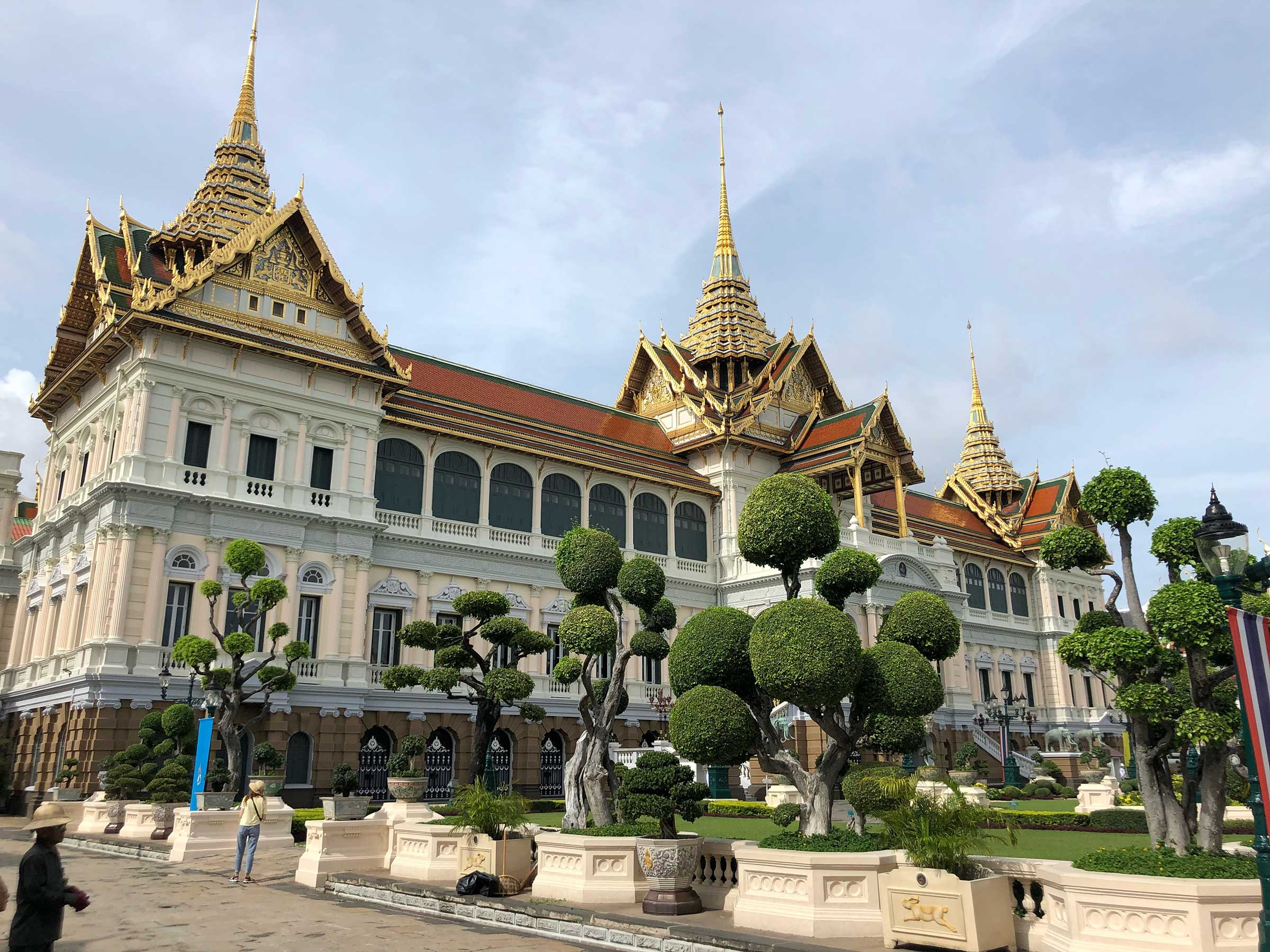
Rama V befriended the British architect John Clunish and in 1877 work began on Chakri Maha Prasat. This would be the most European-style building to grace the Grand Palace, with a Renaissance-inspired exterior and an Italianate interior. But wait, Rama V had a trick up his sleeve! The original design had three domes where you now see three prasat roofs. This European-Thai fusion design is not only unique, but carries a pointed message. Its nickname, “farang sai chadah,” translates to “Westerner in a Thai crown,” and signifies the superiority of the Thai royal headdress atop the lower Western body. The building is a statement that Thailand would not bow down to Western imperialism, and yet at the same time Rama V was trying to incorporate modernity from the West into the traditional Thai way of life at home. (You may also hear the phrase “farang is always wrong,” demonstrating that the Thai people, while friendly, find their way of life superior to life in the West.)
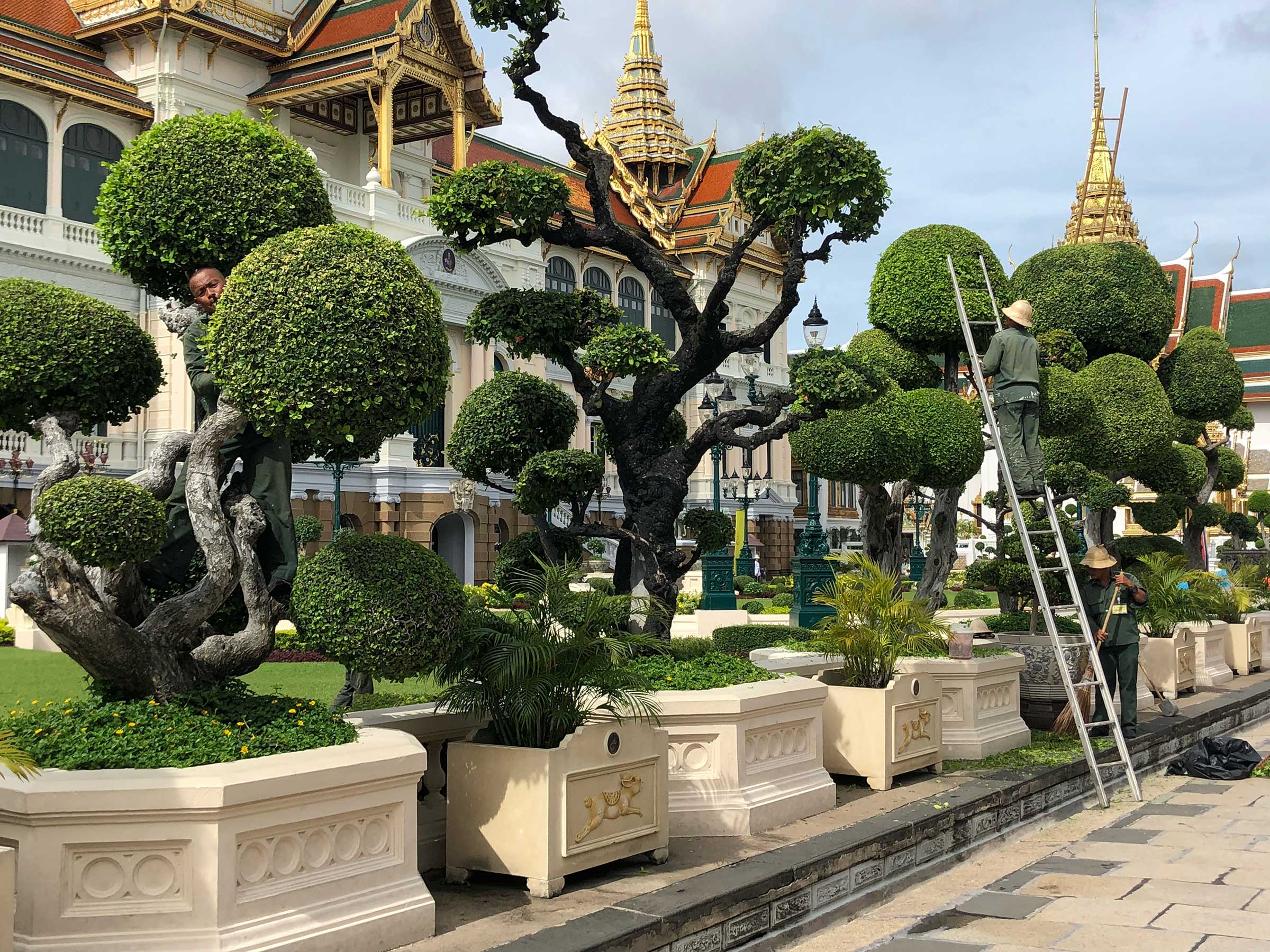
Nowadays the Chakri Maha Prasat holds the ashes of several kings, queens and princes. Rama V often lived here until 1910 when he officially moved to Dusit Palace, north of Ratanakosin Island. Rama VI preferred to live in the countryside and by the time Rama VII took the throne, the residences at the Grand Palace were completely abandoned. Many of these buildings grew to be quite dilapidated and it wasn’t until Rama IX began restoring them in 2004 that they were returned to their former glory.
Phra Maha Prasat Group
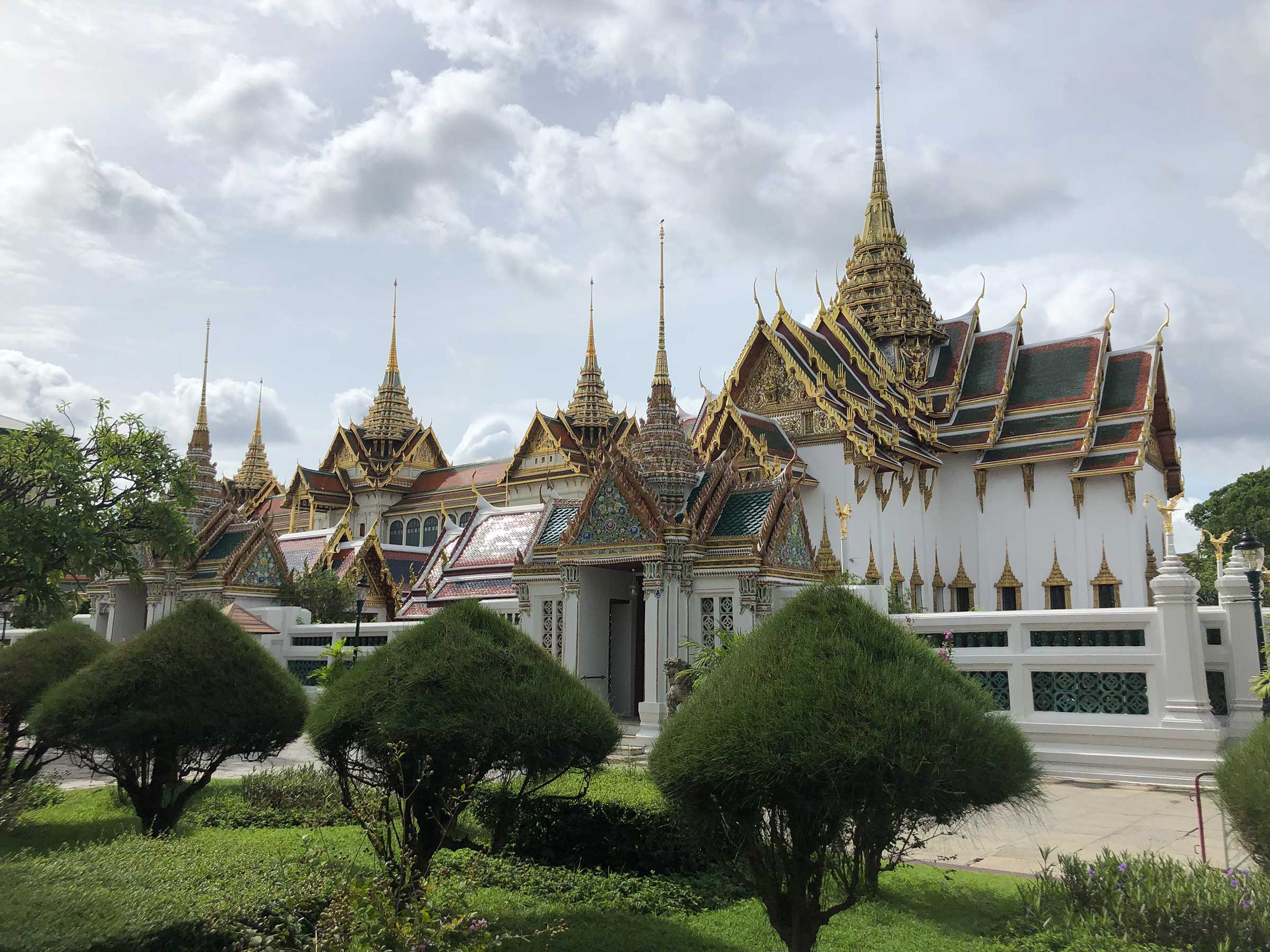
The final group of buildings in the Middle Court were used for ceremonial purposes; their symmetry is extremely precise and symbolism abounds throughout. For example, the structure above on the far right is Dusit Maha Prasat, designed to look like Mount Meru, the mythological center of the universe.
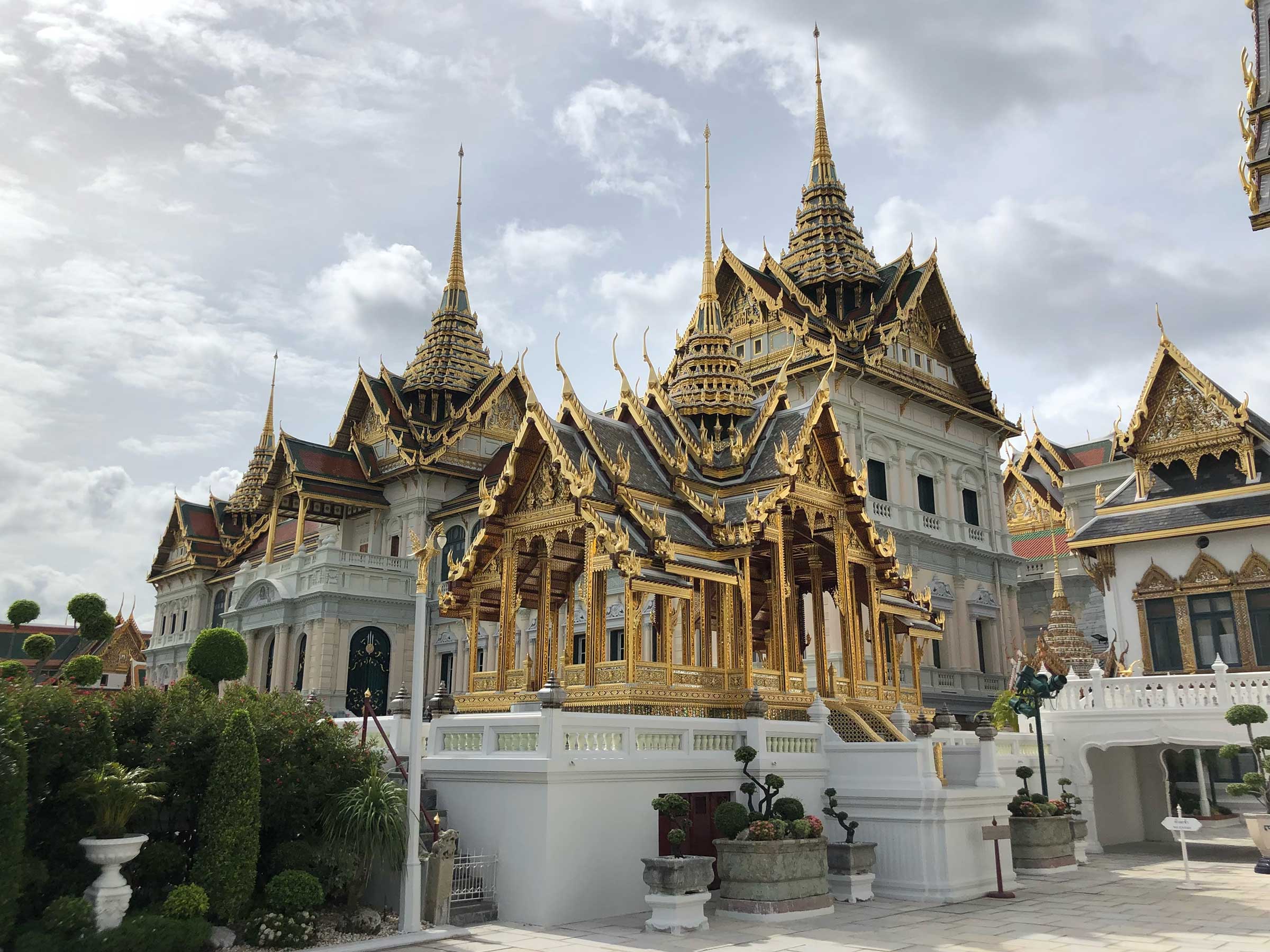
This royal platform, used by the king to don his robes before entering the ceremonial halls, is considered to have achieved the perfect proportions of Thai architecture. So celebrated is its style that a replica was built and displayed at the Thai Pavilion for the 1958 World’s Fair in Brussels.
It’s hard to believe we’ve gotten this far in this post and only covered one sight! Do not underestimate the Grand Palace, both in terms of its size and the number of things to see and learn here. Sure, you could race your way through the grounds, but what would be the point of that? Budget an entire morning to take it all in, break for lunch and then gear up for Wat Pho and the National Museum in the afternoon.
Wat Pho
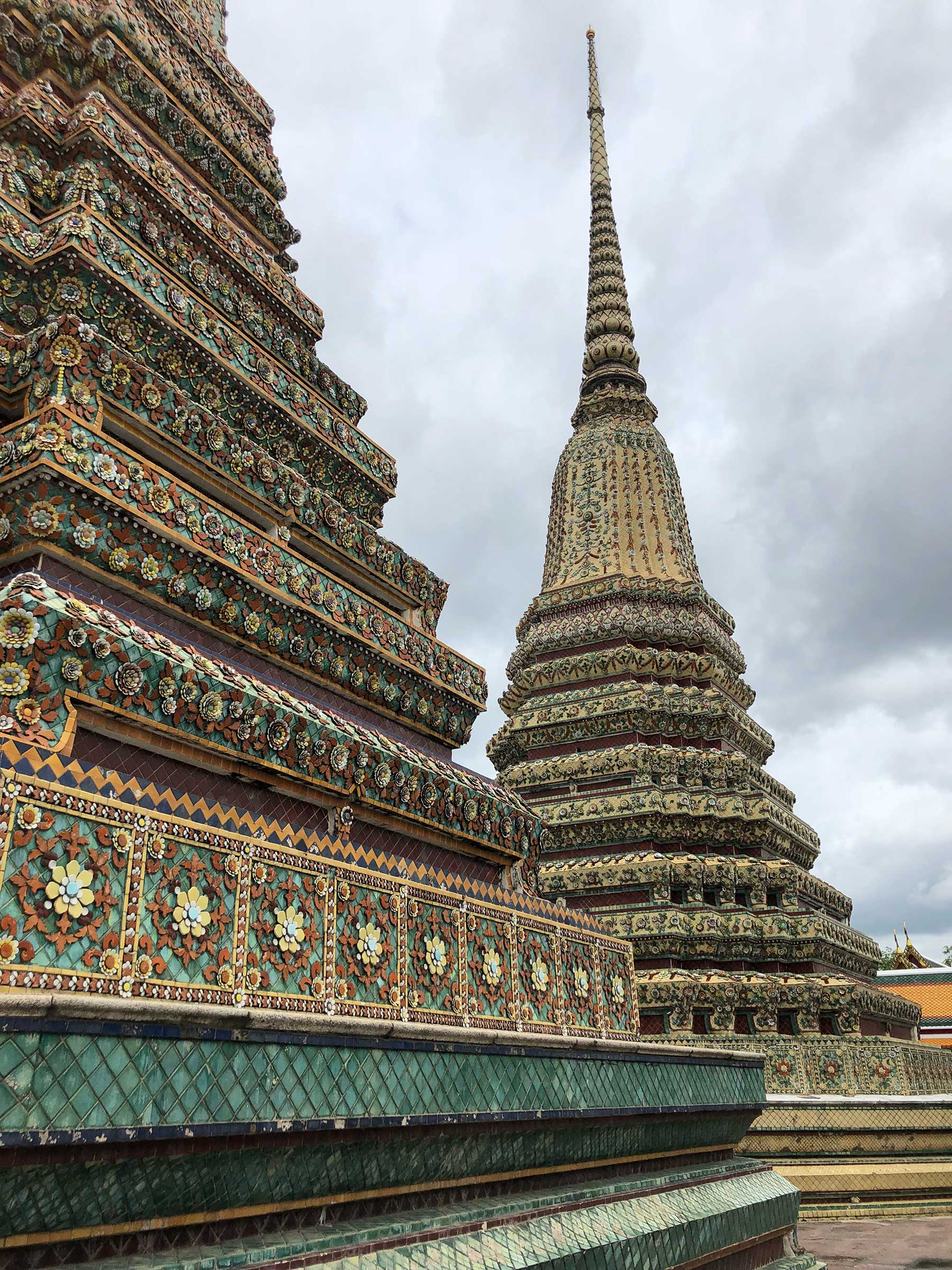
Wat Pho is Bangkok’s most heralded temple: it is both the oldest and the largest in the city, plus it acted as Bangkok’s first public university. Wat Pho predates Rama I moving the capital to Bangkok by almost 100 years. It’s earliest structures were built in 1688, which were expanded upon by Rama I, and once again by Rama III. The temple is an active monastery and place of worship, so although it is marketed as a “tourist attraction,” be aware that locals are also there to pray and live. (Bangkok was officially founded in 1782 by Rama I and and centennials have been celebrated in 1882 and 1982, but settlements existed in Bangkok for centuries before it became the capital. Bangkok is approaching its 250th birthday, but people have called it a home for much longer.)
Viharn Phranon
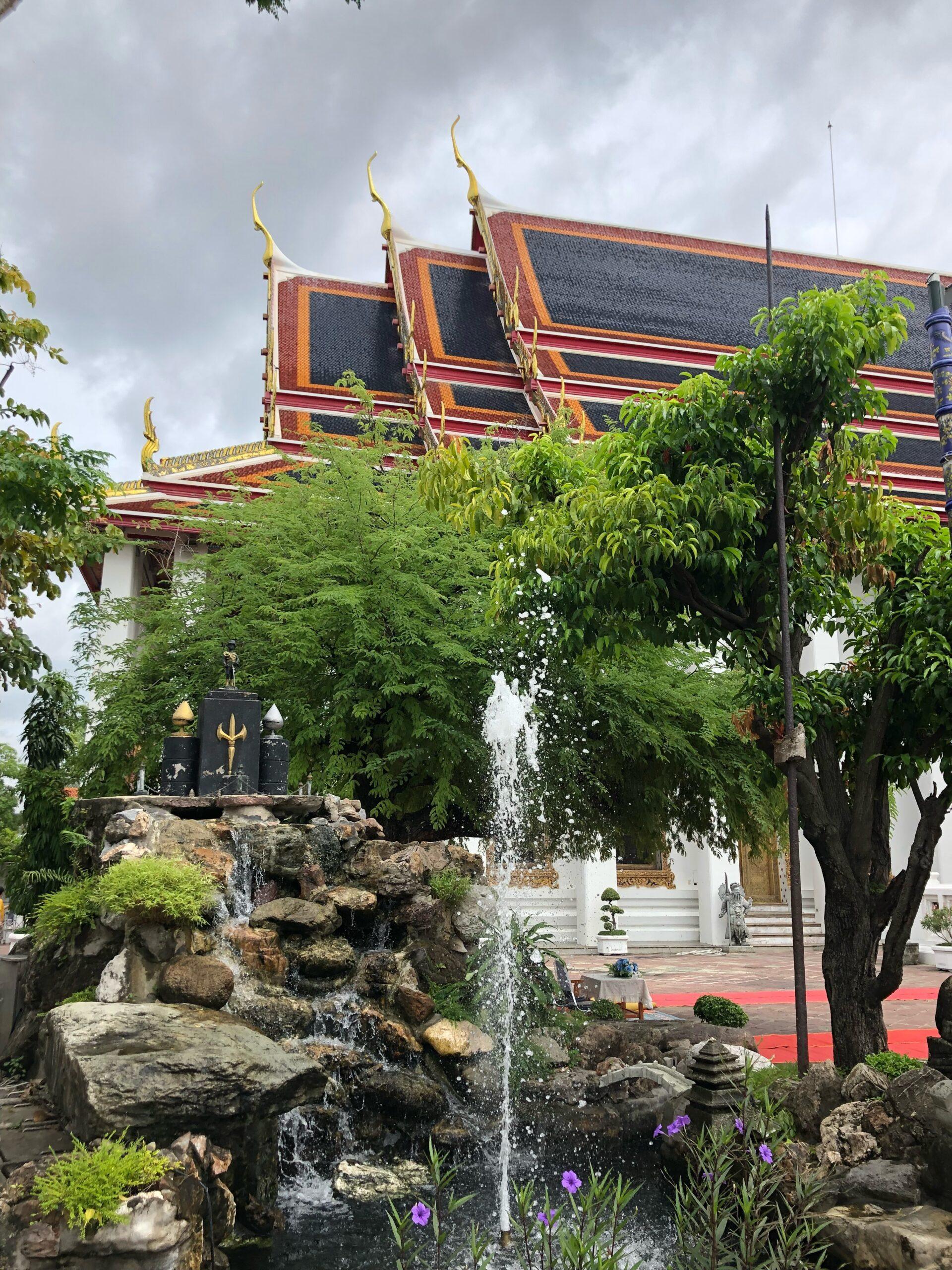
Most visitors who come to Wat Pho make a beeline for Viharn Phranorn, the building that houses the temple’s famed reclining Buddha. At 46m (150ft) long and 15m (50ft) high, this is largest reclining Buddha in Thailand. The Buddha was a later edition to Wat Pho, added by Rama III in 1832. It was first constructed with bricks that were then covered in plaster before a layer of gold leaf was finally applied to finish off the image.
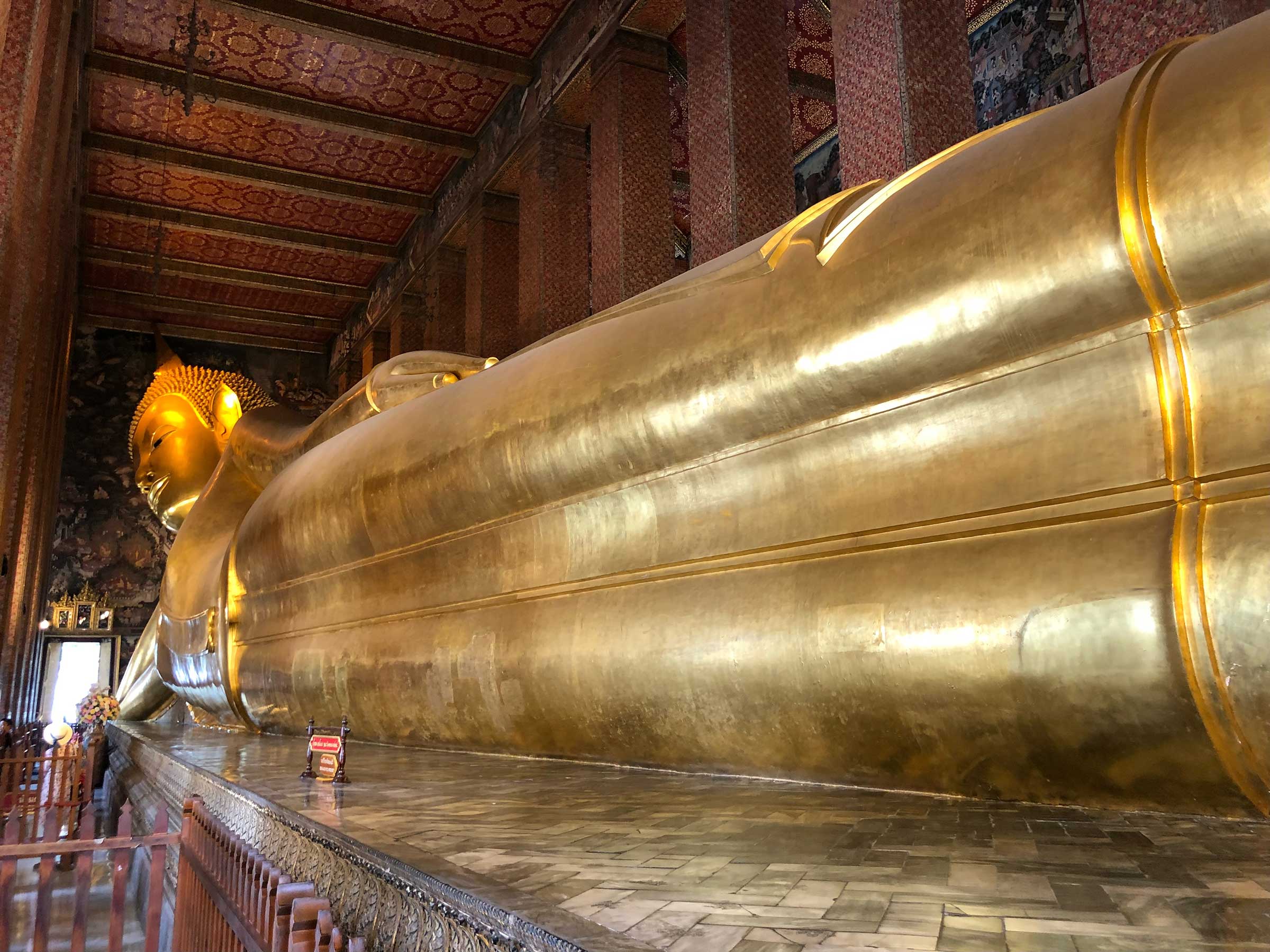
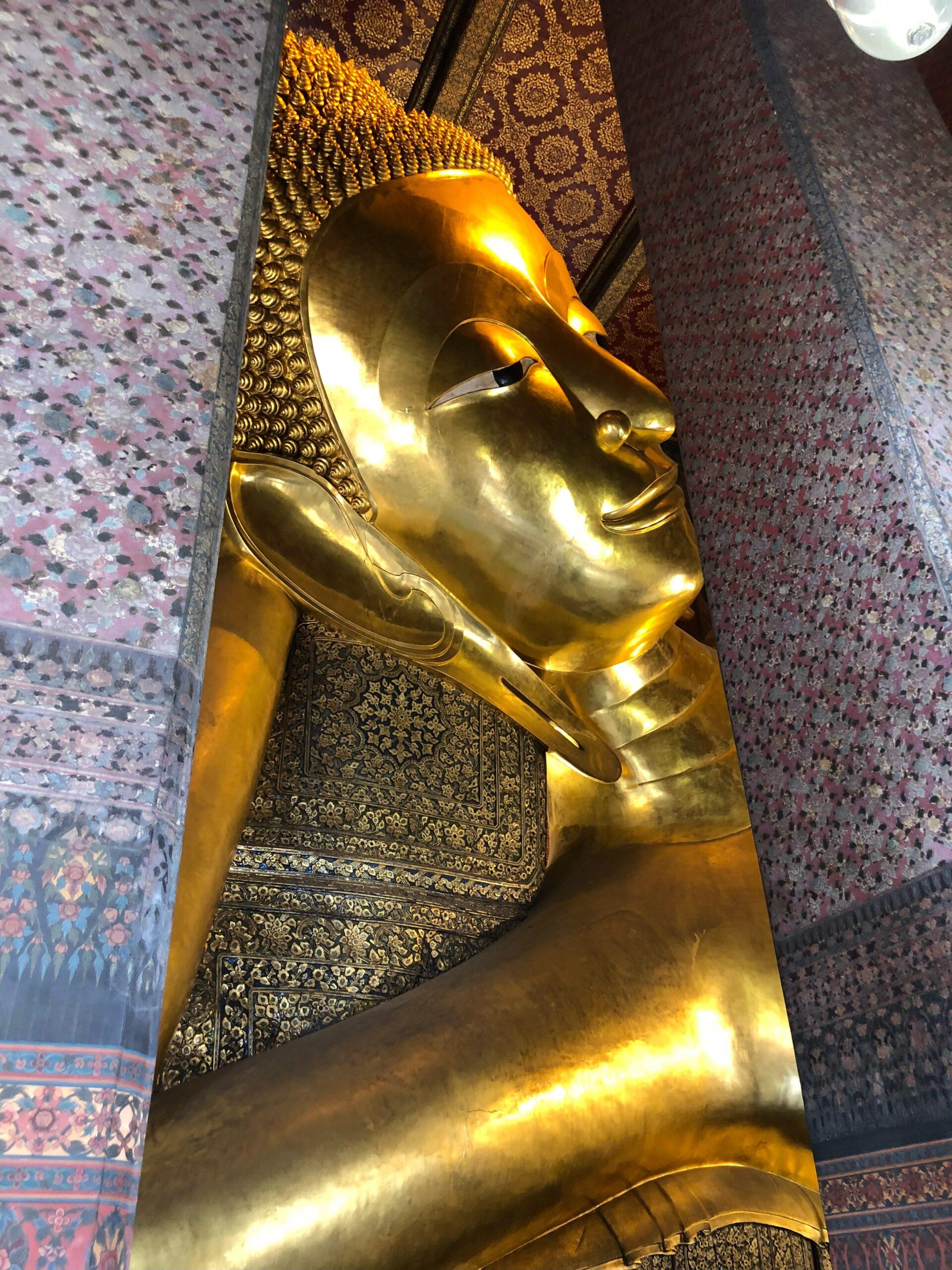
The Buddha is seen smiling, having finally entered Nirvana upon his death. Buddha statues are usually posed in standing, praying or reclining positions. If you reach enlightenment in your lifetime you will escape the cycle of pain and suffering and enter Nirvana, a state of peace where you will no longer be reincarnated. The reclining pose captures this exact moment.
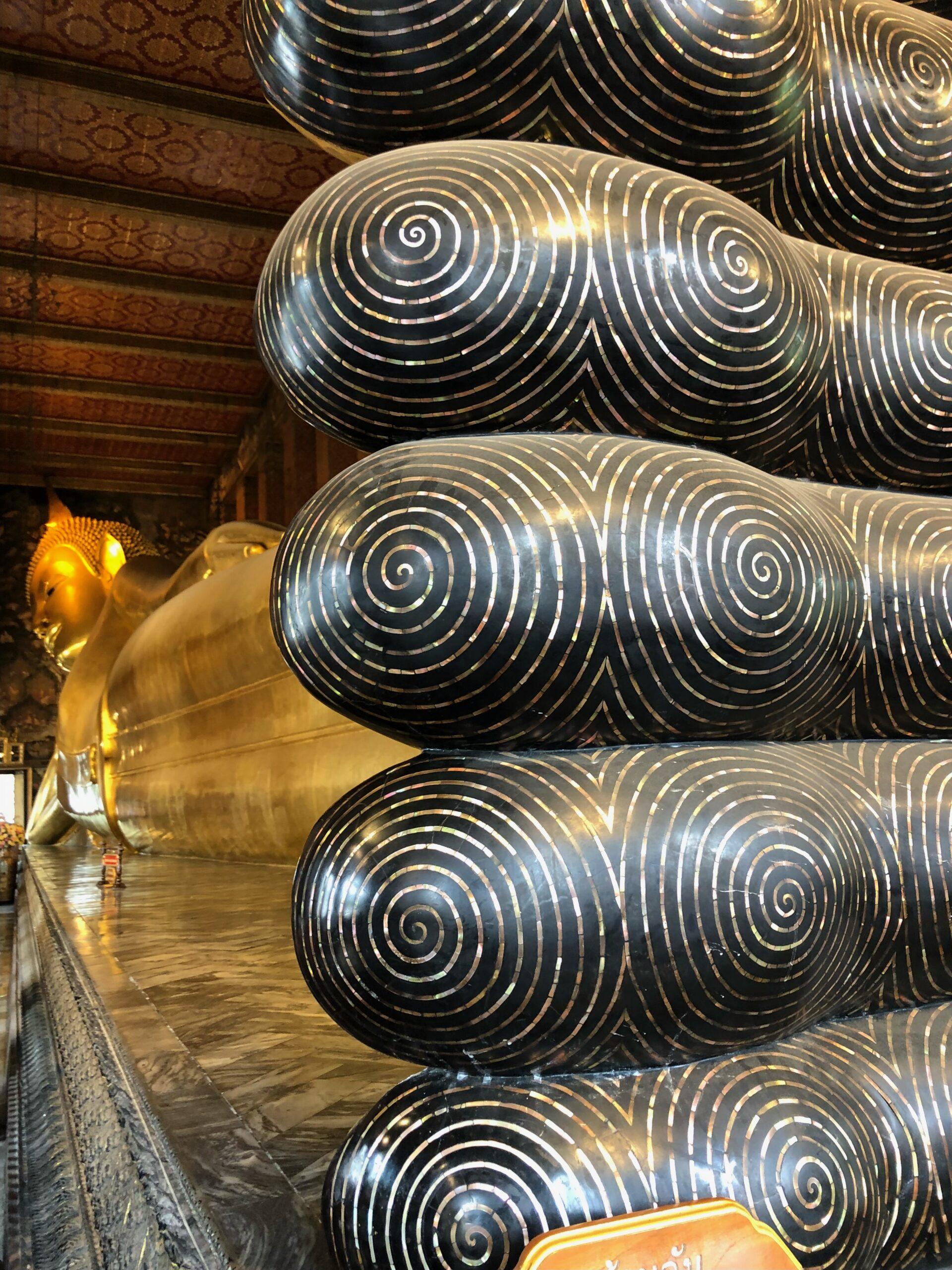
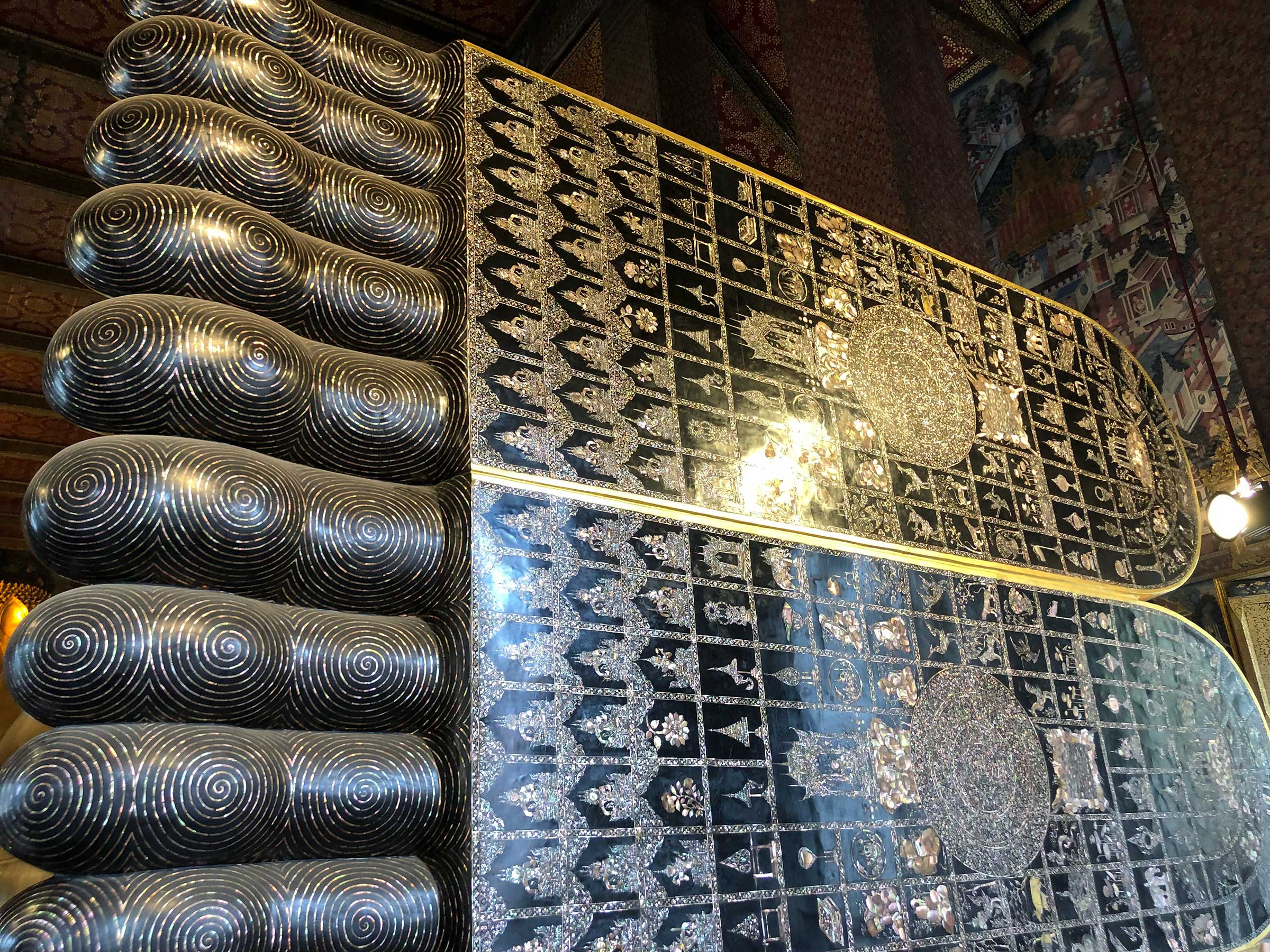
On the bottom of the Buddha’s fit are 108 mother-of-pearl images depicting the 108 auspicious characters the Buddha can assume. Behind the statue are 108 pots, one for each character. You can exchange some bills for change at the ticket booth and place a small coin in each pot for good luck.
Phra Rabiang
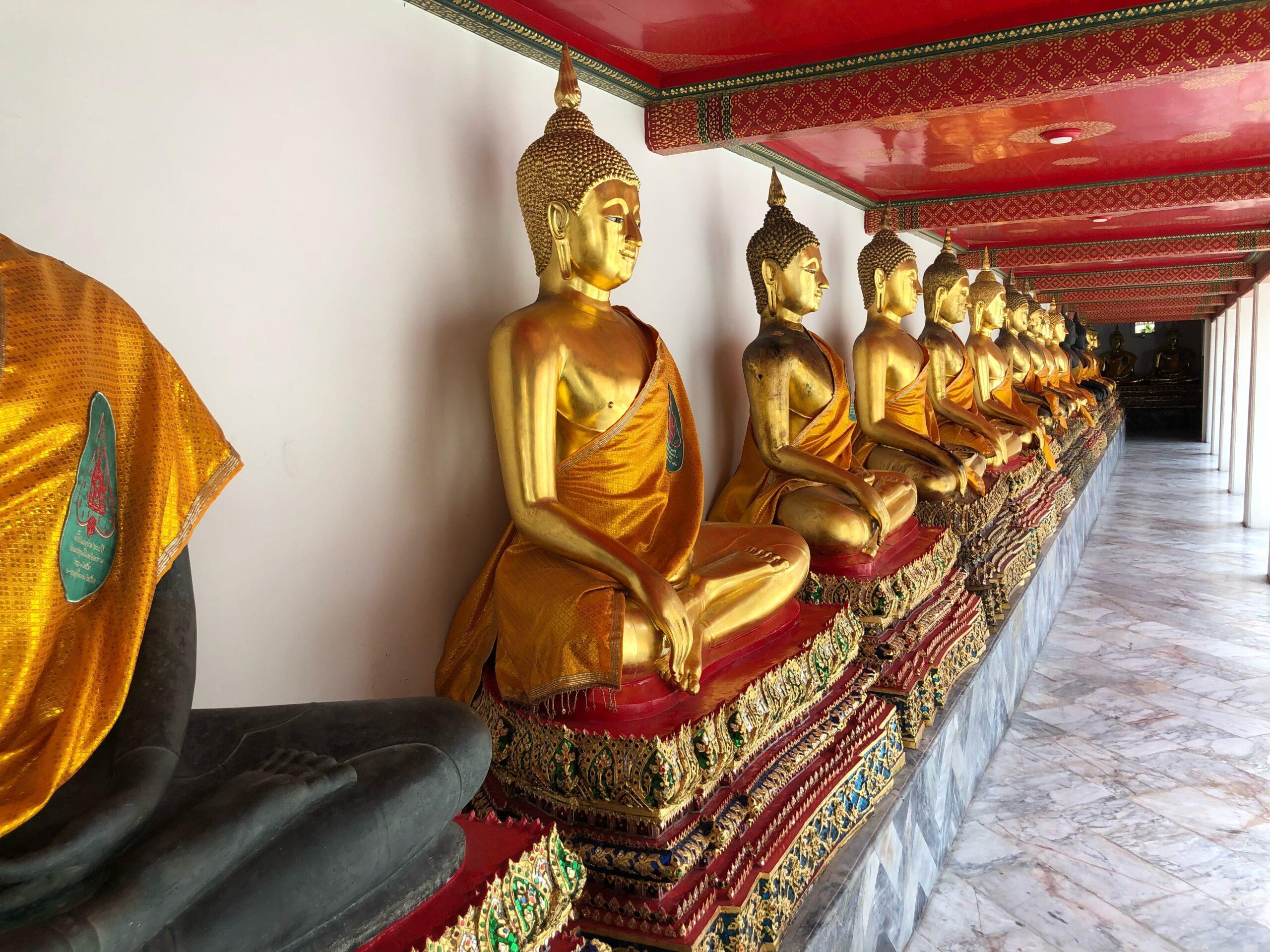
Another credit to Wat Pho’s name is that has the largest collection of Buddha images in all of Thailand. Rama I amassed these icons by the thousand from temples throughout the country to be displayed here. Phra Rabiang is a gallery of nearly 400 Buddhas; here you see them in a prayer/meditation pose.
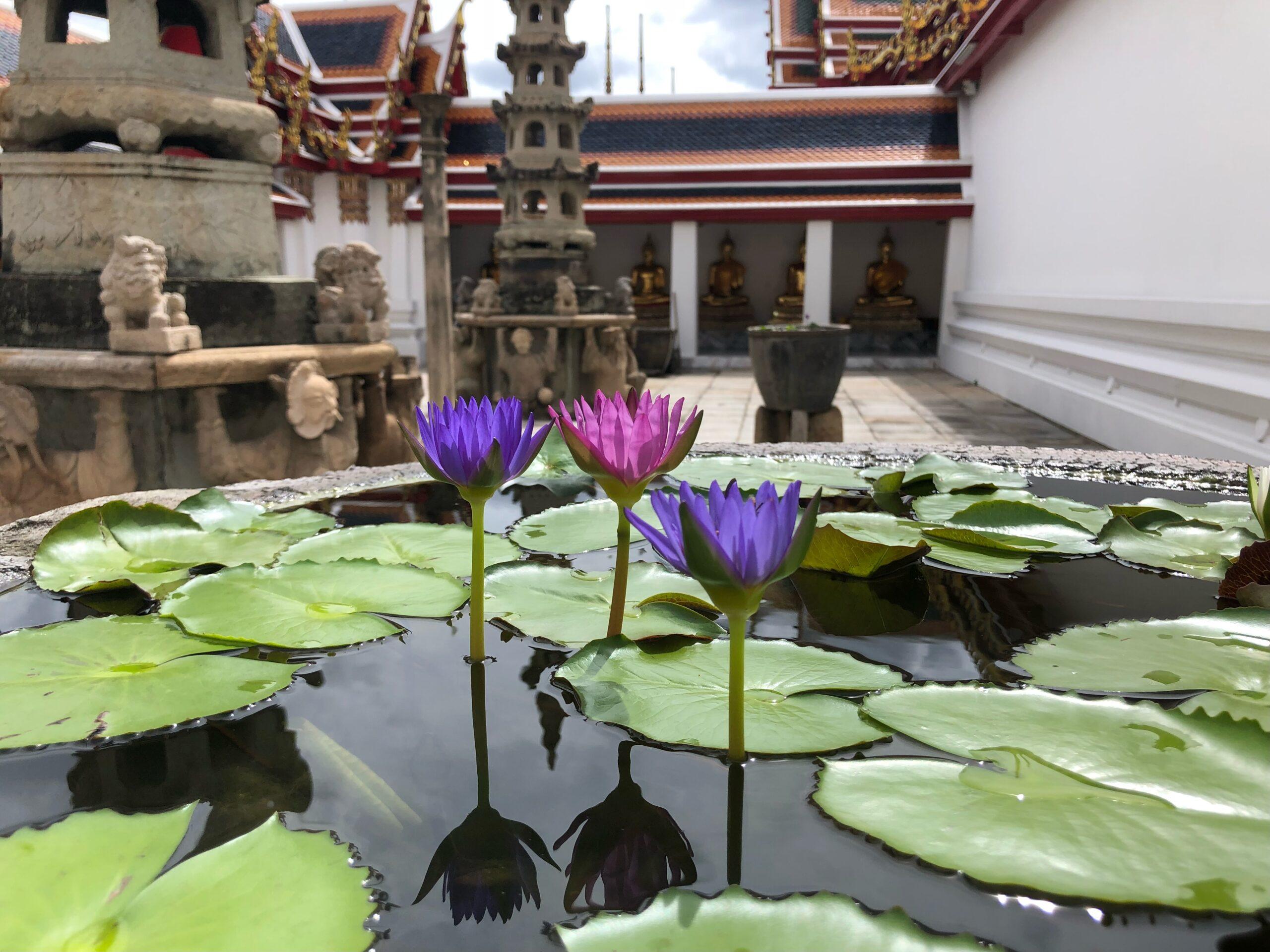
Missakawen Park
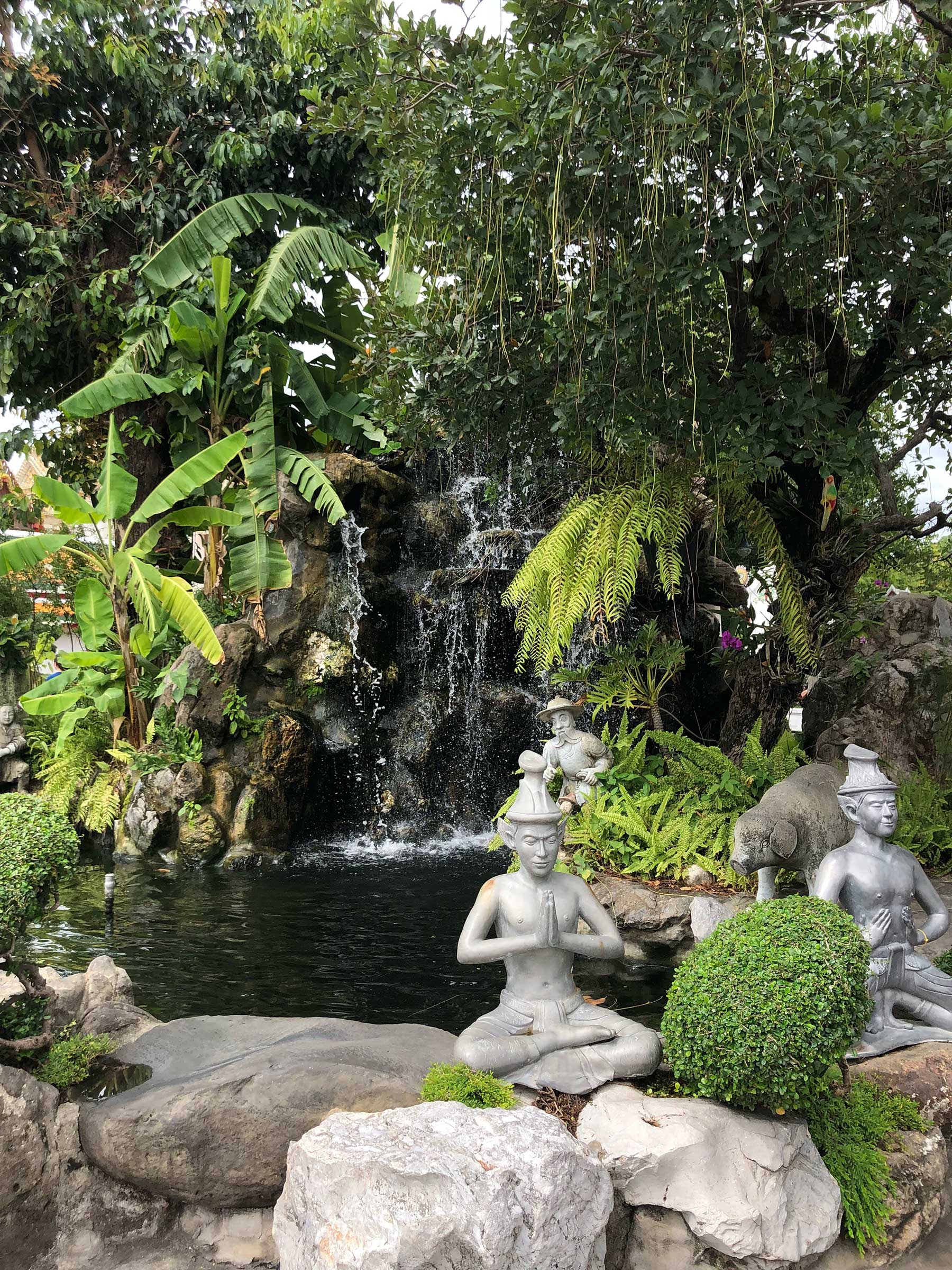
This small park on the temple grounds has a bodhi tree that is said to have been planted from a branch of the exact bodhi tree in India that the Buddha was sleeping under when he reached enlightenment.
Phra Maha Chedi (Royal Chedi)
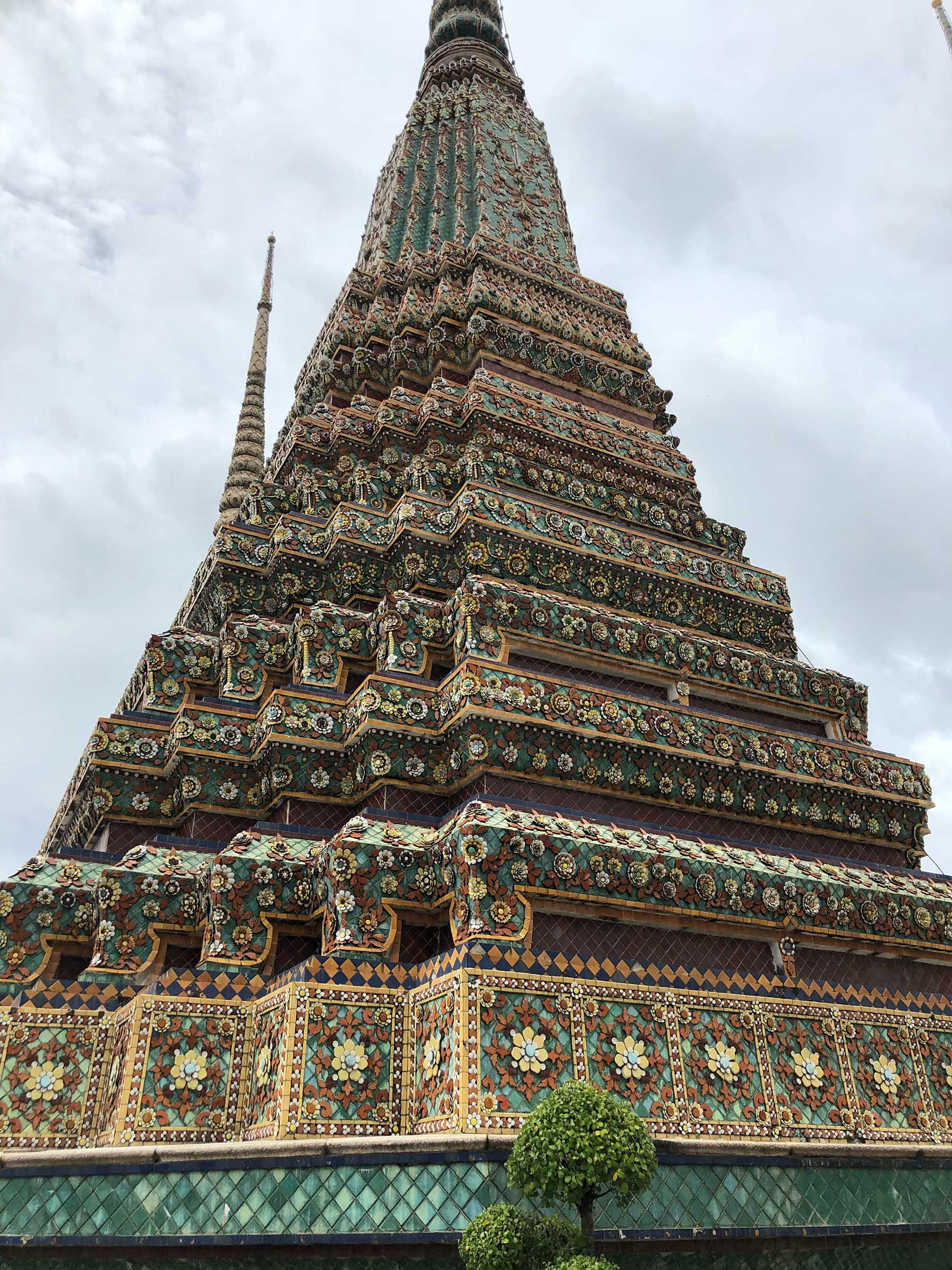
There are four royal chedi at Wat Pho, one for each of the first four kings at Bangkok. They stand 42m (137ft) tall and are imbued with dazzling porcelain tiles. This was a jaw-dropping moment for me. You start to think you’ve seen the world and that sense of wonder starts to slip away after you’ve ticked so many countries off the list. And then something like these come along that are so beautiful and awesome that it humbles you and makes you realize how little you realize.
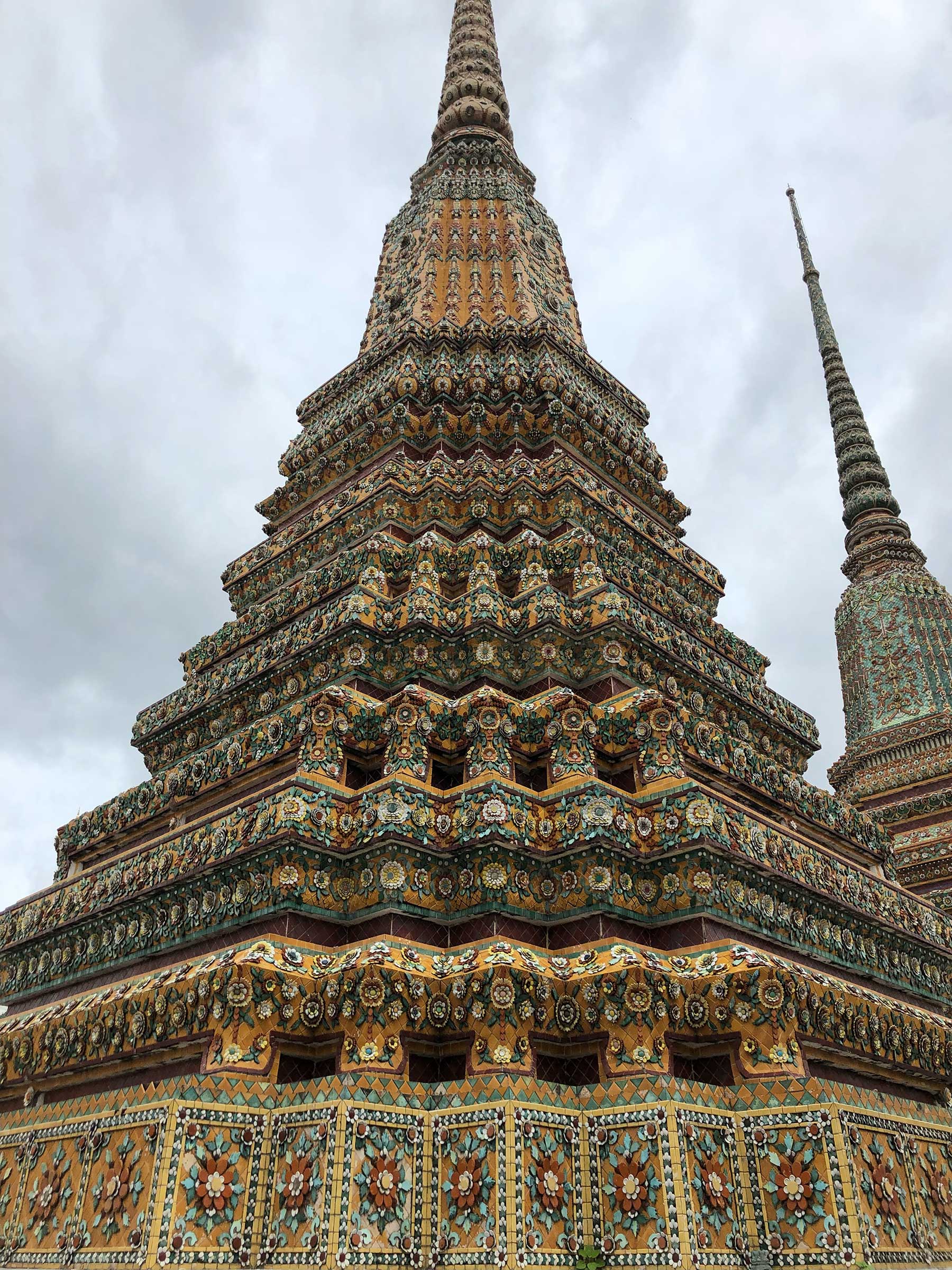
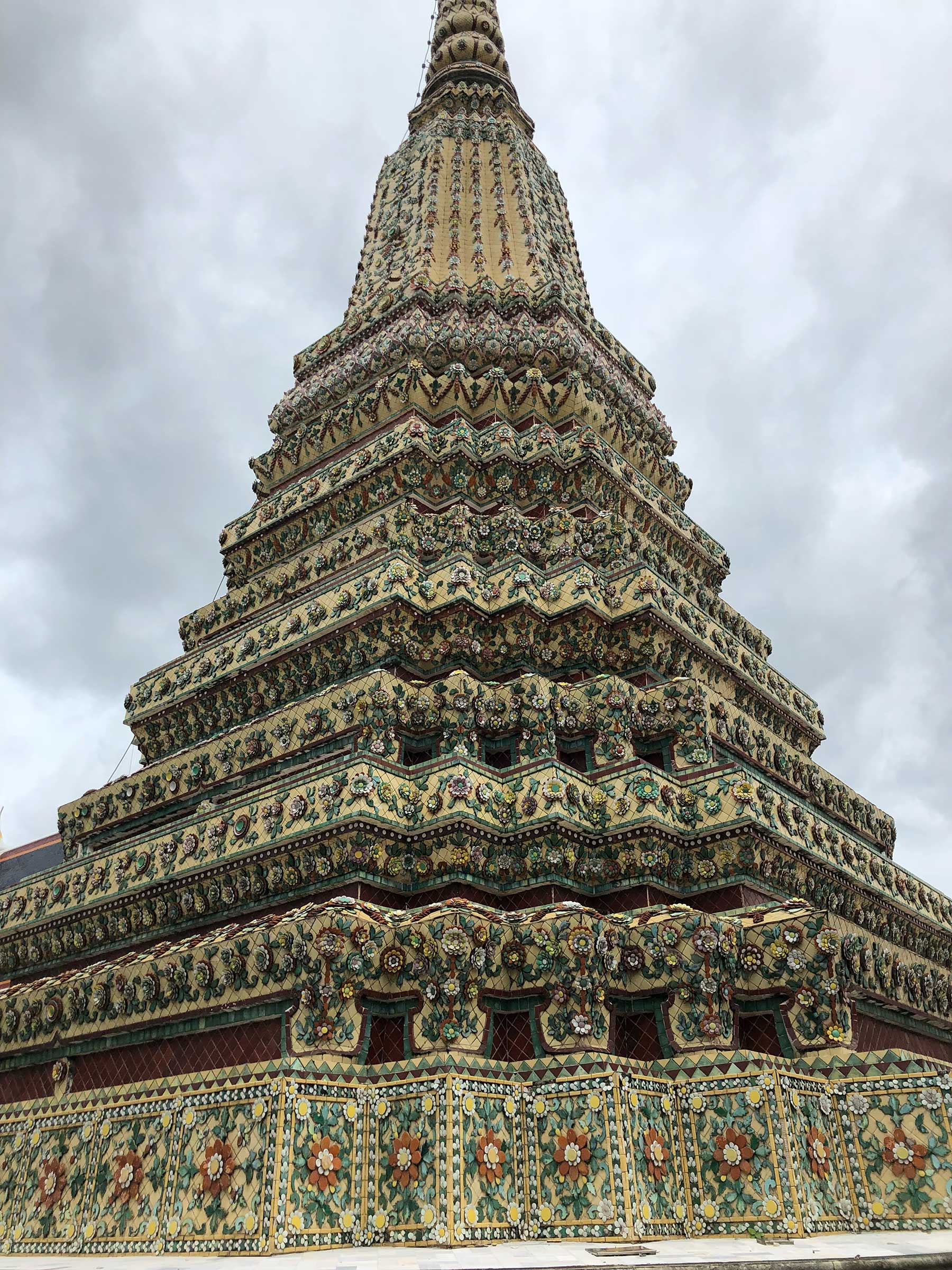
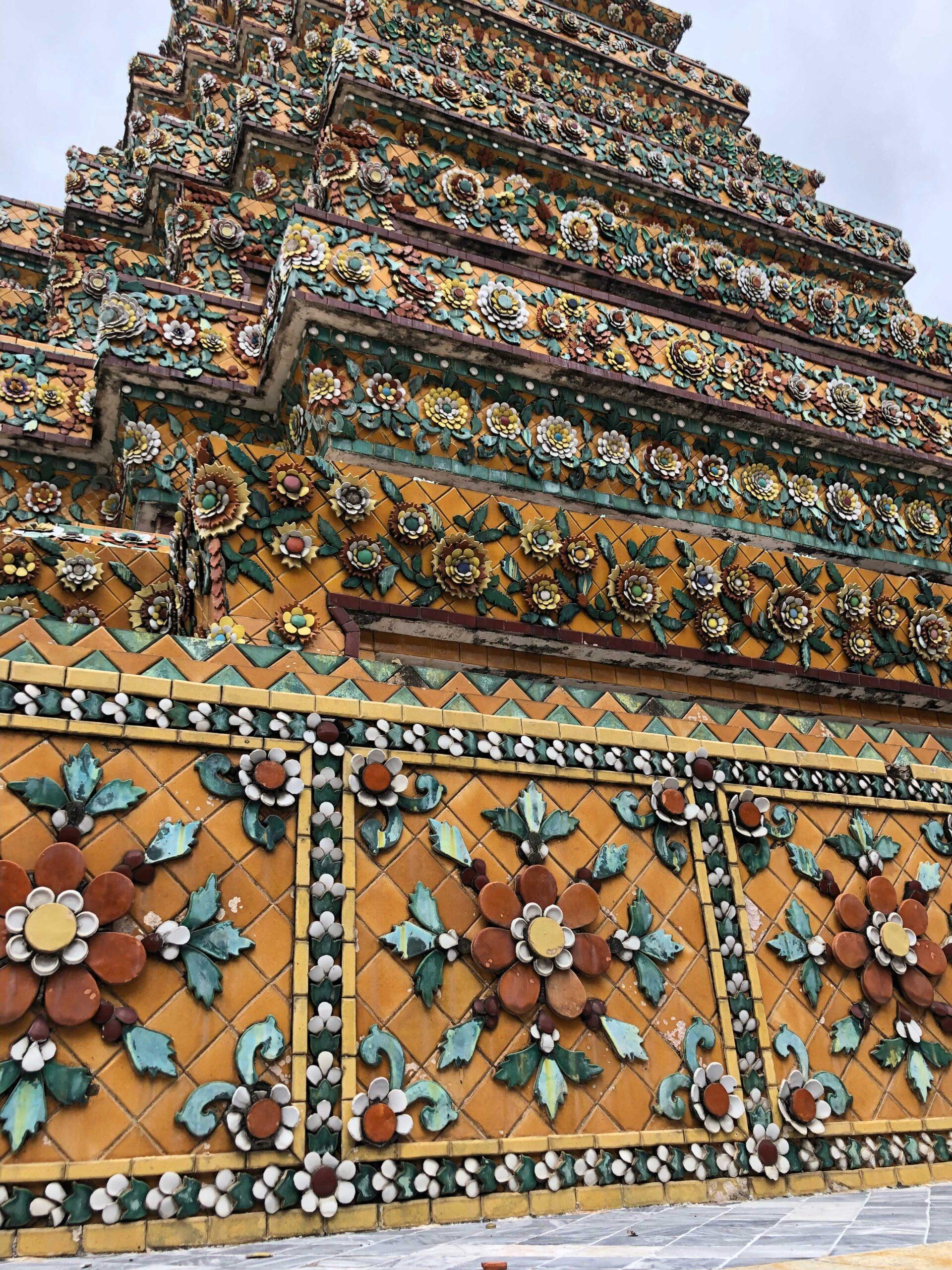
Phra Chedi Rai
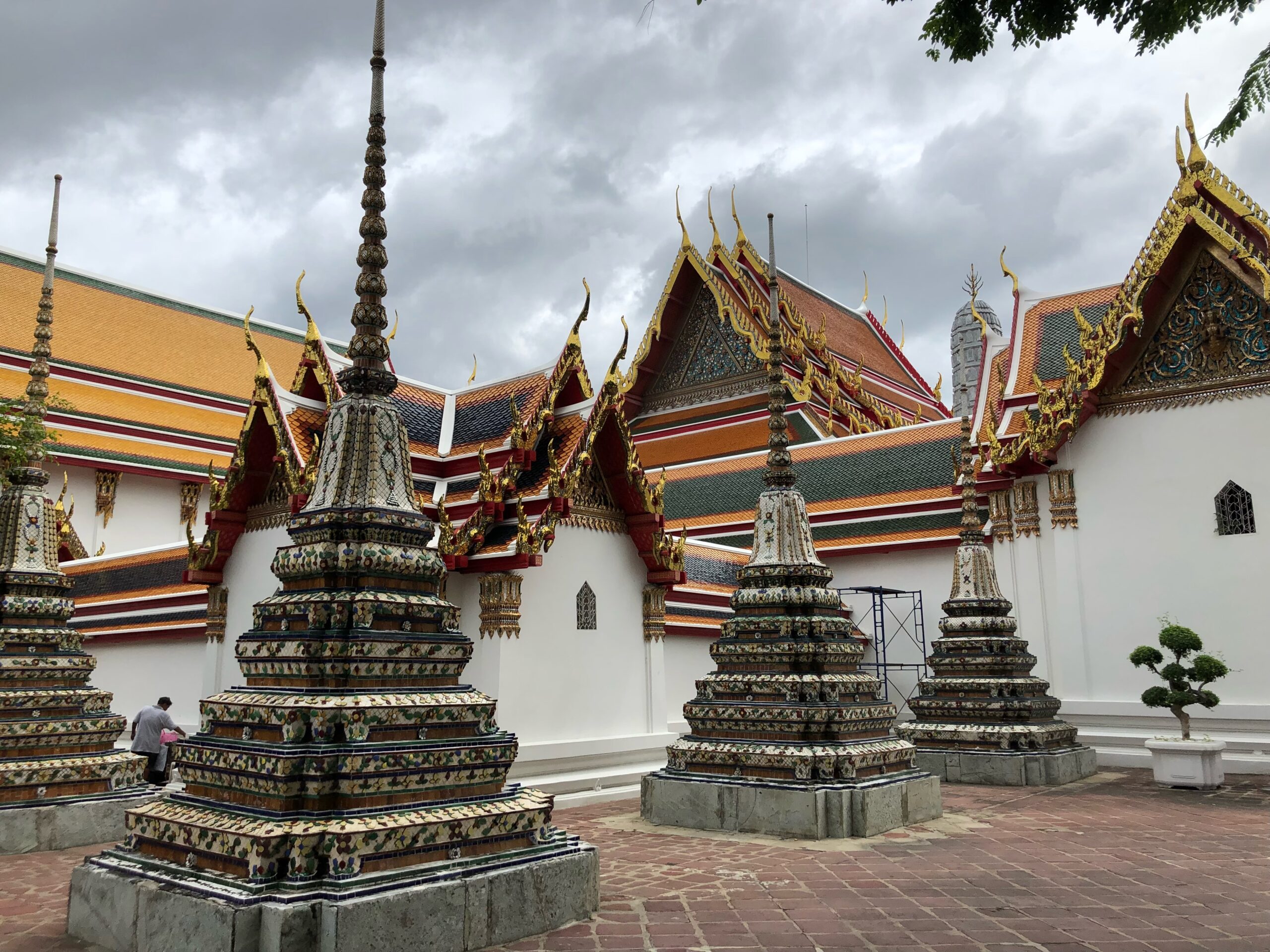
In addition to the four royal chedi, there are also 91 smaller chedi scattered throughout the temple. These mostly contain the ashes of minor princes and princesses. The line to see the reclining Buddha is long, but the rest of Wat Pho is peaceful and sadly left unexplored. There seems to be an impulse to rush in, snap a photo with the Buddha and dash, but I highly recommend exploring the entire grounds.
Stone Giants
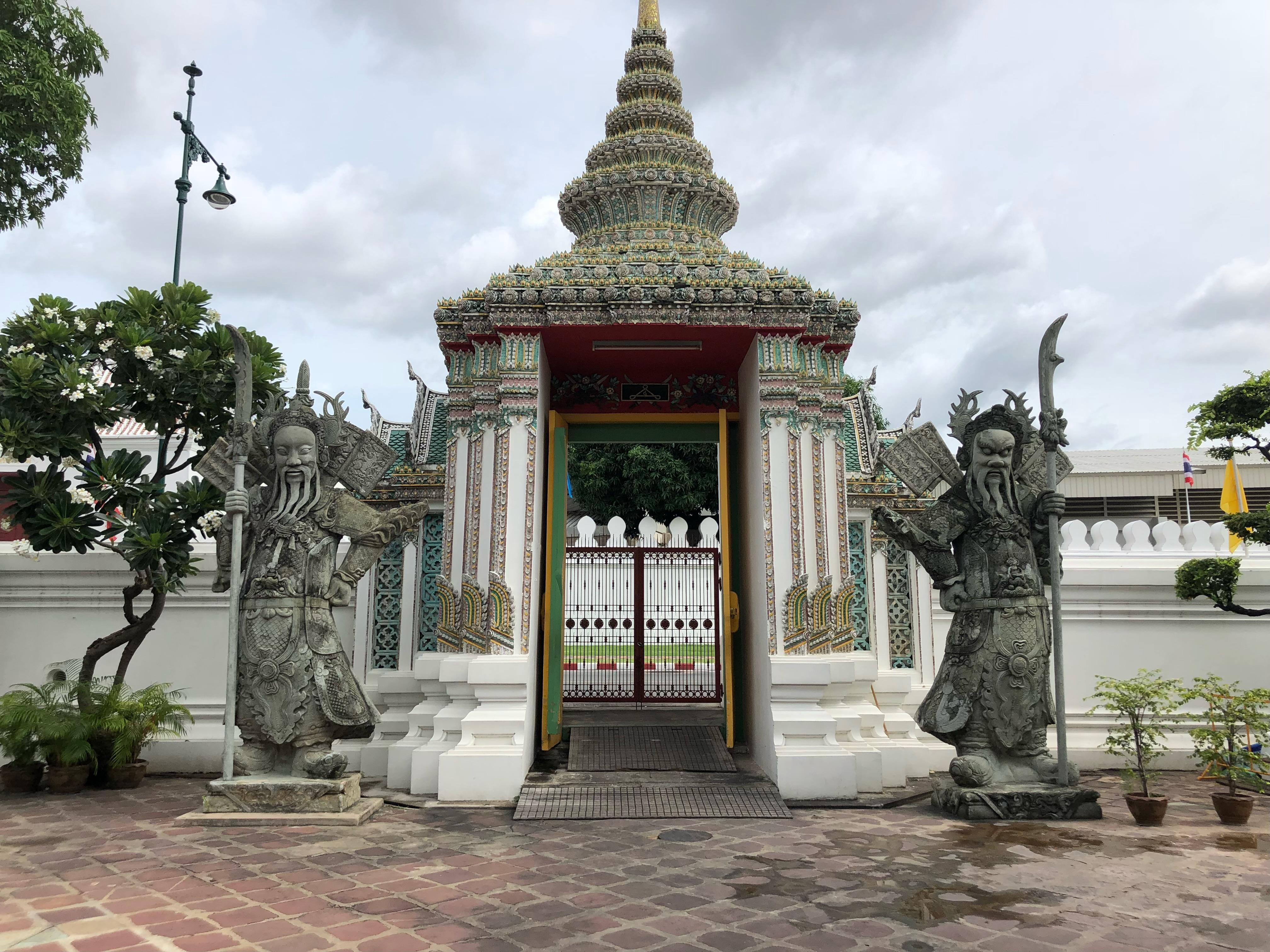
Like at the Grand Palace, Wat Pho also has a collection of Chinese “Stone Giants” guarding the entry and exit portals. These characters are straight out of Chinese opera- too bad they can’t sing too!
Phra Ubosot
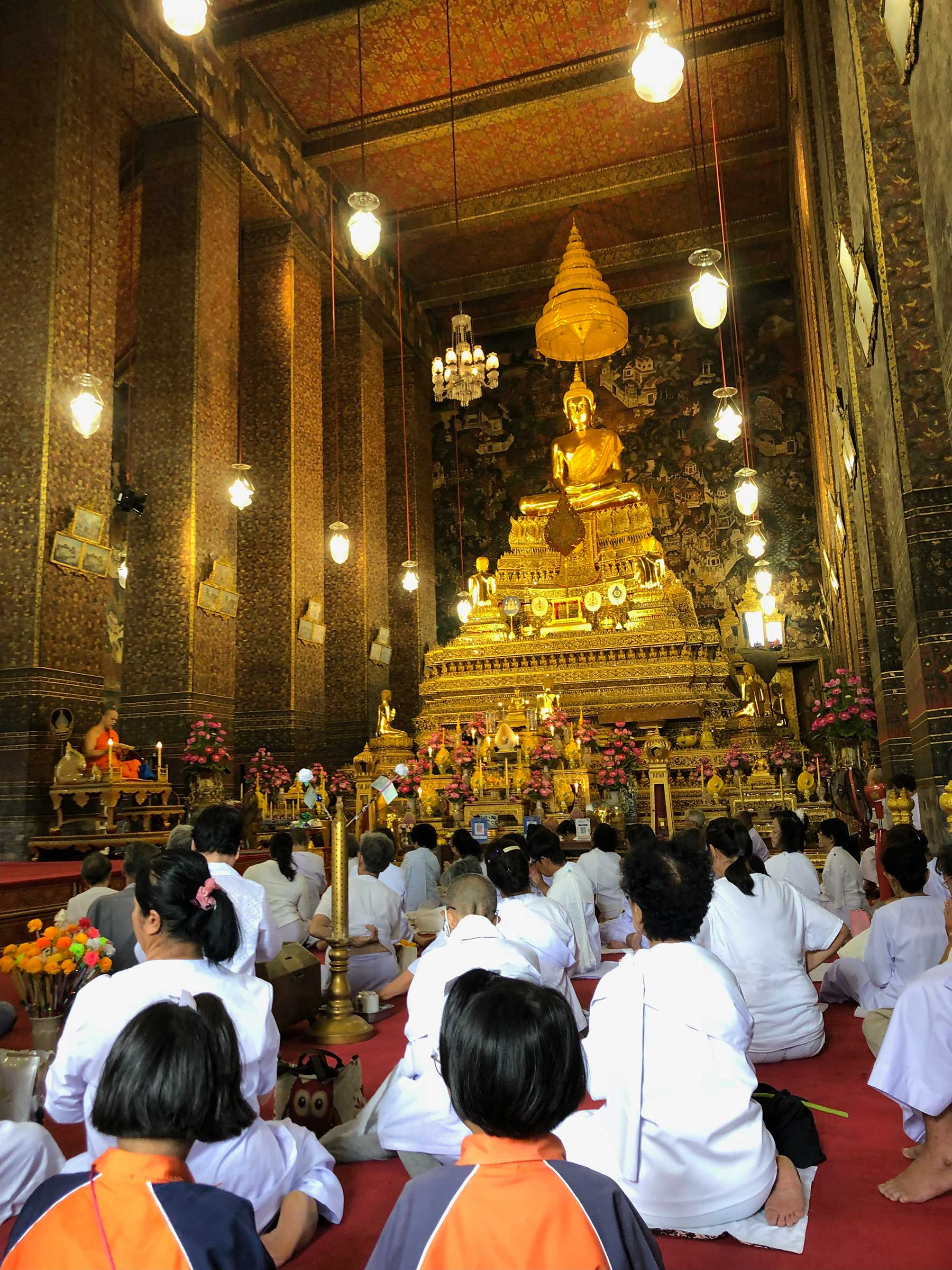
Here is a Buddhist sermon taking place inside Phra Ubosot, the central chapel at Wat Pho. The monk who is seated on a platform to left is giving the sermon and the worshippers are seated on the floor with their shoes off. You must never point the soles of your feet towards the Buddha, so find a comfortable position with your knees facing forward instead. This Buddha holds the ashes of Rama I himself, allowing the people to honor their first king and pray to the Buddha at the same time.
The National Museum
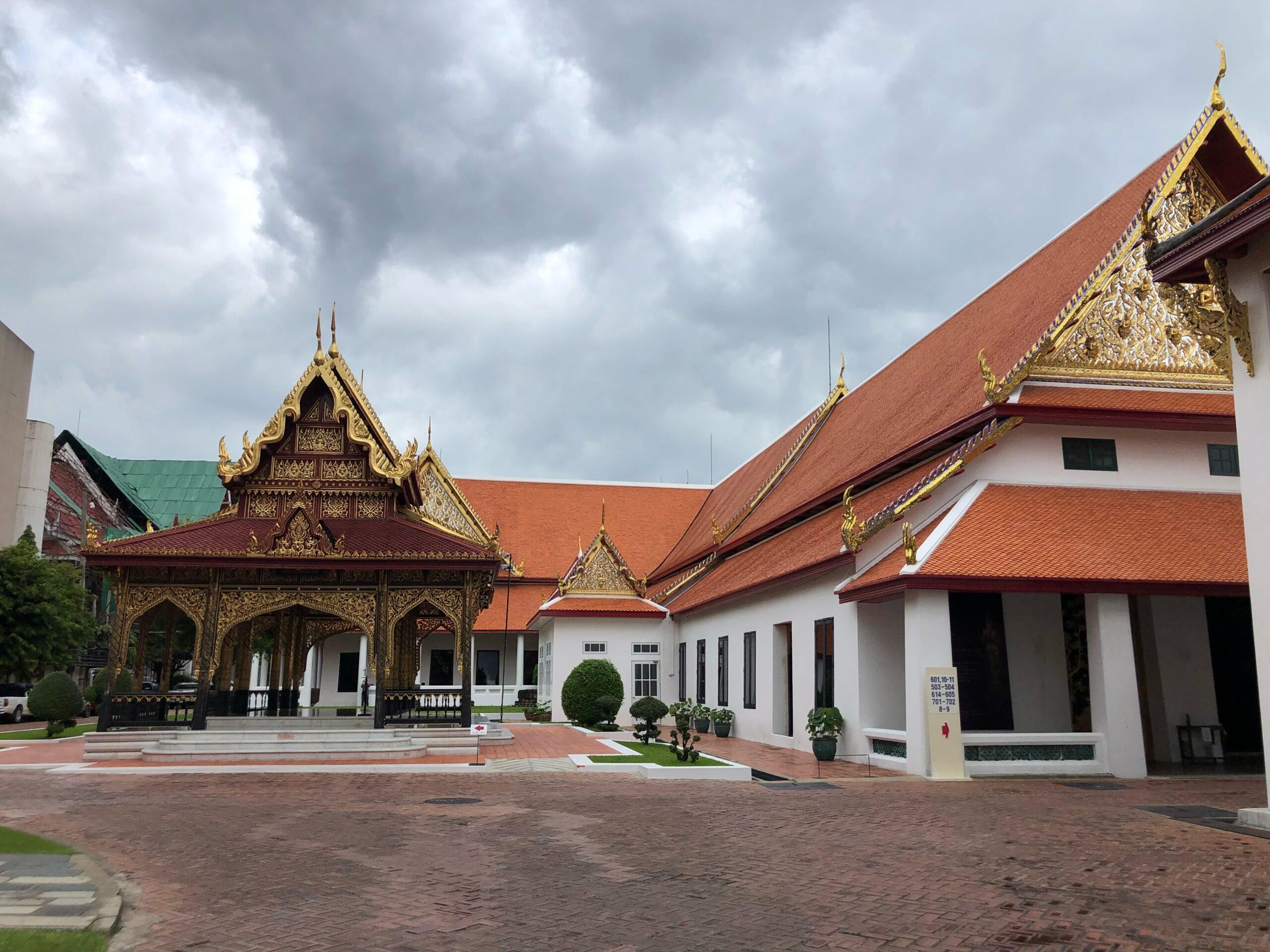
It makes sense logistically to visit the Grand Palace first thing in the morning. You beat the crowds and are free to explore the labyrinth of buildings unfettered from the clamoring throng. And yet, if I’m really being honest, the place you should actually visit first in the National Museum. I was taught basically nothing about Thailand in high school and I only tangentially learned about the country through some Buddhism classes I took in college. I was in desperate need of some historical backdrop and the National Museum did not disappoint. Recently reopened after almost a decade’s worth of modernization, the museum’s exhibits are now fully translated into English and have been brought into the 21st Century with fancy multi-media displays.
The museum is quite large, comprised of 13 buildings and over 30 exhibition halls. Originally built in 1782 for Rama I’s viceroy, or deputy king, The Palace of the Front, as it was known, was born. In 1887, Rama V officially handed it over to the fine arts department and formally declared it the National Museum. The exhibits are divided into three sections: Thai history, decorative arts and ethnography and fine arts and architecture. (Was this museum created just for me, or what?!)
The Red House
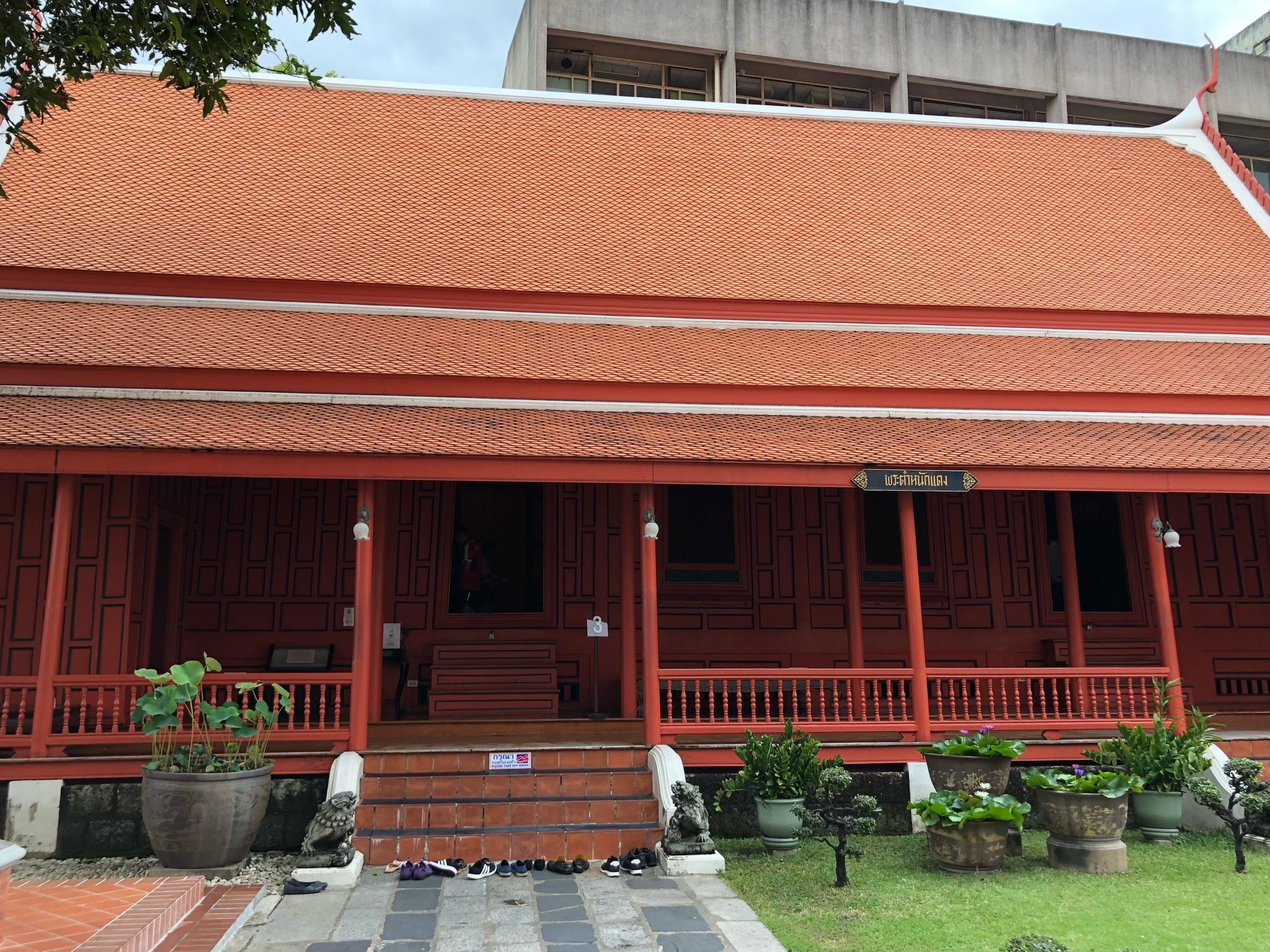
Before getting into the museum proper, be sure to visit The Red House, a traditional Thai teakwood house transported from the Grand Palace to the museum grounds. The dwelling was built for Rama I’s sister, before it became the residence of Rama II’s wife. This is what a typical family house would look like in the early-Bangkok style and the Queen’s possession can be seen, arranged as they would have been at the time.
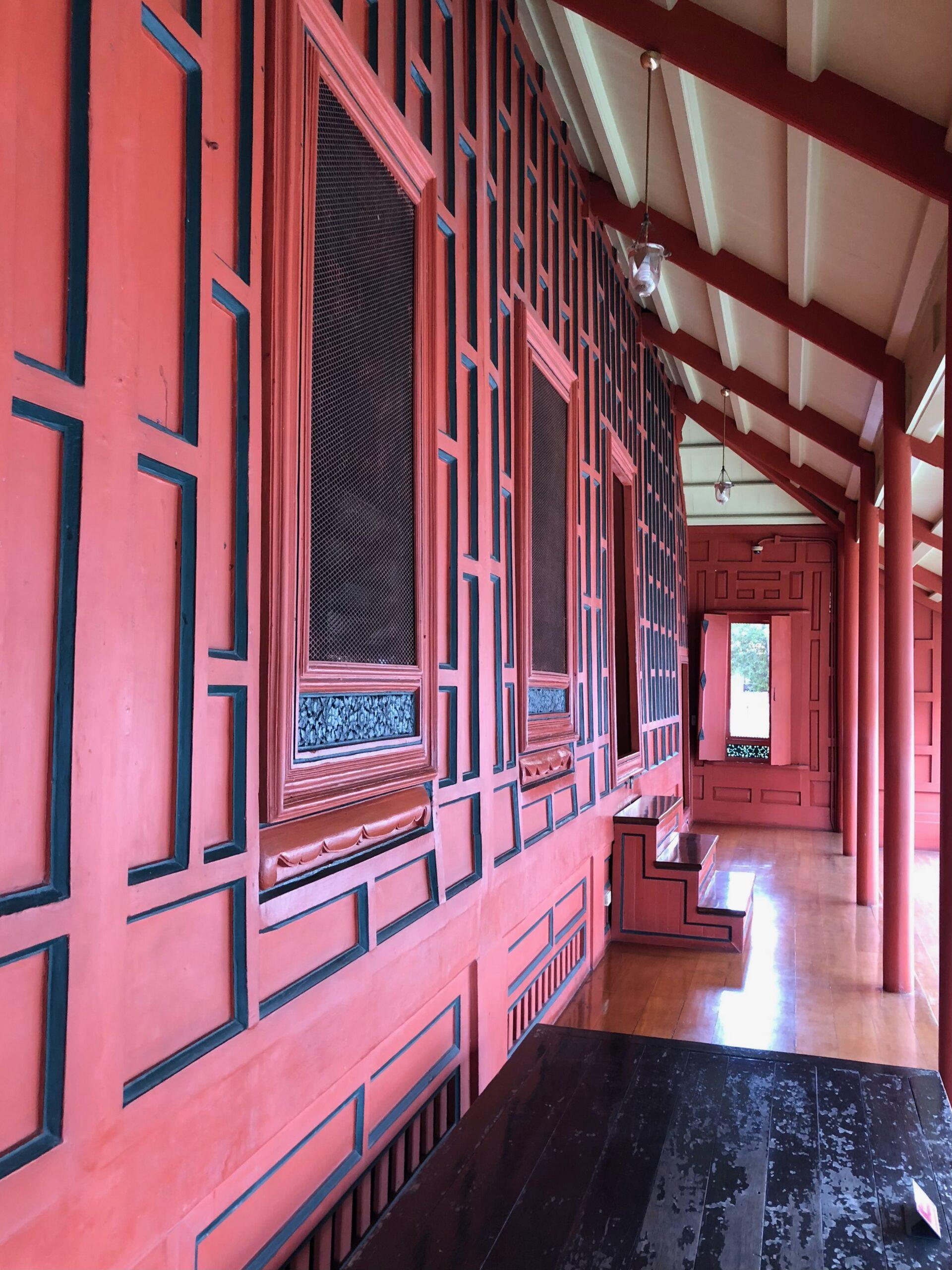
The Gallery of Thai History
So far, I’ve been mentioning the kings of the Chakri Dynastry (Rama I-Rama X), but Thailand’s history began much before that and they’re centering the country around Bangkok. Although various nomadic peoples lived in the region now known as Thailand, its modern history truly began in 1238 with the founding of the Sukhothai Kingdom. It was during this time that the Thai alphabet was created and the language began to codify. Concurrently, two other Thai kingdoms arose, Lan Na to the north with it’s capital of Chiang Mai, and Ayutthaya to the south, it’s capital (of the same name) a mighty island, and easy to defend. The Sukhothai Kingdom was absorbed into Ayutthaya in 1438 and Lan Na was conquered by the Burmese in 1558.
The newly-expanded Ayutthaya prospered immensely. Trade relations with the Dutch and Portuguese brought great wealth to the kingdom and a golden age of literature, art and medicine had dawned. This is also when Thailand picked up the name Siam after a Dutch newspaper inadvertently referred to the nation as such. Somehow Siam stuck for hundreds of years.
Tensions between the Burmese occupied Lan Na and Ayutthaya increased. Following a bloody siege, after 400 years, the Burmese broke through the capital’s defenses and burned Ayutthaya city to the ground in 1767.
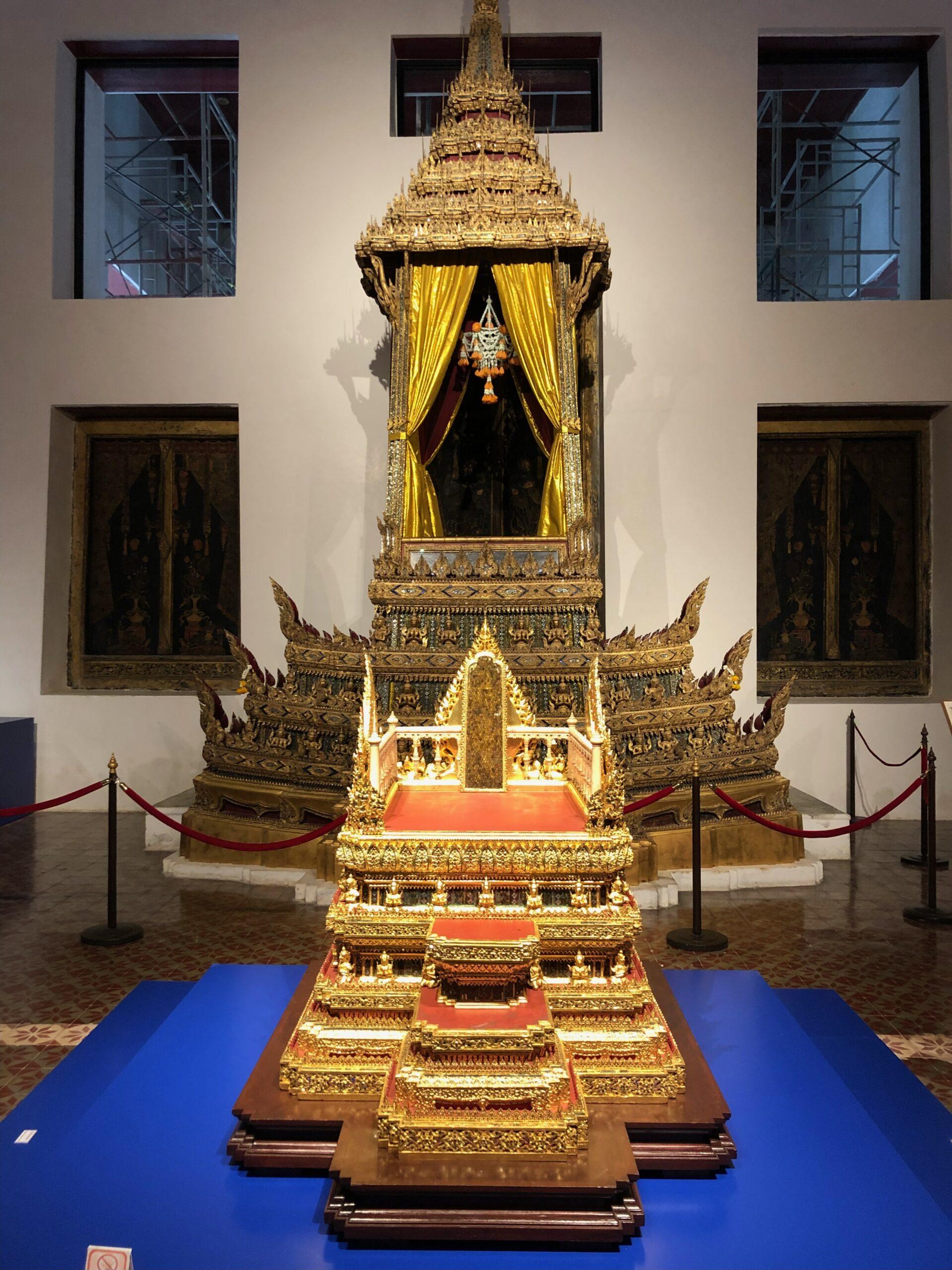
The Siamese, as they were now called, regrouped remarkably quickly under the leadership of King Taksin the Great, who founded a new capital in Thonburi, now the western bank of Bangkok. In lightening-fast time, Taksin freed the Burmese-held lands and unified Lan Na, Sukhothai and Ayutthaya into what we basically think of as Thailand today. Taksin was the first and only king of Thonburi; he was overthrown and beheaded in a coup d’etat by one of his generals, who moved the capital across the river to Bangkok in 1782 and installed himself as King Rama I.
Siam was the only country in Southeast Asia not be colonized by a European power. By the 1890s, France had taken control of Vietnam, Cambodia and Laos and Britain ruled India, Sri Lanka, Burma and Malaysia. The French and British agreed to leave Siam alone and allow it to be a buffer zone of neutrality between the two colonial super powers (how benevolent of them, he said sarcastically). In exchange, Siam conceded bits of territory to both powers and by 1910, its borders became what they are today.
When World War I broke out, Siam sided with the Allies and declared war on Germany. In the 1930s, the Great Depression hit Siam hard and in 1932 the Siamese Revolution brought about the fall of the absolute monarchy and established a constitutional monarchy in its place. The king would still be the king, but he was stripped of many powers and a National Assembly and Prime Minister post were formed.
In 1939, Siam officially changed its name to Thailand, but Thailand’s luck was about to take a turn of the worse. When Japan entered World War II on the side of the Axis powers, they occupied Thailand and installed a puppet government that declared war on the US and Britain. After the war, the Allies occupied Thailand, allowing the US in particular to develop deep bonds in the Thai government. (The US helped facilitate Thailand’s acceptance in the United Nations in 1946, but no favor is performed for free…)
The US was gearing up for war with Vietnam and they needed an ally and place to station their troops in the region. Democracy was but a dream in Thailand as the US backed military dictatorship after military dictatorship in exchange for free reign to deploy American troops from Thailand. This lead to student protests that were violently shut down in the 1970s and much civil unrest. It wasn’t until 1992 that democratic elections were finally held in Thailand once again.
The backdrop to all of this modern history was the reign of Rama IX, Thailand’s most beloved king. He’s the third longest ruling monarch in world history behind Queen Elizabeth II and Louis XIV, assuming the throne in 1946 and ruling until his death in 2016. In his 70 years as king, he saw 30 different prime ministers come and go. Although he technically had little political power, it was his charisma and likability that held the country and its people together. He held sway over the court of public opinion and savvy prime ministers would play into that.
Rama IX rarely meddled in politics, but he ultimately did in 1991, as two military leaders were vying for power and the country was on the brink of civil war. He called both generals to appear before him on national television and the image of the two men kneeling before the king caused the people to realize who was truly in charge. Free elections were held the following year and the rest is history. (Rama X, Rama IX’s son, became king in 2017.)
Royal Funeral Chariots Gallery
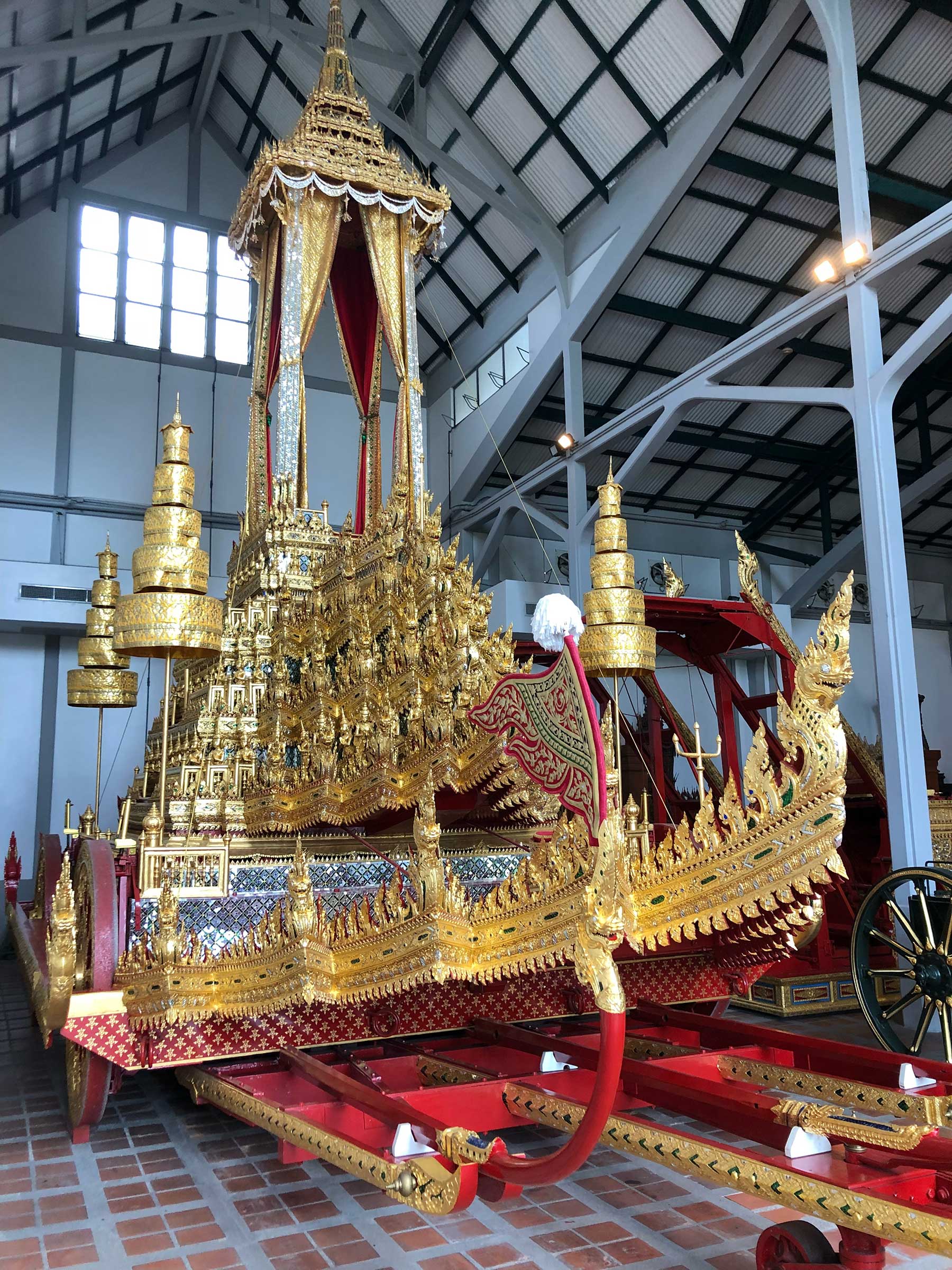
Believing in reincarnation, most Thai people are cremated and not buried. This goes for royalty as well, but when you’re a king or queen, you get to have your ashes paraded through the streets of Bangkok. The National Museum has a collection of the past royal chariots, including this one above built for Rama I in 1795. It weighs 13.7 tons and took 216 people to drag it along the funeral route.
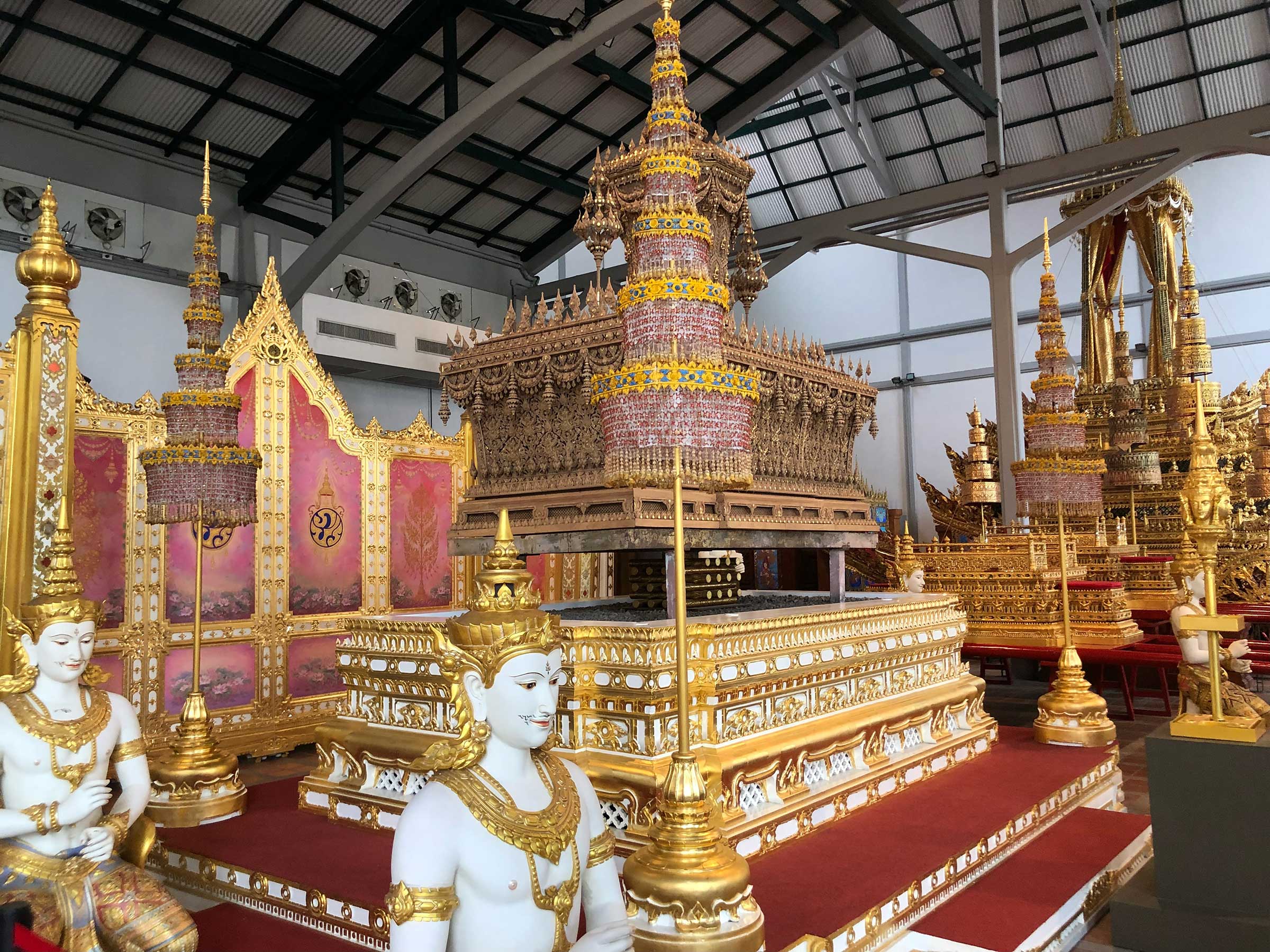
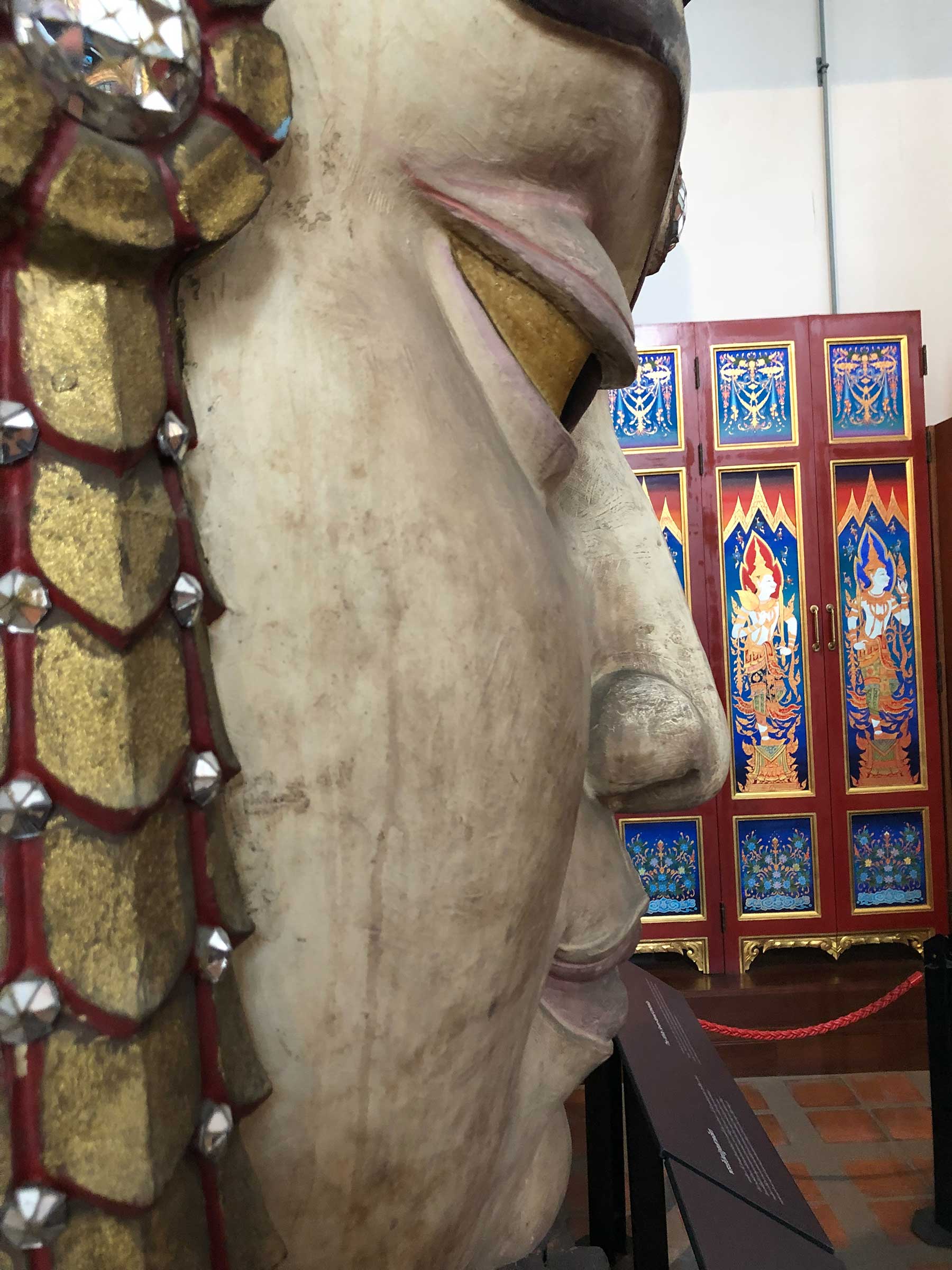
Decorative Arts
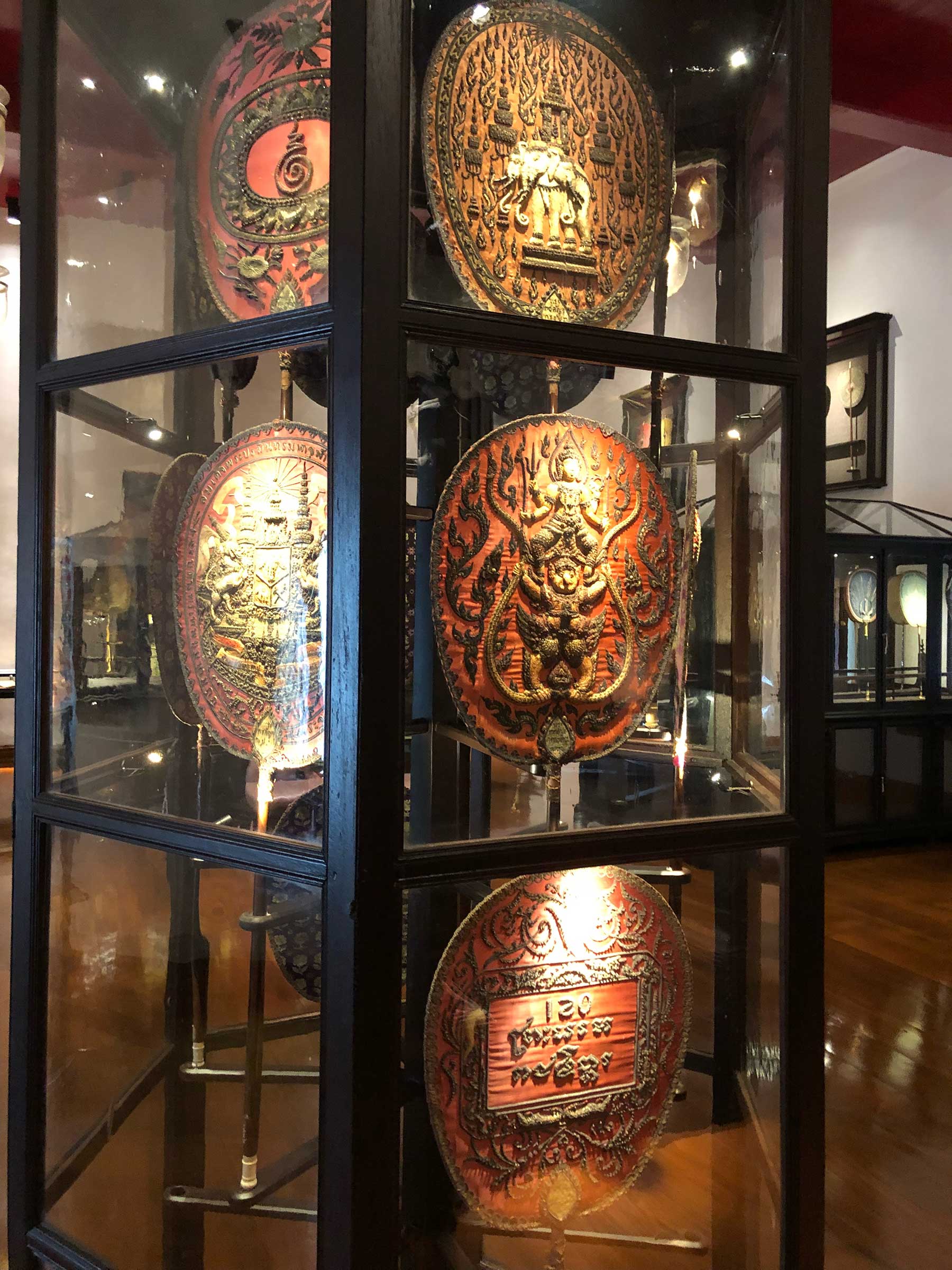
These bespoke fans were commissioned by royalty to give to monks who excelled in their studies and rose in rank at their temples. The fans were seen as an incentive to do well and once received, could be utilized during special ceremonies.
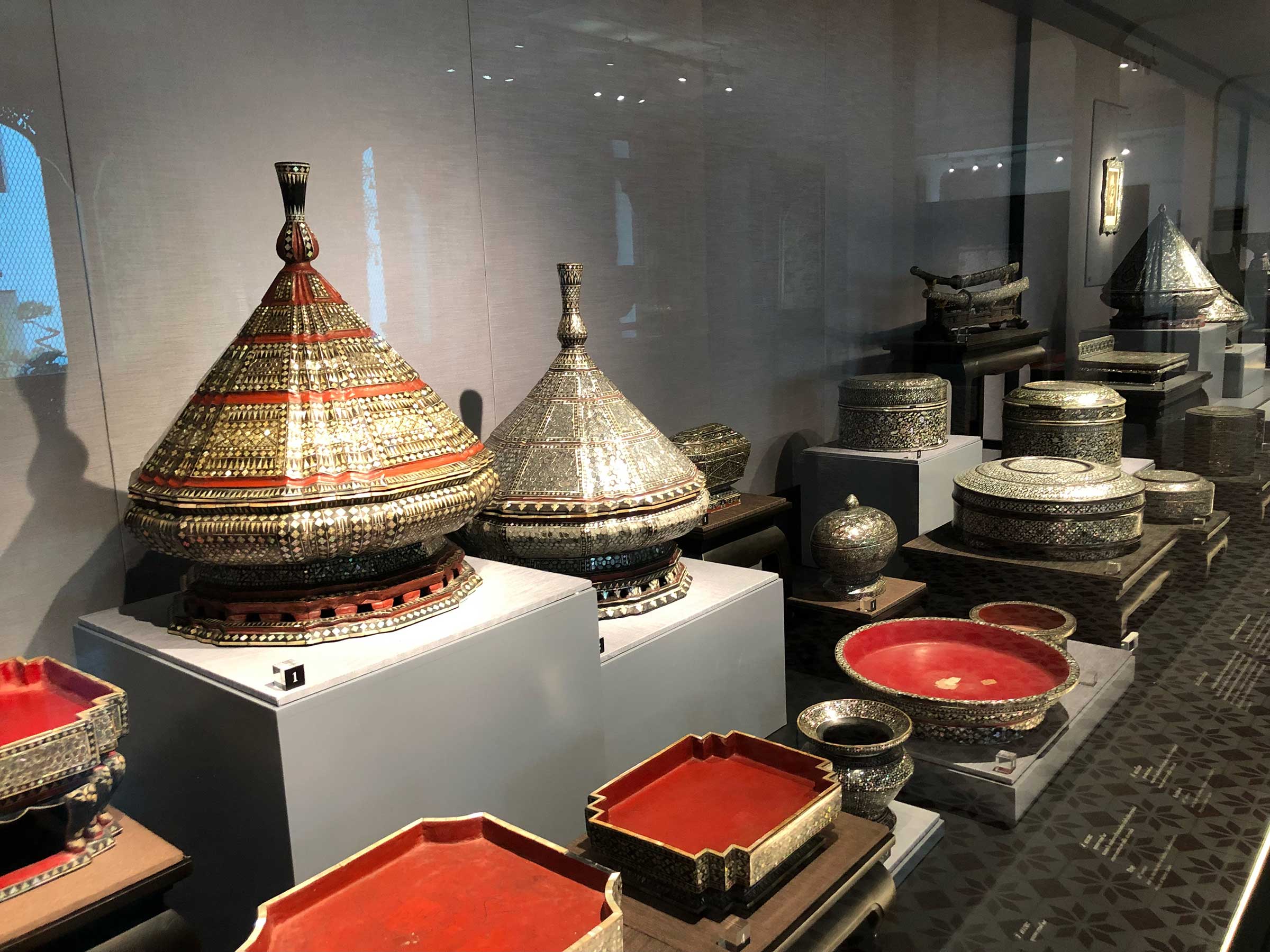
Mother-of-Pearl inlays are created by slicing the inside of seashells into thin strips and then arrange them in pottery, wood, metal or other mediums. The Thai people have become famous for their Mother-of-Pearl handiwork; you can purchase anything from small trinkets to expensive bookshelves that showcase this technique in markets around the country. The National Museum has a large collection of Mother-of-Pearl items going back to the time of Rama I.
Three sights in one day. Not so bad, right? While exploring Ratanakosin is the perfect introduction to Bangkok, don’t come unprepared for all the walking and piles of information that will be shoveled into your brain. The Grand Palace, Wat Pho and National Museum can delight, but they can also overwhelm. Looking back, I’m not quite sure how I balanced my jet lag, the rainy season weather and my desire to see as much of Bangkok as I could in relatively short amount of time. The main key is to pace yourself. If you need to stop for a snack, do so. If you want to relax for twenty minutes in the gardens of Wat Pho, do so. If you’re exhausted and want to head back to your hostel early for an afternoon nap, do so. Part of the glory of solo travel is you aren’t following anyone else’s schedule and you’re free to explore what you want at your own leisure.
